
* A Distributed Proofreaders Canada eBook *
This eBook is made available at no cost and with very few restrictions. These restrictions apply only if (1) you make a change in the eBook (other than alteration for different display devices), or (2) you are making commercial use of the eBook. If either of these conditions applies, please contact a https://www.fadedpage.com administrator before proceeding. Thousands more FREE eBooks are available at https://www.fadedpage.com.
This work is in the Canadian public domain, but may be under copyright in some countries. If you live outside Canada, check your country's copyright laws. IF THE BOOK IS UNDER COPYRIGHT IN YOUR COUNTRY, DO NOT DOWNLOAD OR REDISTRIBUTE THIS FILE.
Title: The Pacific
Date of first publication: 1931
Author: Stanley Reginald Harry Rogers (1887-1961)
Illustrator: Stanley Reginald Harry Rogers (1887-1961)
Date first posted: June 26, 2023
Date last updated: June 26, 2023
Faded Page eBook #20230633
This eBook was produced by: Al Haines, Howard Ross & the online Distributed Proofreaders Canada team at https://www.pgdpcanada.net

THE PACIFIC
By the Same Author
SHIPS AND SAILORS
TALES OF THE SEA
Illustrated. Demy 8vo, 304 pages.
“There are legends. There are adventures stranger than legend. Shipwrecks, mutinies, great sea-fights, journeys, pirates, treasure-ships, all find a place here. Mr Rogers retells the grand old yarns and draws his own illustrations with a sailor’s gusto.”—The Observer.
SEA-LORE
Illustrated. Demy 8vo, 262 pages.
“A positive treasury of information about ships, seamen, marine customs, escapades, and adventures in the days of sail, set forth in a non-technical and most readable style. Delightfully stimulating.”—Daily Telegraph.
THE ATLANTIC
Illustrated. Demy 8vo, 244 pages.
“Crammed with interesting simple facts. If you begin reading his accounts of crossings before 1840, the trade winds, ship mutinies, unsolved ocean mysteries, and the marvellous passages of white-winged ‘clippers’—Romance will undoubtedly help the facts in keeping you out of bed until Mr Rogers’ book is laid down, finished.”—The News-Chronicle.

THE SOUTH SEAS
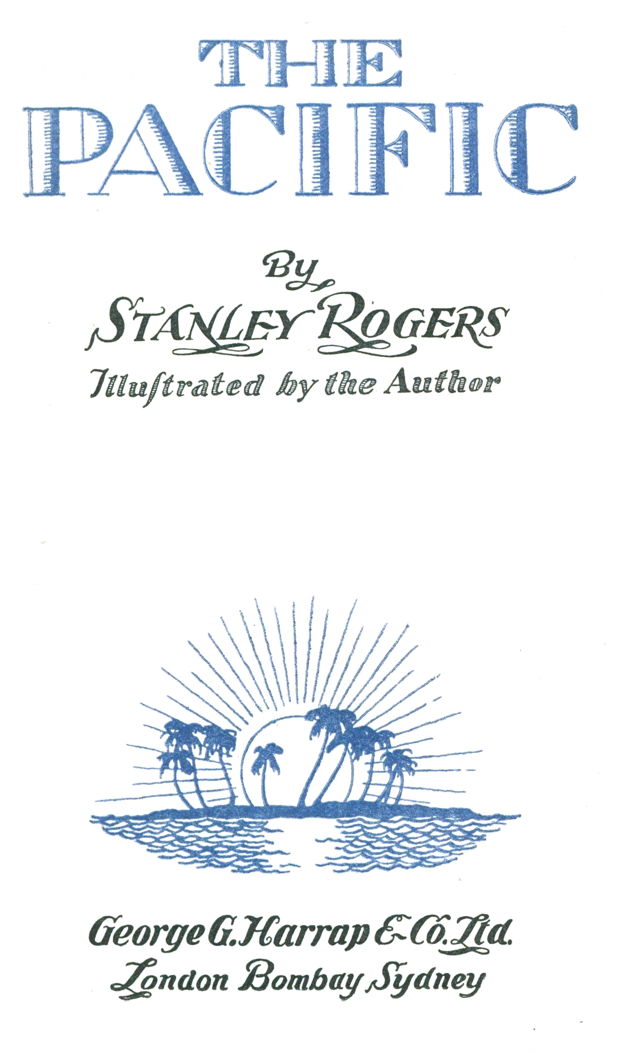
First published 1931
by George G. Harrap & Co. Ltd.
39-41 Parker Street, Kingsway, London, W.C.2
Printed in Great Britain by Unwin Brothers, Limited,
London and Woking.
TO
MY SISTER QUEENIE
After writing three books on the sea I felt it was enough. A trilogy makes a good round number, and why disturb the balance by adding to it a fourth volume? But when the last of the trio—The Atlantic—appeared it was suggested that as a pendant to it I should do a volume on the Pacific. Certainly the notion appealed to me, especially as I had spent the early, formative years of my life on the Pacific coast of North America, and have, shall I say, a lingering sentiment for those distant parts.
As a boy in the late nineties I was taken on board windjammers in the Puget Sound by my father, who had business with the captains. There was something unforgettably romantic about those visits: the tiny cabins and the strange, big men who lived in them held me in a half-fearful fascination. Those bearded sea captains had come from places as distant as the ends of the rainbow; they spoke, many of them, in gruff, broken English, and their clothes were not as our clothes. They had come to get pine and fir lumber, and wheat; and had brought rice, pineapples, and jute from Asia and the South Seas. They had been at sea for months, would remain in port only long enough to secure a cargo, and then be away again to Yokohama, Valparaiso, or some other place which lay an incredible distance beyond the horizon.
Now, in the nineteen-thirties, over thirty years later, I am sitting by a lofty window overlooking the London River, writing the foreword to a book about the Pacific Ocean. Much water has passed under London Bridge and many changes have come over the world since those far-off days when the tall masts of square-rigged ships, towering over the warehouses of Olympia, Tacoma, and Seattle, were a common sight. The little boy who sat on the red plush settee in the cabin of the Talofa, looking open-mouthed at a model of that very ship, has become a man, and the ship herself foundered in the South Pacific thirty years ago. The windjammers no longer call at Seattle and Portland; their place has been taken by rusty freighters, and the old wooden water-front buildings are no more.
The book is finished. I have covered a large field—as large as the Pacific Ocean, in fact—and no pretence is made of dealing fully with any one subject. The bibliography of the Pacific is legion, and specialized information can be obtained without much difficulty by those who seek it. Mine has been the rôle of a bird of passage, one who is content to skim lightly over the seas—tarrying here and there for a while and passing on. Reader, do thou likewise.
S. R. H. R.
Wapping
1930
| CHAPTER | PAGE | |
| I. | The Pacific | 13 |
| II. | Pacific Navigators | 32 |
| III. | Pacific Privateers | 55 |
| IV. | Pacific Isles | 82 |
| V. | Polynesia | 106 |
| VI. | Pacific Merchant Shipping | 131 |
| VII. | The Literary Pacific | 157 |
| VIII. | The Language of the Pacific | 177 |
| IX. | Pacific Adventure | 194 |
| X. | Pacific Shipwreck | 217 |
| Index | 249 | |
THE PACIFIC
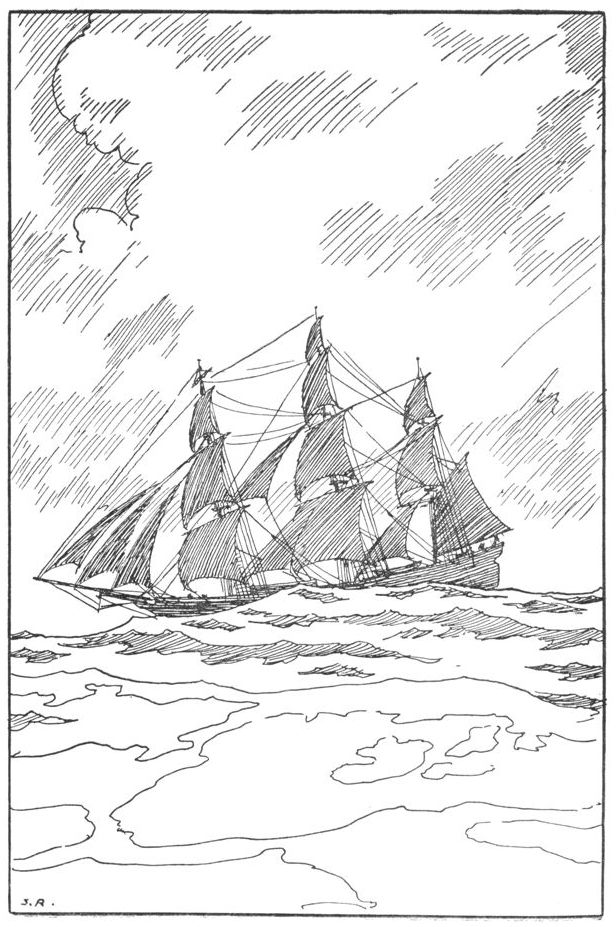

When Balboa, from a hill-top in Panama, gazed on the Pacific and claimed it for Spain in the name of Castile and Aragon he had no idea of the extent of the stretch of water he looked upon. He could not know the magnificent impudence of the gesture in claiming for Spain the largest area of water in the world, an ocean exceeding in size all the land surfaces put together; an ocean about seventy million square miles in extent, and, if comparisons are helpful, let us say twice the size of the Atlantic. This is what, with one sublime gesture, Balboa gave to Spain. He called it “the South Sea,” which was no more appropriate than “the Pacific,” the name which Magellan gave to it seven years later. But Magellan, finding it calm after a stormy passage through the strait which bears his name, called it Mar Pacifico, and thanked God for a safe deliverance into this tranquil sea. It is, however, neither more south nor more pacific than any other ocean, as the early venturers upon it were to discover soon enough.
The Pacific is an ocean of appalling distances, a wilderness of water beyond the power of imagining. It has a width of 10,000 miles at the equator, and nearly that much from the Bering Strait to the Antarctic Circle. It is also an ocean of tremendous depths, the sea-floor being in some places over 5000 fathoms (30,000 feet) below the surface. These enormous depressions in the sea-bed are known as deeps, all of which have been accurately charted and plumbed. During cable-laying the deeps are a source of considerable anxiety, as the added depth may subject the cable to a greater strain than it can support. From Bamfield, British Columbia, to Fanning Island, north of the equator—3500 miles away—stretches the longest submarine cable in the world. The Pacific is the ocean of superlatives.
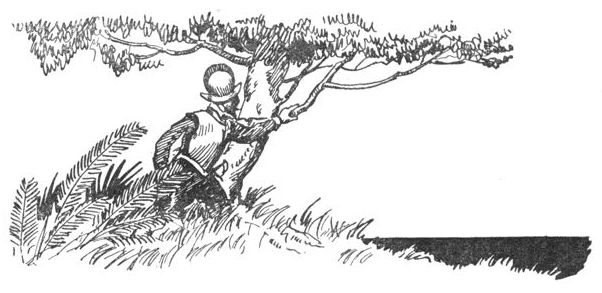
“UPON A PEAK IN DARIEN”
The Pacific has certain definite ocean- and wind-currents which are the counterpart of those of the Atlantic. For instance, the Pacific has its Doldrums, an area stretching away to the westward from the coast of Central America where there are, for long periods, no winds at all. Before these wind-currents were properly understood the Spanish treasure galleons, running from Manila to Acapulco, in Mexico, to escape the trade winds which were against them, would edge northward until, peradventure, they got into the area of calm. At the end of a long passage from Asia, with the ship short of provisions and water, such an enforced delay often meant disaster to her and her company. It was not unknown for a vessel to be found in this area, her sails idle, her rotting hull blistered and cracked by the sun, and her crew all dead.
The prevailing winds of the Pacific between the Tropics of Cancer and Capricorn blow toward Asia, but in the higher southern latitudes—say between 40° and 50°—a continuous westerly gale blows round the world. Hence, to enter the Pacific by way of Cape Horn meant arduous beating against these winds, but to enter the Pacific via the Cape of Good Hope meant running before the wind. These gales are the famous Roaring Forties, and, running eastward in these latitudes, the old clipper-ships made passages that would do credit to a steamship. In March 1853 the American clipper Sovereign of the Seas on a passage from Honolulu to New York, when in 49° S., for twelve days averaged no less than 311 miles a day. Her best day’s run was 411 miles.
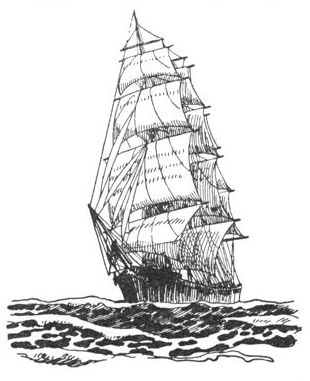
THE “SOVEREIGN OF THE SEAS”
The Pacific is the ocean of the future; some day it may be the centre of world affairs. Before the cutting of the Panama Canal it was, in a sense, isolated from Europe by the tremendous barrier of the two Americas. The Pacific was too far away, too inaccessible, to claim the serious interest of the European Governments, hitherto the only Powers to be reckoned with. The prediction that future world affairs will centre in the Pacific was made seventy-five years ago by a great statesman, and, though it has not yet been fulfilled, it must inevitably come to pass. Because of its remoteness from the centres of civilization, Pacific shipping, until modern times, was a trifling affair compared with the ocean commerce of the Atlantic. Save for the Yankee whalers and the California clippers of the fifties and sixties, Pacific trade was almost negligible. But the opening of the Panama Canal has brought an enormous increase in ocean traffic and trade. And just as the opening of the Suez Canal reacted against Cape Town and the island of St Helena, so, one feels, the Panama Canal must have a like effect on the ports of South America. Ships are no longer forced to make the tedious and perilous passage round the Horn to get to the west coast, and for a while the South American republics in the south must feel a sense of isolation, though in time, as the world grows more populated and transport becomes cheaper and more rapid, South America will be as close to Europe as Egypt is to-day, or perhaps closer. To people in London or New York Punta Arenas and Valparaiso seem a long way off, and Pitcairn might as well be on the moon. In the old, leisurely sailing days, when ships, to pick up a wind, would zigzag all over the ocean, lonely isles were quite busy places, with whalers and other shipping coming and going all the year round. But the steamer is direct: it steers a straight course, ignoring both winds and currents, and it would be highly uneconomical to go several hundred miles out of the course to visit some benighted isle where the trade is not worth the picking. So the remote islands have become almost as remote as they were in the days of Anson and Cook.
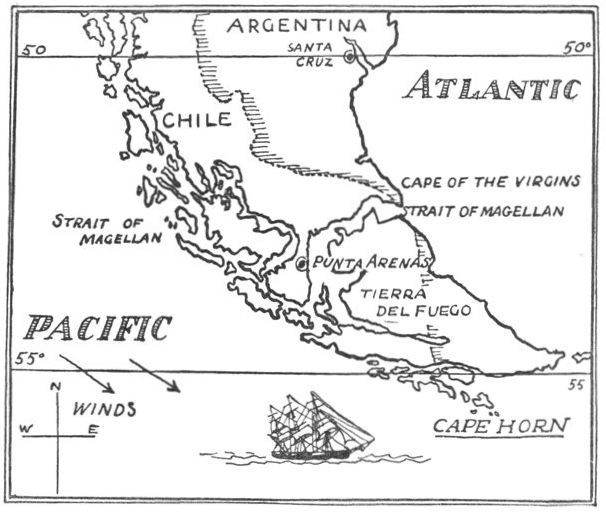
The floor of the Pacific is constantly being disturbed by subterranean disturbances, earthquakes and eruptions; hence most of these islands are volcanic rocks. The coral atolls, so characteristic of the Pacific, are among the marvels of nature, though not perhaps quite so astonishing a thing as those volcanic isles which are born in a day. From the Northern Pacific sea captains have brought home accounts of submarine earthquakes and a great commotion in the sea in which the water seemed to be boiling, and around the ship floated thousands of dead fish. Great clouds of steam would rise from the agitated surface of the ocean, and as the ship drew away vast quantities of mud and lava boil above the surface. A few hours later where there was before nothing but water would stand an island; a black, burning, smoking mass, but an island unmistakably. I have a photograph of one of these islands taken some years ago by Sir George Baden-Powell. It shows a vast black shape of sulphurous rock, not unlike Gibraltar in shape, from the sides and summit of which dense smoke billows upward, while all around its base the sea is steaming and boiling.
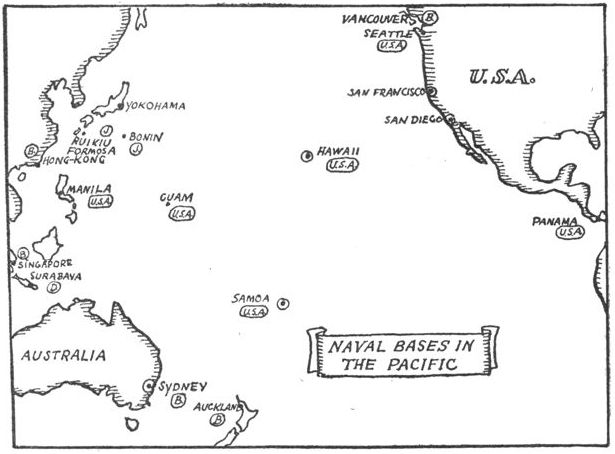
While the greater number of the Pacific islands are volcanic in origin, the minute coral animal has been responsible for some large islands in the Eastern Pacific, apart from the vast number of small atolls and islets thereabouts. The largest coral island of all is the Great Barrier Reef, which is virtually an island that is submerged at high tide. The Great Barrier Reef, extending for hundreds of miles along the northern Australian coast, is a real menace to navigation, and among its coral grottos lie the remains of scores of noble ships which have come to grief there since the days of Cook. Its coral is largely white, but there are also found masses of red, pink, deep indigo, pale heliotrope, brilliant green, and yellow coral. Here and there along this vast reef there stand above the high water a few small islands populated by sea-birds, which live their lives unmolested by men, since men give the reef a wide berth unless driven there by some necessity.
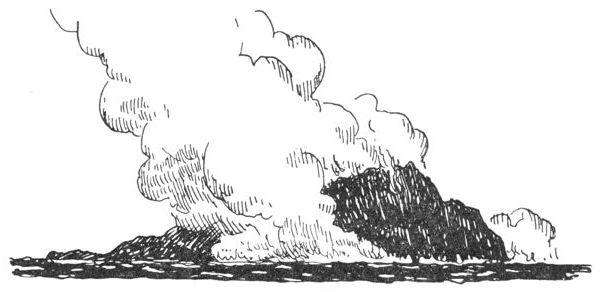
THE BIRTH OF AN ISLAND
The Reef teems with marine life; dugongs[1] and turtles abound, and through the translucent depths can be seen huge bivalves, the giant clams anchored to the coral, their shells open to trap any hapless creature that comes within the danger-zone. Here, too, pearl-shell is found by those who have the temerity to dive for it. In the season adventurous pearling luggers, manned frequently by Japanese, come to anchor over the pearling grounds. The captain keeps one eye on his diver and the other on the weather, for squalls will come up with astounding suddenness, and then he must haul up the diver willy-nilly, slip the cable, and get a safe offing to sea before the squall strikes the vessel.
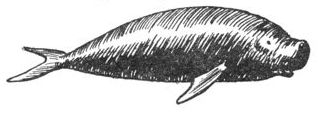
A DUGONG
In this vicinity are found most varieties of the shark family, from the little school shark, which goes about in shoals, to the huge basking shark forty feet or more long, which has been mistaken at times by imaginative sailors for a sea-serpent. There is the hammer-headed shark, a creature with a grotesque snout not unlike the head of a hammer, with the eyes on either ‘arm’ of the head. Another is the elfin shark, with a spiked horn protruding from its snout. The ground shark, which lies on the bottom in shallow water waiting to dart at its prey, is dangerous, but the most feared of all is the large man-eating shark, known locally as the white pointer and by the natives as the “hungry one.” The tiger shark, also seen in these waters, gets his name from the curious brown and buff tiger-like stripes on his body, and not, as might be supposed, from any sharkish ferocity of his own. Many of these creatures have names unknown to science; but it seems that the carpet shark, the thresher shark, the “grey nurse,” and the “hungry one” are names fitting enough, for it is by such titles, and not those in hyphenated Latin, that they are known all over the Pacific.
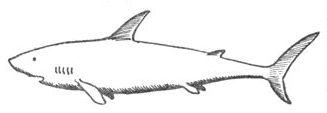
SHARK
Most sharks are so greedy that they will swallow anything, a gluttony that frequently brings them to a tragic end. A favourite method of catching them is to bait a large hook with a piece of pork and trail it overboard from the ship’s rail, when the first shark which sees it will swallow the bait. The rest may be imagined. Sailors consider sharks to be beyond the pale of mercy, and in consequence will practise on the hated creatures the most monstrous cruelties, sometimes throwing a mutilated but living shark back into the sea, where he will sooner or later be devoured by other sharks.
The natives of Polynesia do not hold the shark in such dread as do the white men. The native, invariably a splendid swimmer, will attack one of these creatures in the water, ripping it up with a knife as it turns on its back to bite its intended victim. The peculiar undershot jaw of the shark makes it necessary for the animal to turn over as it bites, and it is this manœuvre which gives the native swimmer his chance.

MAN VERSUS SHARK
Until the death of the old-fashioned whaling industry the Pacific used to be the chief haunt of the American whalers, and the ubiquity of the Yankee whalemen is vividly shown by the vast collection of trophies, brought home from the South Seas, which are exhibited in the Peabody Marine Museum at Salem, Massachusetts. Here the reader of Typee and Omoo can get his fill of local colour, for the whole of Polynesia seems to have been ransacked to form this unique collection of South Seas lore and curios.
The whalemen after a year or so at sea were allowed liberty ashore, and in exchange for worthless trinkets would obtain from the guileless Polynesians marvellous examples of native craft. Canoes, spears, shields, tapa cloth, beads, baskets, drums, carved images, and weapons were brought home in this way. The New Englanders of the forties and fifties were accustomed to seeing brown-skinned Polynesians on the waterfront of Boston, Gloucester, New Bedford, and Nantucket; these were natives who had signed on the whalers. In Nantucket, by the way, the exclusive Pacific Club was founded, a club for whalemen only, where old shellbacks forgathered to swap yarns of the South Seas and read the maritime gazettes. The Polynesians made splendid whalemen, and Melville’s Queequeg had his counterpart in real life. Their fine physique and skill in handling a boat and throwing a spear made them desirable recruits, and when a whaling captain lost half his crew through desertion (not an uncommon thing, for the sandy beaches and waving palms looked an earthly Paradise to the hard-worked whalemen) he was often glad to make good his losses with these brown-hued, laughing gods. But they suffered from the cold at sea, and many died from pneumonia and consumption. Tuberculosis has been the scourge of the Polynesian race. The people are fast dying out, and within a generation or so there may not be a pure-blooded Polynesian left. First came the uncouth sailors with their lack of morals to pervert the native, and then the Western reformers with an excess of morals to inject into their simple minds the baleful germs of prudery. The clean-limbed girls had to exchange the becoming and hygienic pareu for the ugly and unhygienic Mother Hubbard dress. The men were given trousers and coats to hide their nakedness, and self-consciousness began. When it is too late we may learn that nakedness is a relative matter: what is correct in London is immodest in Cairo, and what is a sin in Wigan may be a virtue in Tahiti. But Polynesia and Polynesians belong to a later chapter.
The two most important events in the modern history of the Pacific were the awakening of Japan and the completion of the Panama Canal. Japan’s advancement from feudal darkness to Western culture in the space of seventy years is one of the most interesting phenomena in history, and is not nearly as widely appreciated as it should be. Not that intelligent people would suggest that Japan has greatly improved during the metamorphosis; in some ways she has deteriorated, because she has adopted not only our best customs, but our worst ones also. Experience teaches a race what is most fitting for itself in culture and in art, and when it takes the culture of a totally different race it is bound to make unhappy mistakes.
Japan had, of course, been visited at long intervals by foreign ships, but to all intents and purposes the country was closed to Europeans. The land was more isolated from the world than is Tibet to-day. Every obstacle was put in the way of the curious, and no one knew much about the interior of the country or its customs. It is almost incredible that such a state of affairs could exist so long. For more than two centuries the Dutch had been trading with Japan, but the real beginning of the end of the old régime in Japan dates from 1847, when the King of Holland, whose colonies in the Dutch East Indies would, he knew, greatly benefit from less restricted intercourse with Japan, sent to the Mikado at Yedo (Tokyo) a number of books, together with a map of the world and a diplomatic letter advising him to abandon the policy of isolation. No immediate results came of this, and in 1849 a second letter was sent informing the Mikado that an American fleet was coming to Japanese waters, and unless Japan agreed to open up relations with the outside world war would be inevitable. Still the Japanese made no friendly move, and then, in 1853, Commodore Perry, of the United States Navy, with four men-of-war, entered Uraga Bay. At the sight of such a display of force the people were greatly alarmed, though the American Commodore did nothing more than deliver a letter from the President and leave, after lying in the harbour ten days. Perry himself had no power to use force; his mission was simply to deliver the Note and depart, though he informed the Japanese that he would return the following spring. After the departure of the Americans the effect of their visit began to show in the change of attitude of the Japanese. With characteristic perspicacity they realized that further resistance to the Western civilization was futile, and even showed in a guarded manner their interest in the wonders of the Western world. So when, in February 1854, Perry returned, his augmented fleet of ten ships was hardly necessary. The Mikado had already decided to sign a friendly, if somewhat restricted, treaty with the Americans. The treaty did not offer much, but it was a beginning, and for the time being the Americans were satisfied. The Mikado agreed to help foreign shipwrecked sailors (who had hitherto been treated harshly), to allow foreign ships to obtain provisions and stores at Japanese ports, and to allow American vessels to anchor in the ports of Hakodate and Shimoda. England, Holland, and Russia at once presented similar demands, which were agreed to by the Japanese, though they still refused to trade with the outside world.
However, the doors had been opened, and events marched rapidly from now on. The year 1856 saw the first American Minister to Japan—Townsend Harris, who lost no time in securing valuable privileges for his countrymen. Americans were to be allowed to reside in certain designated parts, but settlement of the larger issues, such as the opening of trade with Japan, was held up by the difficulties arising from the dual system of government, the country being ruled by the Shogun, a sort of military dictator, and the Mikado—i.e., the Emperor. The former’s Court was at Yedo, and the latter’s at Kioto. The Shogunate, being the weaker party, was the first to yield to the pressure of American importunings, and in July 1858 agreed to open Yokohama for commerce between the United States and Japan. This, of course, inflamed the conservatives, and the internal strife that followed lasted for years, the Western Powers meanwhile getting a firmer footing in the country and obtaining further concessions. In 1866 the old Shogun died, and was succeeded by Keiki, destined to be the last head of the Shogunate. A far-sighted man, he at once sent his brother to Paris to study Occidental ceremonies and fashions, and himself set about modelling the Army on European lines, as well as getting together the nucleus of a navy. The year of Japan’s real awakening was 1866. The Shogunate was abolished, the Mikado assumed full power, and throughout the land the people became imbued with the new ideas. There were reactionaries, but before the irresistible tide of Western influence they were powerless to obstruct the will of the majority. Once the Mikado and his advisers had set their hands to the Occidental plough they never looked back. From then onward they did their best to further amicable relations with Western Powers. Their progress toward Western standards, if not always for the best, has been astonishing. It is one of the major events of history. In seventy years Japan has developed from a state of bows and arrows to machine-guns, from medieval superstition to the most modern enlightenment. But whether her ancient art will survive the corruption of commercialism one cannot tell. It is the penalty of progress in a mechanical age.
The influence of the Panama Canal on the future history of the Pacific can hardly be exaggerated. Next to the opening of Japan to Western commerce the completion of the canal is the greatest happening in Pacific history. Its importance to the United States is comparable to that of the Suez Canal to Great Britain. The Panama Canal artificially provides what the old navigators sought for centuries—a quick passage into the Pacific, which was, after all, the main reason for the seeking of the North-west Passage.
When the Suez Canal, which was completed in 1869, began handsomely to repay its builders a company was formed in France for the cutting of a canal through the Isthmus of Panama, a scheme that had been discussed by visionaries for centuries. The company, with Ferdinand de Lesseps, the engineer of the Suez Canal, as president, was floated in 1880, and surveys were begun at once. The time required to build it was estimated at eight years, and the cost at 658,000,000 francs. Work was started and carried on until 1889, when the company became bankrupt through mismanagement, corruption, and extravagance on a colossal scale. New companies were formed, and more money was sunk in the Panama ditch, until the United States Government took it over and, with her superior methods, proper organization, and unlimited funds, succeeded where the French company had failed.
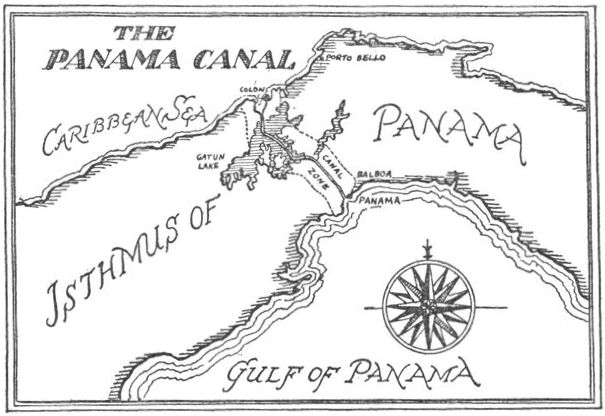
In 1904, after long-drawn-out negotiations, delayed by the instability of the Panama Governments, the United States paid 40,000,000 dollars for the derelict works of the canal, and began excavating as soon as the blasting powder, steam-shovels, and other gear could be sent to the spot. An enormous amount of preparation was necessary. Three years were required to transport the vast quantity of machinery and material to the Canal Zone, and to free the pestilential swamps from the deadly yellow fever mosquito before the main body of American workmen was sent there. Wharves and railroads had to be built, harbours dredged, workshops and houses for the workmen erected. President Roosevelt, in 1907, put Colonel Goethals, of the United States Corps of Engineers, in entire charge of the whole works, giving him supreme power, civil and military, over the entire zone, which is ten miles wide and about fifty miles long. This zone is held in perpetual control by the United States. The canal was formally opened by President Wilson on July 12, 1920, though it had been used by traffic since August 1914. The cost of its construction, including the money paid to the Panama Republic and the French company, was approximately 240,000,000 dollars, and it is hardly necessary to say it was worth it. The value of the canal cannot be estimated. From the naval point of view alone it is invaluable to the United States, which has such an enormous seaboard to patrol (California, Oregon, Washington, and Alaska are its widespread limits) so far removed from the chief naval bases on the Atlantic coast, not to speak of Hawaii and the Philippines.
The Panama Canal, by saving several weeks in the passage from the North Atlantic to the North Pacific, encourages shipping to enter waters where formerly vessels seldom went, and so is bound to play a most important part in the history of the Pacific.
|
The dugong, that strange creature, half seal and half porpoise, is supposed to have been the origin of the mermaid myth, from its habit of swimming upright in the water, the effect in the distance resembling a human head and shoulders. The Australian dugong (which is a close cousin to the manatee) attains a length of fifteen feet, and, like the walrus, which it resembles, is rich in blubber. The illustration gives an idea of its appearance. It has the horizontal tail of the marine mammalia and two rudimentary flippers for lateral balancing. Its head is remarkable for its truncated snout, which gives it an appearance of ugliness that would be hard to match anywhere else in nature. |
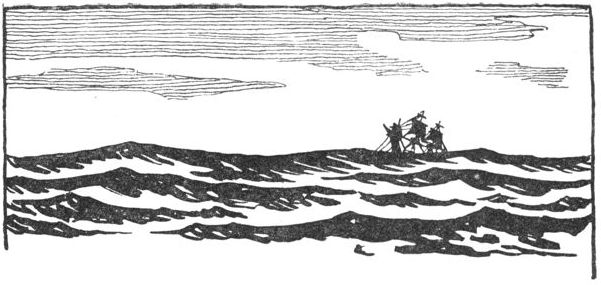
The history of Pacific exploration, so far as the white race is concerned, began with Vasco Nuñez de Balboa. When Balboa, a Spanish gentleman, settled in Hayti, went searching for the Aztec gilded man—El Dorado—in Darien he little guessed that he would find something immeasurably more valuable, something beside which El Dorado was a negligible trifle. He failed to find the gilded man, but he discovered the greatest of all oceans; and when the news of his discovery reached Spain that country lost no time in sending her ships to the South Seas, which she claimed for her own. Thus Spain got into the Pacific first, and though she has since lost the island colonies she once possessed there, the Pacific is rich in Spanish names to serve as a reminder of her great past. Mariana, Philippines, Guadalcanar, Santa Cruz, Mendaña, and San Christoval are part of Spain’s legacy to Pacific history.
When Balboa’s party, coming up behind him, saw the vast sheet of water claiming the entire western horizon, they did not at once assume it to be an ocean. It might easily be a large lake. But when, at the water’s edge, they bent down and tasted and found the water salt they knew that a great discovery had been made. This was in September
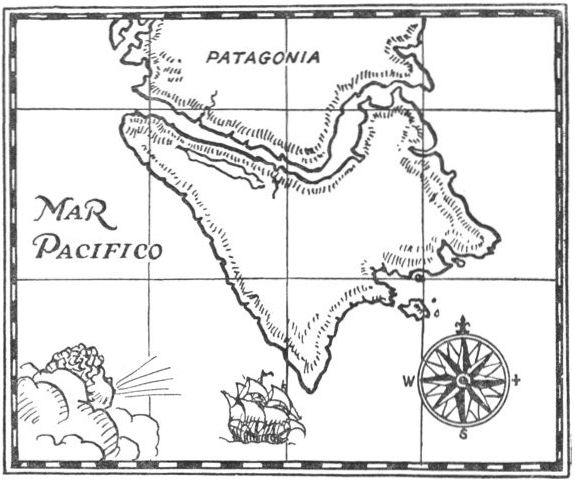
AN EARLY MAP OF CAPE HORN
Four years later Magellan, the Portuguese navigator, taking service with the King of Spain, was sent to the Pacific to search for the half-legendary Isles of Spice, known of in Europe since Marco Polo’s return from the East. It was this search for the Isles of Spice that primarily sent Spain a-sailing in the Pacific. Magellan had received a letter from a friend who was living in Ternate—a letter describing the fragrant lands of spices, of cloves, nutmegs, ginger, and cinnamon. Magellan knew that to take a Spanish ship round the Cape of Good Hope was to court trouble, as the Portuguese, considering the East Indies their own preserves since da Gama’s voyages, had barred the way into the Indian Ocean. He therefore decided to try to get round the southern end of South America. When, after a long and difficult passage across the Pacific, he arrived at the Moluccas the Portuguese settled there were astonished to learn that he had come by the western passage. Though living on the edge of the Pacific, they were unaware of its existence.
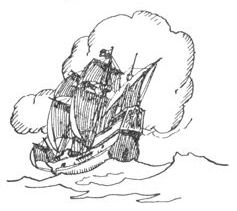
Magellan took with him as pilot in his caravel, Vittoria, one del Cano, who, after Magellan lost his life in the Philippine Islands, made a second voyage across the Pacific, only to meet with a similar fate to that of his former leader. He was killed in the Moluccas, fighting the Portuguese.
About this time the invincible Cortez and his close friend Alvar de Saavedra had a bold scheme to cut a canal through the Isthmus of Panama, anticipating by four hundred years the work which the United States Government successfully carried through. But when the tidings of Magellan’s voyage reached Cortez his thoughts turned to exploring the Pacific. Being a man of action as well as a visionary, he lost no time in equipping three ships and putting them under the leadership of Saavedra, who set out into the unknown with nothing more helpful as guidance than the fantastic charts of the period, whose cartographers appeared to pay more attention to the imaginary monsters with which they adorned their maps than the contour of the land itself.
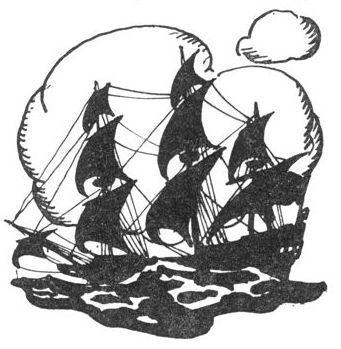
Saavedra’s vessels were typical caravels of the period (1527), lateen-rigged, with perhaps a big square sail on the main, 100 feet long—broad tubs, often undecked and cranky as a canoe in anything like a sea. But, despite poor provisions, scurvy, and incipient mutiny (what these early leaders had to contend with!), he reached the Moluccas after a passage lasting three months.
This was the actual beginning of Spain’s activities in the Pacific, though it was many years later before a regular trade was started between her colony in the Philippines and Mexico. In 1564 a Mexican expedition founded a Spanish colony in these islands, which were named the Philippines after the ruling King of Spain. The chief fort and town was named Manila, and from there began a regular yearly departure of galleons—the famous plate ships—for Acapulco. Spain grew fat with gold, but she had to send a long way for it and to pay dearly in blood and ships, especially after the English fighting devils invaded the Pacific.

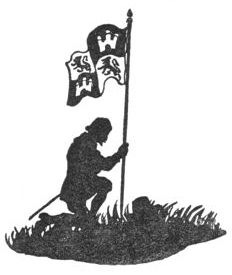
MENDAÑA
But meanwhile there was living in Peru a Spanish adventurer named Sarmiento, who had heard many exciting tales of the treasure to be found across the sea. He persuaded a noble young Spaniard to take command of an expedition consisting of two ships to sail to the Philippines and bring back as much gold as they could carry. Such was the charming credulity of men in those simple days! This young Spaniard was Alvaro de Mendaña, whose name and discoveries were destined to be written for ever in the history of the Pacific. After a passage of eighty days from Callao Mendaña came to Santa Ysabel, an island which he mistook for a continent, and thought he had found the land of Ophir, from which Solomon obtained the gold to build the Temple at Jerusalem. The islands here came therefore to be named the Solomons. But Mendaña found no gold, and returned to Peru a disappointed but undaunted man. He tried, unsuccessfully, to get ships to make another voyage. Twenty-eight years passed by, during which time Drake had been making himself feared and hated on the seas, when Mendaña, the forgotten explorer, sailed again to the West to search for the lost lands of Solomon. He had at last (1595) got the authorities to sponsor his dreams. As pilot he took Pedro de Quiros, another man destined to write his name in large letters in Pacific history. As a pilot Quiros justified the faith of his leader. He was a skilful navigator in a day when men navigated as much by instinct as by science, and after a long passage he brought the little fleet safely across. Many discoveries were made; many new islands were added to the chart. Islands of the Marquesa (later named after the Marquis of Mendoza, Viceroy of Peru) and the Ellice groups were discovered, but they failed to find the land of Ophir. Later they came upon an island paradise, the lovely Santa Cruz, and set up a colony there. Unfortunately, the Spaniards seemed ill adapted for successful colonization, and ere long the members of the colony fell to quarrelling. Mutiny and sickness broke out, and the homesick remnants of the band found their way to Manila, Mendaña died on the voyage, and Quiros stepped into the command.
Once back in Peru he raised an expedition to search for Tierra Australis, the great South Continent which many geographers believed to exist, though not in the form in which it was eventually found. With the Pope’s blessing, he sailed in 1605 with Luis Torres as pilot and three hundred men, who included missionaries as well as soldiers. The mixture may strike us as being somewhat incongruous, but in those raw days the two went well enough together. After the fleet had been many weeks at sea a number of islands appeared, and as some of them were crowned by lofty mountain peaks every one thought that at last they were gazing upon the great South Continent, and called the country whence stood these peaks by the pretentious name of Tierra Australis del Espiritu Santo, firstly after the royal house of Austria, to which belonged Spain’s King, and secondly after the Holy Ghost. This land was what we know now as the New Hebrides. Here they tarried five weeks to recuperate from the effects of the passage across, and to refill their water-casks.
On their way again to more discoveries they were overtaken by a storm, and the three ships were separated. Quiros, discovering his ship to be severely battered, decided to return to Mexico, but Torres, on finding himself separated from the other two vessels, sailed on always westward, looking for the Philippine needle in the Pacific haystack. The simile is not too far-fetched when men found and lost islands almost as we find and lose money in our pockets. Torres did not find the Philippines, but ended his voyage at New Guinea after passing through the famous straits which now bear his name. Though he was the first man to sail through the Torres Straits, he was not aware that he had done so, and it was the English who later gave them his name.
Other countries were awakening to the importance of the Pacific, and their awakening marked the beginning of Spain’s somnolence. She sent no more explorers abroad, and the days of the conquistadores were rapidly coming to an end. It was the turn of the Dutchman, the Englishman, and the Frenchman, and one at least of this international trio, the Briton, took full advantage of his opportunities. And if we concede the criticism of his rivals, that he was too belligerent, at least they in turn must admit that he is a good colonizer. His rule is never darkened by cruelty and tyranny, and native races are happy under his dominion.
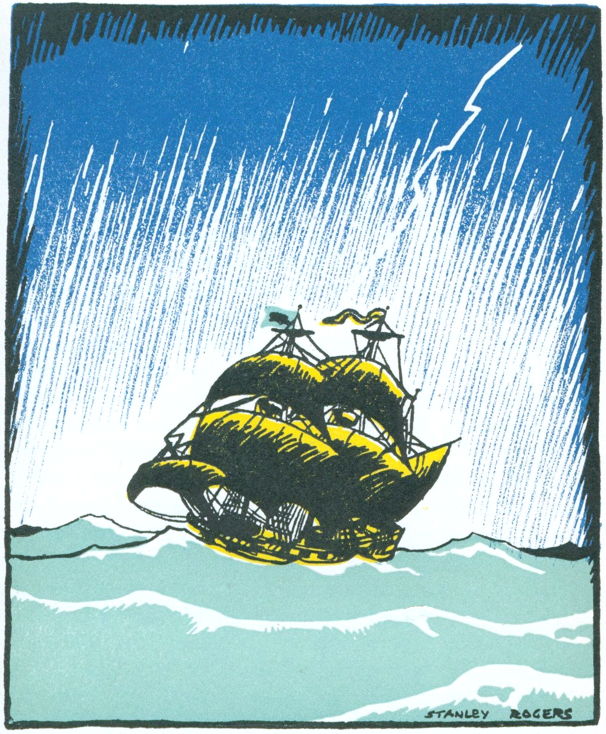
AN EARLY NAVIGATOR
Raleigh once wrote of the Dutch that, though they did not possess a large tree in their entire kingdom, they built a thousand ships every year, as many as any eleven countries in Christendom. And though their largest vessels had a shallow draught, to permit them to enter the shallow waters round the Dutch coast, they were sailed on deep-water voyages all over the world. The Dutch were active in the East and West Indies, and, of course, in South Africa, long before the English; but, in spite of having discovered so much of the world’s surface, they have kept very little of it. They were not discoverers, explorers, by inclination or by instinct; they lacked the imagination that drove Dampier and Cook repeatedly into the Pacific. Discovery alone made no appeal to them. They were primarily traders, and the need of fresh markets drove them to the distant places of the earth. Dirck Hartog discovered the western coast of Australia by chance, sailed along it for a time, and decided it was not worth claiming. The most noteworthy voyage of a Dutch navigator was that made by Abel Janszen Tasman, from whom Tasmania gets its name. The then Governor of the Dutch East Indies, a man with vision, Anthony Van Diemen, believed in the existence of a great continent to the south, and strongly urged the home Government to equip an expedition to go in search of this land. Finally Tasman, a navigator who had already proved his worth on trading voyages, was chosen to lead the expedition. He left Batavia on August 14, 1642, with two ships, the Heemskerck, 60 tons, and the Zeehaen, a long, narrow vessel known as a ‘flute.’ His orders were exact. He must make first for Mauritius, then due south to latitude 52°, and then east to the longitude in which Mendaña had reported his Land of Solomon to be. This is very interesting, and the reasoning of those old Dutch sailors can be followed by referring to the map. They concluded that this course would be the one most likely to lead to the discovery of the Southern Continent if it existed at all.
Tasman sailed to Mauritius, according to orders, and then southward until he reached latitude 40° S., where he encountered heavy fogs and intense cold. Concluding that this fog extended indefinitely to the south, he decided from this latitude to sail westward along the 40th parallel to the longitude of Mendaña Isles (the Marquesas). The original plan was altered by ten degrees, with the result that Tasman found himself the discoverer of Tasmania, which lies just south of 40°.[1] For a long time the country was called Van Diemen’s Land, after the Governor who had been responsible for the expedition, but that name was eventually dropped in favour of the name it now bears.
Here the ships anchored for twelve days, while parties were sent ashore to replenish the water-casks and look over the country. With fresh water and fresh fruits on board, the two ships left their pleasant anchorage and proceeded due eastward, until one memorable day the look-out perched aloft in the foretop called out that he saw land low on the horizon, far away to the east. This at last must be the great South Continent stretching away to distant South America. When the ships came up to it and stood in close to the shore the explorers landed and examined the country. Presently natives appeared, and the white men brought out their trade goods. The natives were finely built people, with light brown skins and black straight or wavy hair. Their faces were elaborately tattooed with most intricate scroll patterns of fine lines—the characteristic tattooing of the warlike Maoris. Tasman and his companions had landed on the southern island of New Zealand, and the great South Continent remained yet to be found. Here, unfortunately, three of the Dutch sailors were murdered by the Maoris, and Tasman sailed away distinctly prejudiced against the native hospitality; but before leaving he christened the country Staten Landt, Land of the States (i.e., of Holland). From there he returned to Batavia, discovering on the way many hitherto unknown islands (including Fiji and some of the Tonga group) while sailing among the archipelagos of Melanesia.
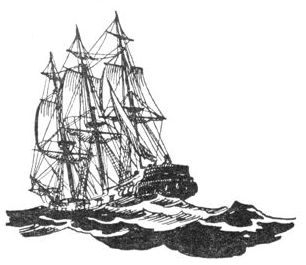
The Dutch soon abandoned these profitless expeditions, declaring that the North Pacific was more profitably exploited than the South. But no Western nation made any persistent effort to explore the ancient kingdom of Cipangu, Japan, and that country remained until modern times a closed book to the curious men of the West. I say ‘curious’ intentionally, for is not curiosity at the root of exploration? It was curiosity that sent Dampier a-roving, and without Dampier English maritime history would have been much the poorer. It is not as a rough buccaneer that he is immortalized, for buccaneering was never a trade to his tastes, but as an indefatigable collector of useful data which were invaluable to those who came later. As a buccaneer William Dampier was no great success, and when the chance came he was glad to leave his piratical associates and join Captain Swan in a ship, appropriately named Cygnet, on a peaceful trading voyage. The crew, however, were otherwise minded, and voted in favour of waylaying the Acapulco galleon. They had their own way, and Dampier found himself, willy-nilly, again a pirate. But the treasure-ship eluded the Cygnet, and Captain Swan proposed making a passage to the East Indies. Some of the crew were elated at the proposal; others were reluctant to risk their skins on such an uncertain venture, but were in the end induced to join their companions. There followed much discussion over the length of the passage and the amount of food and water necessary to last them—some insisting on an excessive quantity of both, others underestimating their probable requirements. There was less than two months’ provisions on board, even calculated at the rate of a half-pint of maize a day for each man. The Spaniards had computed the traverse at 2400 leagues, but the English had said it was no more than 2000 leagues; and to settle the matter Captain Swan urged that Drake had crossed in sixty-eight days, and he would do it in forty days. The Cygnet sailed on March 31, 1686, and sighted the Ladrones on May 20—a fifty-day passage. But it had been a near thing for Captain Swan and Dampier, for toward the end of the journey the men had grown mutinous, plotting to kill and eat their leaders.
This was Dampier’s first voyage across the Pacific, but he was destined twice more to cross this ocean, the second time in command of two vessels, St. George and Cinque Ports, on a privateering cruise, and the third time as pilot to Woodes Rogers, who was sent from England, with that belligerent couple the armed ships Duke and Duchess, to harry Spanish trade in the Pacific. Besides collecting an enormous amount of useful data during his cruising in Melanesia and Micronesia, Dampier discovered the large island of New Britain of the Bismarck Archipelago.

DAMPIER IN THE PACIFIC
In the eighteenth century France awakened to an interest in the far-away South Seas. As early as 1503 a Benot Poulmyer, Sieur de Gonneville, sailed from France in the tracks of da Gama to share some of the Portuguese plums in the East Indies. In his journal he told of a “great strange land” where he and his men stayed for half a year. Now, the eighteenth-century Frenchmen rediscovered this ancient log-book of de Gonneville, and on its evidence claimed for France the honour of having been in the Pacific before Magellan. They also claimed the title to ownership of Australia, a land whose existence was by this time known to the world. But the French decided that before sending ships into the South Seas they must first secure the Falkland Islands, which were considered to be the gateway to the Pacific since they stood within easy sailing distance of Cape Horn. They sent that remarkable man Louis de Bougainville with a shipload of colonists to the Falklands to establish their claim, and this move aroused an international storm. Spain was annoyed, claiming the Falklands for herself as being part and parcel of South America; but England protested they were hers, for had not two Britons—Davis and Hawkins—discovered them? While the dispute raged England sent Captain Byron[2] in the Dolphin to assert her claim. After carrying out his orders he left the Falklands and proceeded into the Pacific, and in his journal described the weather off the Horn as “dreadful beyond all description.” He sailed to the Ladrones, that Mecca of most of the Pacific voyagers, and returned to England in 1766. The Dolphin was again taken into the South Seas, this time in command of Captain Wallis, accompanied by the little vessel Swallow, commanded by Captain Carteret, who was to prove, next to Cook, the greatest of the Pacific navigators. It took four months to get round the Horn, and as the Dolphin was the better ship, Captain Wallis was able to sail away, leaving the Swallow to make the best of things alone. Wallis took a course to the south of the usual Spanish route, and came upon the Paumotus and Tahiti, where he stayed a month to allow his scurvy-stricken crew partially to recuperate. But disease had broken out so badly among his men that it was decided to return in what haste they could to England, which was reached via the Cape in 1768.
Carteret, meanwhile, was having his own troubles in the Swallow. She was old, rotten, and leaky, but somehow he took her safely across the Pacific from Juan Fernandez. On the passage he discovered Pitcairn Island and some of the Paumotus, but missed Tahiti by passing too far south of it. As his ship was unsafe and his men were all ill he decided to land at some island only long enough to refit and recuperate, and then to carry on. He discovered the “lost land of Solomon,” and here sent parties ashore; but the natives, true to their evil reputation, attacked the white men with poisoned arrows, and some of them died of their wounds. Carteret himself was ill but undaunted, and attempted to make repairs to the Swallow on the beach at New Ireland. He had no proper tools for the work, and to make matters worse his men were constantly attacked by the natives, so that in the end he had to sail away. From New Ireland he went to Mindanao and to Macassar, in Celebes, but everywhere he was unwelcome. The Dutch at Macassar refused him aid, and he was forced at last to sail for England. By a coincidence Bougainville overtook the crippled Swallow wallowing home to England, and, though an enemy, wrote a generous eulogy of the intrepid Carteret.
France replied to this voyage of Carteret’s by sending Bougainville to explore Tierra Australis, and on this second voyage he came upon Wallis’s island paradise, Tahiti, which he romantically named New Cythera, and buried papers there, claiming the country for France. Leaving Tahiti with many regrets, he sailed westward and discovered Samoa, where he rested awhile, proceeding thence to New Guinea. On the way he saw the Australian shore to starboard, and guessed it to be the land Quiros called Tierra Australis del Espiritu Santo. Both Carteret and Bougainville found the Solomons without recognizing them as Mendaña’s islands. Bougainville, while anchored at New Britain, discovered a piece of lead on which were stamped English words, an indication that the English had already been there. Bougainville, who was born in 1729, was by training a soldier and officer in the French Army, and it was not until he was thirty-five that he went to sea. His seafaring life began when he undertook at his own expense to take colonists out to the Falklands. Afterward he was given command of the frigate La Boudeuse and the transport L’Étoile to make a voyage of discovery round the world. It was on this voyage that he first saw Tahiti and discovered Samoa. He returned to France in 1769 with nearly all of his original crews of 200 men, a fine testimony to his ability as a seaman and his care of his company. Bougainville was an exceptional man; his ability as a navigator makes him rank high among the great navigators of the world. His name is perpetuated in that of the largest of the Solomon Islands, and also in a South American climbing plant, the Bougainvillæa.
The reports brought back to France of the island paradise, Otaheite,[3] which Bougainville called New Cythera, aroused enormous interest, and the Government at once ordered de Surville to sail thither and claim the island for France; but before he was half-way there scurvy laid hold of his crew, and he was compelled to run for New Zealand to land and recuperate. De Surville was a plucky and resourceful commander, but he had not the tact necessary to deal successfully with the natives; and when the Maoris stole one of his small boats he landed an armed party and severely punished the whole tribe, making the chief a prisoner. De Surville intended to take this unfortunate native to Peru, but the fellow died of a broken heart before land was reached, and then de Surville himself was drowned while going ashore in a boat on the Peruvian coast.
Bougainville had taken a friendly Tahitian back to France, where he became the talk of Paris; but he longed to see his own people again, and Marion du Fresne at his own expense offered to take the native back to Tahiti. Du Fresne sailed with two ships, intending, after landing his passenger at Tahiti, to explore Polynesia; but his voyage came to an early and tragic conclusion when the leader was killed by the Maoris in revenge for the acts of de Surville.
There was still a lot of the Pacific unexplored: the whole of the east coast of Australia, most of the New Hebrides, the Paumotus, and the Society Islands were undiscovered. New Caledonia, Cook Island, Norfolk Island, the Ellice, Gilbert, Marshall, and Union groups were unknown, and no one had any idea of the size of New Zealand. On the American side of the Pacific the greater part of the coast of the United States, Canada, and Alaska was still a terra incognita to the civilized world. There was, then, much yet left to do for the right sort of man, and he appeared in the person of James Cook, son of a Yorkshire labourer, risen from the lowest rank to that of an officer’s in the most exclusive navy in the world. He became one of the most romantic figures of his time. Cook’s name easily stands first in Pacific history, for no man explored it so thoroughly from north to south and from east to west. He sailed there in the Endeavour in 1768, again in the Resolution in 1772, and a third time in the Resolution in 1776.
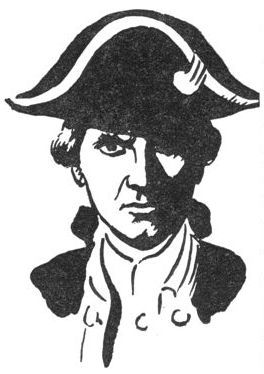
CAPTAIN COOK
When the Royal Society decided to send a scientific expedition to the South Seas to observe the transit of Venus James Cook was chosen as leader on the strength of his splendid record in the Navy. The ship that carried the expedition was the Endeavour, and included in her complement of ninety-four persons was Mr (afterward Sir) Joseph Banks, the famous botanist, and Dr Solander, the Swedish naturalist, after whom the Solander Rock and the whaling-ground were named. The mere recital of Cook’s voyages and maritime discoveries is amazing. Here we can only refer briefly to the main events of his three fruitful voyages into the Pacific. It is interesting to note that, although he had already become famous for his Atlantic voyages, his conduct in action, his surveys of the Labrador and Newfoundland coasts, and his treatises on astronomy and mathematics, he received his commission as lieutenant only after he was chosen by the Admiralty to conduct the scientific expedition for the Royal Society.
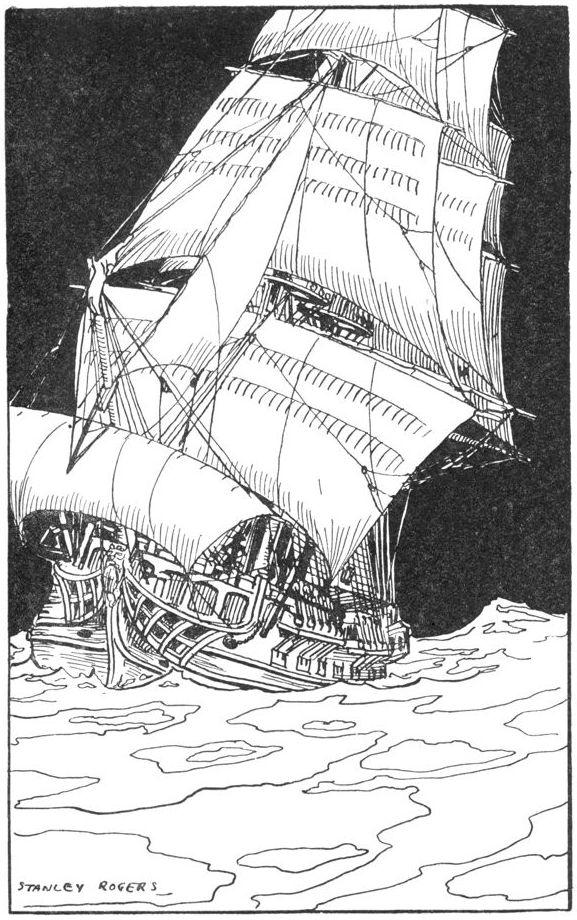
A SHIP OF COOK’S DAY
Leaving England in May 1768, the Endeavour reached Tahiti eleven months later. From there Cook sailed in search of the great South Continent, explored the Society Islands, and spent six months mapping the coast of New Zealand, during the course of which he discovered the channel (Cook Strait) which divides the two islands. Next he surveyed with minute care the entire east coast of Australia, in itself a stupendous work. He took possession of the coast in the name of Great Britain, but native hostility prevented him from penetrating into the country, just as it had done in New Zealand. After further exploration in Melanesia he returned to England in June 1771. For his service to science he was made a commander, and shortly afterward was appointed to take an expedition to settle once for all the question of the great Southern Continent. With two ships, the Resolution (462 tons) and Adventure (330 tons), Cook commanding the former, he left Plymouth in July 1772 for the Cape of Good Hope, from whence he intended to strike south to the Antarctic. In January 1773 he crossed the Antarctic Circle, but not finding land turned north and set a course for New Zealand. From there he resumed the search, sailing in a zigzag course up and down the South Pacific, taking considerable risks among the ice-floes of the Antarctic, but never sighting the rumoured continent. He called at Easter Island and determined its exact position, incidentally describing in his journal the giant statues which the Dutchman Roggeveen had first seen. Next, sailing northward, he put many of the Polynesian islands in their correct place on the chart. Afterward he discovered New Caledonia, Norfolk Island, and the Isle of Pines, and thoroughly surveyed Quiros’ Land of the Holy Spirit, which he prosaically renamed New Hebrides. Leaving these warm latitudes, he once more stood south to the Antarctic and crossed the whole width of the Southern Pacific to Tierra del Fuego, which was surveyed before returning to England by way of the Atlantic, where further discoveries were made. His work was done; he had exploded the great South Continent myth. Not the least of his discoveries was an anti-scorbutic, a preventive of the dread disease of scurvy. During this 20,000-mile journey only one man was lost out of a crew of 118. In recognition of his work he was given the rank of post-captain and appointed captain in Greenwich Hospital, besides receiving many honours from learned societies.

In 1776 Cook, tiring of life ashore, volunteered to take an expedition in search of the North-west Passage from the Pacific side, and, if possible, to sail eastward into the Atlantic. He sailed in the Resolution from the Nore on June 25, 1776, being followed by another vessel, the Discovery, and reached the Cape at the end of November, whence he proceeded to Tasmania and New Zealand, and made several discoveries in the Cook Archipelago. Crossing the Pacific toward his objective, the coast of New Albion (California), he came upon the Hawaiian Islands, his most important discovery, which he named the Sandwich Islands, after Lord Sandwich, First Lord of the Admiralty. Cook never had a flair for fine-sounding names. He made the American coast in 44° 55′ N., and then sailed northward, plotting its contours as he proceeded. Up along what is now the coast of California, Oregon, Washington, British Columbia, and Alaska, he sailed carefully, surveying and taking notes. He entered the Bering Sea and beyond, but was stopped by the ice in latitude 70° 41′ N. In these northern waters many discoveries were made, and much new land added to the map; but he failed, as everyone else had done, to find the North-west Passage. Making his way back to Hawaii, he went, unknowing, to his death. To recover a boat stolen by some of the natives Cook took their chief as hostage, and went ashore the following day to endeavour to secure the boat. There was a skirmish, and the party retreated to the boats, Cook being the last man. He was struck down by the natives and killed as the rest of the party, finding themselves greatly outnumbered, pulled away from the shore.
His achievements are his monument. He needs no other panegyric.
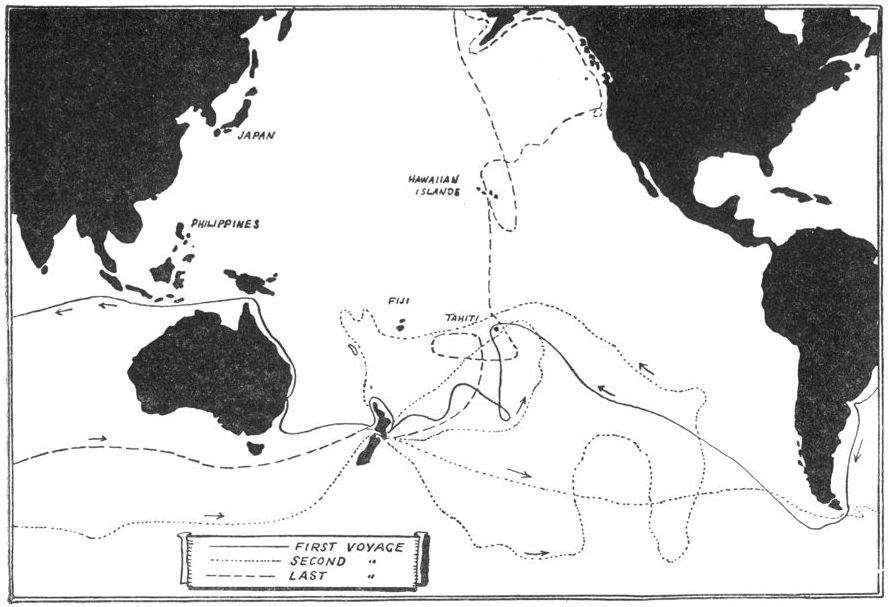
CHART OF CAPTAIN COOK’S PACIFIC VOYAGES
|
Tasmania was sighted on November 24. |
|
Afterward Vice-Admiral. He was grandfather to the poet. |
|
Old form of Tahiti. |
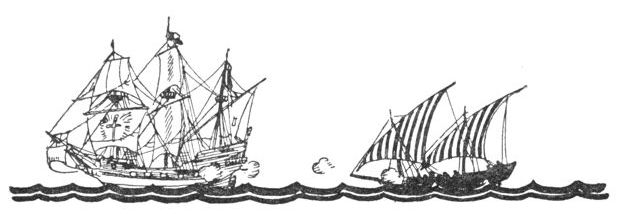
The difference between a privateer and a pirate is small or great according to how you look at it. Some people regard war as murder, and others look on it as an honourable occupation. Murderers usually kill in hot blood, soldiers usually kill in cold blood: the one act is tabooed by society, the other is sanctioned. Likewise with piracy and privateering: one was frowned upon, while the other was lauded; but both parties were out for loot, and neither stopped at killing.
Drake was a privateer, Blackbeard was a pirate; though doubtless their enemies found little to choose between them. But there was a difference between one private citizen getting carte blanche from his Government to burn ships and rob people, and another private citizen doing the same thing without a licence. Even so, privateering was an ugly business, for it was not disinterested as soldiering is. It was often prompted by the lower motive of gain rather than the nobler one of service.
Privateering among civilized countries was declared illegal in Article 1 of the Declaration of Paris (April 16, 1856). In a sentence of five words, “Privateering is and remains abolished,” one of the most potent incentives to war was removed, and a big step made toward world peace. The only two Powers who did not sign the treaty were the United States and Spain, though when they fought in 1898 both tacitly refrained from privateering.
“To harry Spanish trade in the South Seas”; how often we read those words in the maritime history of England. Drake, Woodes Rogers, Shelvocke, Anson—all went out for that purpose, and all filled their ships with booty. The English earned a repute for being terrible foes, and not without reason. Drake inspired in the inhabitants of the Pacific coast towns, from Valparaiso to Guatulco, such a fear of the English that when others of his countrymen came along afterward their task was harder. They found the people ready for them with every device of defence that could be employed. Nevertheless, few departed empty-handed, and nearly two hundred years after Drake’s profitable voyage Anson repeated the exploit with such success that when he returned to England it required thirty wagons to carry the loot of gold and silver from Portsmouth to London.
Privateering usually paid.
Between them Spain and Portugal claimed the whole of Central and South America, and this claim does not seem ever to have been seriously disputed; but when Spain declared sovereignty over the entire Pacific Ocean England, France, and Holland refused to recognize such colossal impudence. The Pope, whom Elizabeth rudely called “the Bishop of Rome,” had settled a dispute between Spain and Portugal over the former’s title to the South Seas by arbitrarily dividing it equally between the two disputants. The English Queen insisted on the right to send her ships wherever she pleased, arguing that the seas were the highways of the world. Spain, however, denied the right of other nations to send ships into the waters along the entire west coast of the Americas, regarding with open hostility any foreign vessel which ventured so far. There was an excellent reason for this attitude of Spain. With Portugal she had been the first-comer to that part of the world, and had founded all along the west coast towns and cities which carried on a rich trade with the homeland. Fearing foreign competition, Spain, who was always the leader where herself and Portugal were concerned, took the provocative course of denying to foreign ships entry to South American ports. That is, in short, how it all began—the long and bloody record of pirates and privateers in the South Seas. Such arrogant claims as those of Spain were as a challenge to the world, and there was no lack of stout fellows—honest or otherwise—only too glad to accept the challenge.
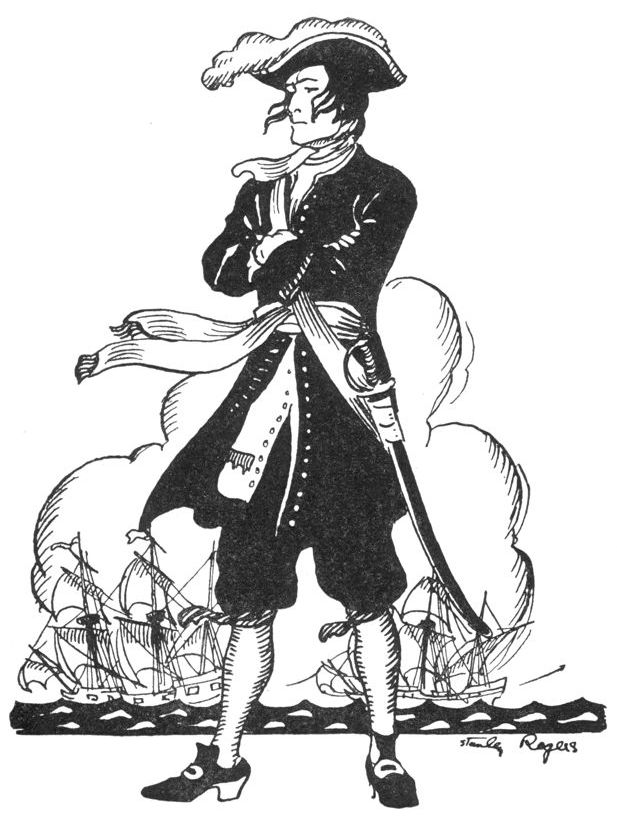
A PRIVATEER
Drake, sponsored by Queen Elizabeth, set out in the Golden Hind in company with four other small vessels, and, as most people know, had an exceedingly profitable voyage, in spite of losing four of his ships from various causes. He aroused the Spaniards to such fury that in the end he had to leave those perilous waters, where every man was after his blood. The little English vessel, travel-worn, leaking, and alone, sailed northward along the Chilean coast, her undaunted captain determined to get what he had set out for, or sink in the attempt. In the harbour of what is now Valparaiso he found the great galleon La Capitana, which he captured by surprise, and took from her coffers gold to the value of 37,000 Spanish ducats (which is equal to about £24,000 sterling) besides 2000 jars of wine and a large quantity of merchandise. This was encouraging.
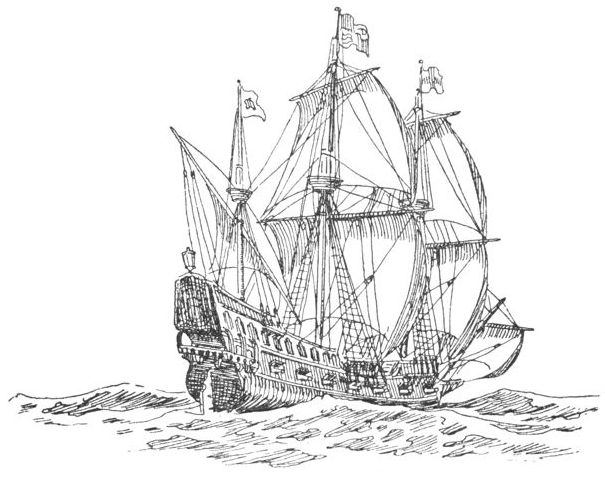
THE “GOLDEN HIND”
In several places he made minor raids ashore, picking up 4000 ducats here, 3000 pesos of silver there, and, another time, 800 pounds’ weight of silver from the saddle-bags of a procession of llamas driven by a priest and an Indian.[1] Sailing up the coast, Drake led his men into several assaults on shipping without much profit until he came upon the famous Cacafuego, the treasure galleon for which he had been on the look-out for a month. She was first seen about four leagues off against the faint light of dawn, a vast ship of most impressive appearance. But he refrained from chasing the galleon in the increasing light lest the Spaniards might escape, and held back all that day until sunset from making the attack. The Dons, however, did not suspect an enemy, and innocently approached what they believed to be a harmless Spanish trader. Still Drake stood off, so arranging matters that the galleon did not approach close to the Golden Hind until near upon sunset. The time had come to show his true colours. Drake hailed the Spanish captain, demanding his surrender, and, receiving an astonished refusal, gave him three round shot from his culverin. This salvo brought down the galleon’s mizen-mast and wounded some of her crew. A flight of arrows from English bowmen on the Golden Hind followed the gunfire, and the master of the Cacafuego, finding himself at a hopeless disadvantage, at once surrendered his ship. A boarding party was sent from the Golden Hind to take possession of the galleon and imprison her crew below as a measure of safety. To avoid pursuit Drake took his prize a two days’ sail out to sea before searching her for treasure. The two vessels lay for several days wallowing in the Pacific swell a cable’s length apart, while the Englishmen took many boatloads of bullion and gold plate from the Cacafuego to the Golden Hind, and the luckless Spaniards lay under hatches helpless to prevent the despoiling of their fine ship. When the treasure was safely transferred to the holds of the Golden Hind an inventory of it showed 26 tons of silver, fourteen chests of pieces-of-eight, 80 pounds weight in gold, a quantity of gold plate and jewels—a haul worth over £3,000,000 in modern English money! There is more than one version of this incident, some chroniclers going so far as to say that Drake had to throw some of the treasure overboard lest its great weight should sink his ship. All versions, however, state that the treasure was the greatest ever captured by any ship.
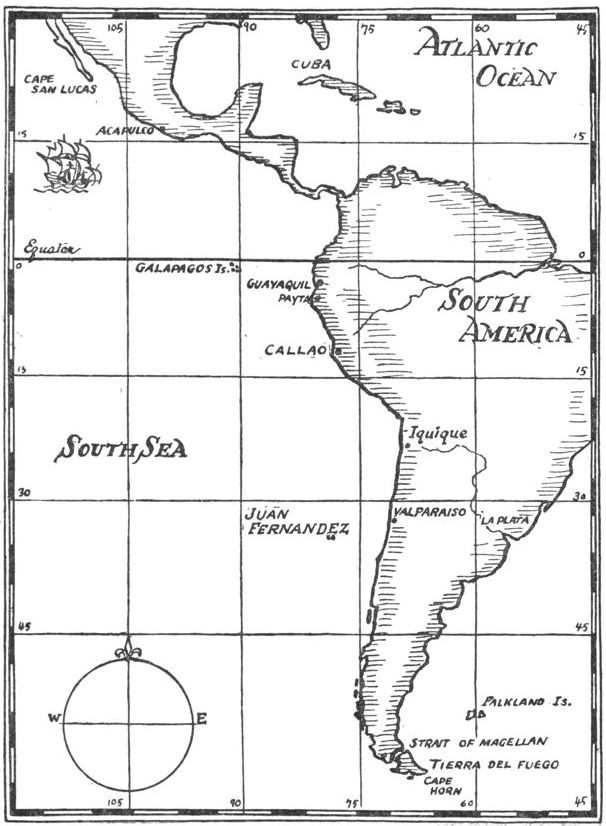
THE WEST COAST
Drake was always considerate to his prisoners, and this humanity in an inhumane age reflects greatly to his credit. Such generous treatment of the prisoners from the galleon was typical of all his privateering exploits. The officers and men were all given clothes, together with liberal gifts of money, and then set free in their own ship to sail away for Panama, some 500 miles distant. Even the Spaniards acknowledged this chivalry of the Englishman, and told their children of the deeds of El Draque until he became a half-legendary figure. His contempt for the Catholic faith, however, naturally wounded the Spaniards’ feelings, and they never forgave him for the sacrilegious way his men were allowed to pillage the churches and heap contumely on the priests. Yet this same Drake insisted on daily prayers and a religious service twice weekly on board his ship, for he was a most devout Protestant, strong for all the ritual of his own Church.
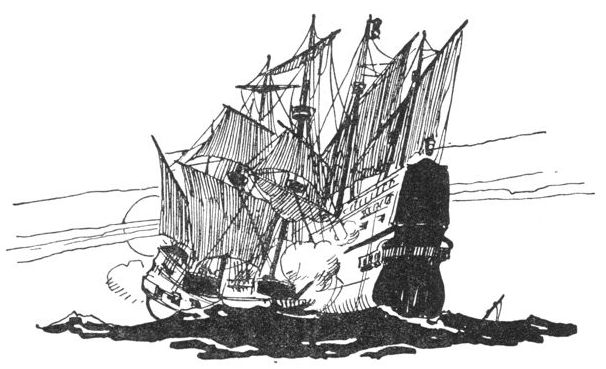
It seems that he anticipated heavy censure for this seeming incongruity in his conduct, for he once told a Spanish ecclesiastic that he knew people must think him a devil who stole by day and prayed by night. And he then reminded the priest that he was only carrying out the orders of his sovereign lady, the Queen of England, just as the Spanish Viceroy must obey the commands of his master, the King of Spain, and that he greatly regretted the necessity of taking anything that belonged to private citizens, as his only enemy was the King or his Viceroy Don Henriquez. While it would be absurd to make Drake out to be a gentle knight when actually he was a somewhat swaggering, theatrical fellow, he was undoubtedly a great navigator and leader who always showed more humanity to the enemy than they would have offered him had the position been reversed. Indeed, some of Drake’s men were old seamen who had suffered the brutality of the Spaniards and had signed on for this voyage with the principal object of revenging themselves against a race that they had reason to hate.
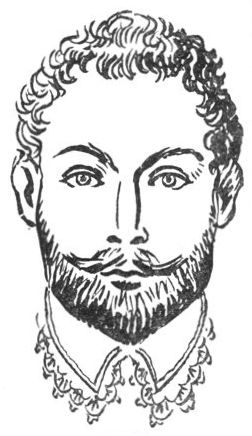
DRAKE
Drake was the first Englishman to sail round the world, and it might truly be said that he had the honour thrust upon him by necessity. When he was ready to return home his little ship lay deep in the water with 50 tons of treasure in her, and this made her so sluggish that she would have had no chance of getting away from a fleet of fast sailers. As it was certain that the Spaniards would have an overwhelming force awaiting him off Cape Horn, the only course for the Golden Hind was to cross the Pacific, round the Cape of Good Hope, and so up the Atlantic to England, thus completing the circumnavigation of the earth. Drake, being far too good a general to risk losing what he had gained by taking his deeply laden vessel round the Horn, chose the alternative course, and arrived safely at Plymouth in September 1580, after an absence of nearly three years.
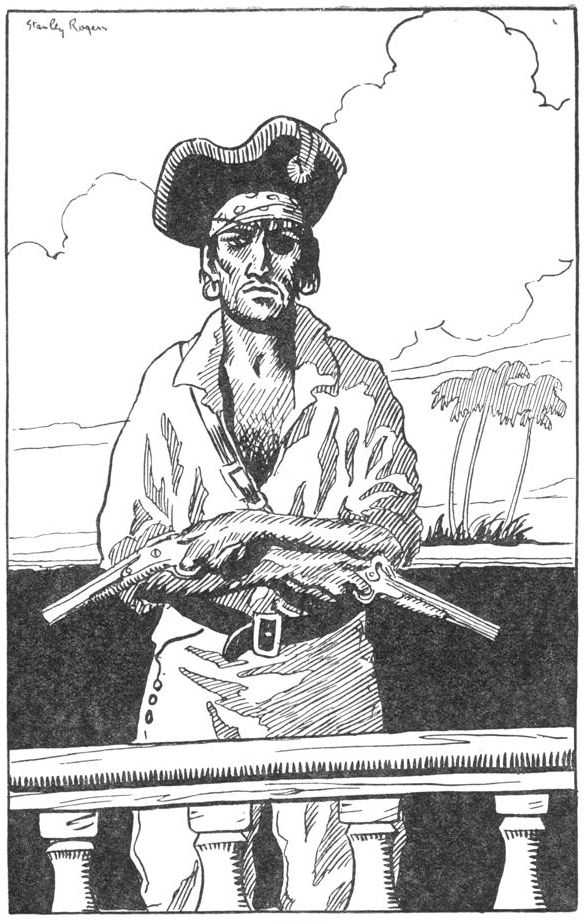
A PIRATE
The news of the success of this voyage spread over the country, and had the inevitable effect of firing the imagination of other bold spirits to do likewise. One of these was Thomas Cavendish, a Suffolk landowner who, having squandered his wealth, bethought himself of a privateering cruise as a way to mend his fortunes. With a company of adventurers he set out from England in July 1586, bound for the South Seas with two small vessels, Desire and Content. Cavendish soon showed himself to be a ruthless man, leaving behind him wherever he went a reputation for ferocity and inhumanity that was the antithesis of Drake’s character. From Cape Horn to the Peninsula of Lower California Cavendish left a trail of fire and pillage and dead Spaniards, but at no point had he made a large haul of treasure, as he had vowed to do before returning to England.
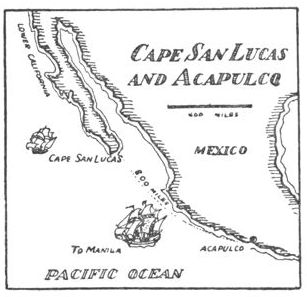
At Cape San Lucas, on the southern extremity of Southern California, he waited for one of the Manila galleons, which always used this cape as a bearing from which they set their course for Acapulco, Mexico. Here the English ships cruised on and off, biding their time until the treasure galleon should appear. After weeks of monotonous waiting, during which time a look-out had been kept constantly at the masthead, the patience of the English was rewarded. On November 4, 1587, a sail was seen on the western horizon, and presently it was identified as the galleon Santa Anna, said to be the richest treasure-ship which had ever left Manila. She was a huge galleon of 700 tons, beside which the English caravels were as Channel boats are to a liner. The two little ships put on all sail and gave chase, slowly overhauling the lumbering Spaniard, which had taken alarm and tried to escape. Coming alongside the Englishmen attempted to board her, but were met with such stout resistance that they drew off and poured volleys of round shot into her for full five hours, until the Spanish admiral, finding his ship in a sinking condition, was forced to run up a flag of truce and surrender. The Englishmen found the upper works of the Santa Anna completely wrecked, and many of her defenders dead or sorely wounded. The rest of the officers and crew were put under guard and the decks hastily cleared up, while the dead were buried and the wounded attended to with what haste possible, for the victors were hungry to see the spoil. When the hatches were opened, and chest after chest of gold and silver was brought up, the delight of the victors knew no bounds. They fired guns, sang, and danced for joy. And the treasure, while not of such fabulous worth as that of the Cacafuego, in spite of its having been supposed to be the richest ship ever out of Manila, consisted of gold coin to the equivalent of £200,000 sterling, and such a weight of silks, brocades, damasks, perfumes, spices, and wines that no less than 500 tons had to be abandoned, the little English ships having no room in which to stow it.

THOMAS CAVENDISH
The sight of the rich treasure put Cavendish in such an excellent mood that he was disposed to treat his prisoners with more generosity than was his wont. Except for the pilot of the galleon and a few others, whom he kept as prisoners, all the Spaniards were put ashore at Cape San Lucas and provided with provisions, clothes, the sails of the galleon for tents, and enough wood to build a raft with which to reach the coast of Mexico. Before leaving them he gave the Spanish officers a present each and sufficient arms and ammunition for their defence against hostile Indians.
After taking as much of her cargo as the English ships could carry the galleon was set on fire and abandoned.[2] The Desire (Cavendish’s ship) and Content now made speed to quit this dangerous coast, where the non-arrival of the galleon would bring out every Spanish ship to search for her, and Cavendish had no wish to risk losing what he had so hardly won. In some manner which has never been explained the Desire got away first and never saw the Content again. Whether she was wrecked or captured by the enemy can only be guessed at. Like Drake, Cavendish now sailed into the west across the broad Pacific to the East Indies, and thence to the Cape, which the Portuguese called Buena Esperanza, and from there to St Helena and so to the Channel. He was the second famous Englishman to sail round the world—a fact which is the more interesting when it is remembered that Cavendish was not a sailor. A letter to a friend after he returned summarizes the main achievements of the voyage. He told of sailing along the coast of Chili, Peru, and Mexico, landing frequently to burn and sack towns, picking up considerable spoil. He claimed to have captured and burned nineteen ships, a record which he asserted would have been bettered had his presence not been discovered so soon.
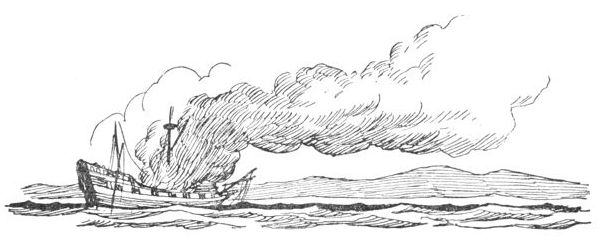
Three years after Cavendish returned from his world voyage Richard Hawkins, the only son of Sir John Hawkins, fitted out a little ship “to go and harry Spanish trade in the South Seas.” The vessel had been christened Repentance by Hawkins’ stepmother, whose Puritanical inclinings made her believe that if one was to succeed in any enterprise one must approach it in true humility of spirit. The ill-luck of Sir Richard Grenville was attributed by many people to the boastful name of his ship—Revenge. But the Repentance was not to keep that name, for before she sailed Queen Elizabeth happened to see her while being taken down the river in the royal barge, and her Majesty was so pleased with the little vessel’s graceful lines that she expressed a wish that the ship’s name should be changed to Dainty, and so Dainty she was known as for ever after. But she was not to bring her master good fortune, for never has there been such an ill-starred privateering expedition as that of Hawkins.
He reached the West Coast without incident; but before long the Spaniards got news of the venturesome Englishman’s presence in their waters and at once began preparing a squadron to capture him; and capture him they did, with seven stout ships to his one. The Spanish squadron, under the command of Don Beltran de Castro y de la Cueva, a fellow whose appearance was as imposing as his full title, sighted the lone English ship some leagues south-west of Callao. They at once gave chase, but, a gale coming up, the lumbering galleons had to reduce sail while the little Dainty ran before it, and, for the nonce, escaped, leaving the partially dismasted Spaniards hull down astern.
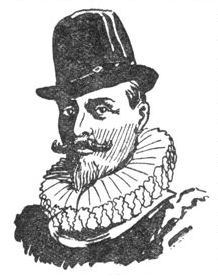
HAWKINS
The enemy put into port to refit, while Hawkins, thinking himself now safe from pursuit, dropped anchor in a small bay to send boats ashore for water. After a few days here the hook was raised, canvas unfurled, and the Dainty put out to sea, only to find outside three enemy ships who had been looking for her. Though the odds were against him, Hawkins knew he must stand and fight, as, the Spaniards having the weather gauge, there was no hope of escape. There followed a running action between three ships and one, between 1300 men and 75 men. It was hopeless, of course; but Hawkins declined to admit himself beaten. Like Sir Richard Grenville, he refused the requests of his officers that they should surrender. The leader lay in his cabin, where he had been taken badly wounded, and bade his men fight on. “Have we come into the South Seas to put out flags of truce?” he demanded. For a while this heartened the others, and the fight was continued all day and on through the night, all the next day and on through that next night into the third day. The Dainty was approaching her end, her spars and rigging smashed, her decks running blood, her hold badly a-leak, and many of her men dead. It could be borne no longer. Ellis, the second in command, surrendered to Don Beltran, and was received with the courtesy due to a vanquished foe. The Spanish officers treated the English humanely, and so long as they were on the ship they were made to feel their captivity as little as possible. But when they were landed their real troubles began. The local governor did not honour the promises made by the Admiral, and it was only the timely interference of the Marquis de Cañete that saved Hawkins from the tortures of the Inquisition, which was clamouring for his body to work its devilishness on. Though he escaped their clutches, he was sent to Spain to languish in prison for eight terrible years before the chivalrous Don Beltran, who had never forgotten him, was able to use his influence for Hawkins’ release.
The tragic dénouement of Hawkins’ expedition did not, however, deter others from trying their fortunes in the Pacific, for as the years went by the number of these searovers increased until they became almost a rabble. But most of these seventeenth-century adventurers were of a different type from the Elizabethans, who as licensed privateers sailed under the respectable ægis of the Government. Now appeared the real buccaneers, cut-throats, petty thieves, ex-gaol-birds, and Navy deserters, who hated authority—and the Spaniards. Since England was usually at loggerheads with Spain, most of the early buccaneers were Englishmen, with Henry Morgan[3] as their leader. Lesser men were Dampier (who reformed and wrote a most entertaining work on the sea) and Cooke, Sharp, Harris, Sawkins, Cowley (the American pirate), Swan (who sailed the Cygnet), and Davis. These were a swashbuckling, disreputable company of men, only two of whom were subsequently able to live down their unsavoury reputations. These two were Morgan, who seems to have intimidated the politicians into recognizing him, and Dampier, who by his contributions to the art of navigation and to science earned the gratitude of the learned societies. Though Dampier took part in many of the raids on the West Coast and attacked more ships than he could remember, he never accumulated any wealth from these shady adventures, and, unlike Morgan, ended his days a comparatively poor man.
The records of the out-and-out pirate and the more respectable privateers overlap curiously. For example, there is Dampier beginning as a common buccaneer and ending as a navigating officer with Woodes Rogers during the latter’s successful privateering venture in the South Seas from 1708 to 1711. Dampier bore an unsavoury reputation, despite his contribution to the scientific and geographical knowledge of the world; but when he painted in glowing colours the profits to be got from raiding Spanish ships in the Pacific to some gentlemen of Bristol, and proposed that he should join them on such an expedition, their cupidity overcame their antipathy to the ex-pirate, and they agreed to fit out an expedition and take him along, though he was not trusted with the command. The leader of this remarkably successful voyage was Woodes Rogers,[4] who returned to England with nearly £250,000 worth of gold and merchandise taken from South American towns and Spanish merchantmen.
The success of Woodes Rogers’ voyage stirred up the country, just as the voyages of those other privateers, Drake, Cavendish, and Hawkins, had done; and it was not long after the return of the Duke and Duchess, Woodes Rogers’ ships, that another privateering expedition was prepared for the South Seas with two ships—the Speedwell, under Captain George Shelvocke (who was given command of the expedition), and the Success, under Captain George Clipperton, after whom Clipperton Island is named. This Clipperton made a link with the former expedition inasmuch as he had been with Dampier as his mate during the latter’s buccaneering days. But Clipperton was a man of too much spirit to serve under the half-hearted Dampier, and so seized a small galley and took himself off with twenty-one of Dampier’s men. Now he appears as second in command of a privateer with the time-honoured object, “to harry Spanish trade in the South Seas.”
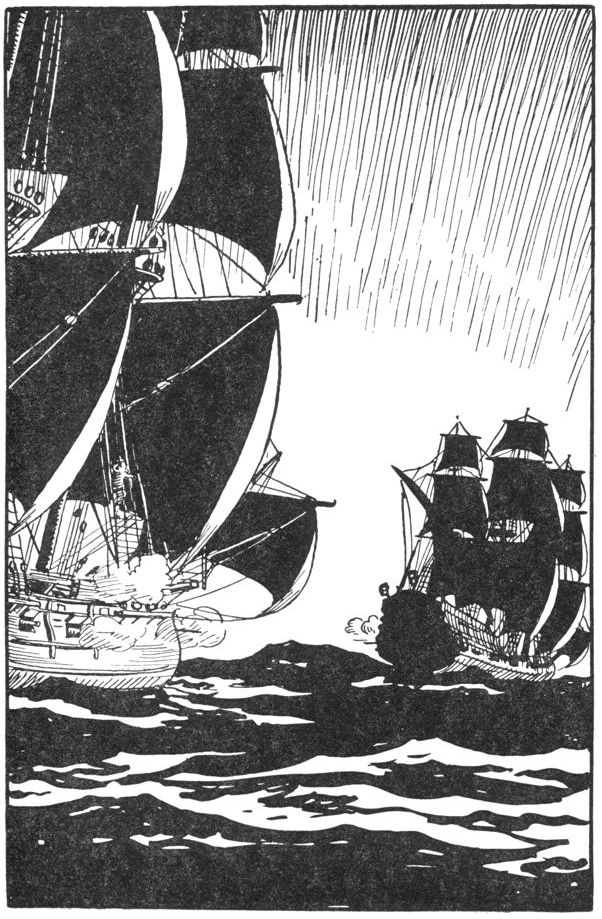
THE CHASE
Privateering was, as the name implies, a private enterprise—in short, a limited company with a board of directors and shareholders, as with any business enterprise. Now, while the two ships were held up at Plymouth in the winter of 1718-19, waiting for favourable winds to get them out of the Channel, the company transferred the command of the expedition to Clipperton, which was a direct affront to Shelvocke and the cause of much ill-feeling then and later. However, the ships got away from Plymouth in the middle of February 1719, and, once clear of the Channel, stood south for the Canaries and the Straits of Magellan according to orders. The Speedwell carried twenty-four guns and 160 men, the Success thirty-six guns and 180 men. Six days out, during a strong gale, the two ships became separated (some say intentionally), and did not meet again, except for a brief encounter later off the coast of Panama. Both men were quick-tempered, and it was just as well they saw so little of each other. They both sailed their own ways, and both afterward published exciting narratives of their voyages.
Shelvocke has been described as hasty, tactless, and gouty; and Clipperton as blunt, irascible, and rough-mannered. Two worse-matched companions could not be found anywhere. When Clipperton came on deck one morning and found his ship alone he was furious, and all the more so as Shelvocke carried the expedition’s entire supply of wine and brandy.
Meanwhile the Speedwell was ploughing southward for the Horn. Reaching there she was three weeks beating round against the westerly gales, during which one man was lost overboard. On the Chilean coast some of the crew were sent ashore for water and a raid on some livestock for the ship’s larder. At Concepcion two small prizes were taken, and two of Shelvocke’s men were ambushed on the beach by Spaniards and killed. A few days later a fat merchant-ship, containing £6000 in coin and plate as well as a large amount of merchandise, was taken. The merchantman was burned, but a smaller vessel captured at the same time was kept as a tender. Shelvocke now sailed back to Juan Fernandez, where a rendezvous with Clipperton had been fixed upon before leaving England. On arriving at the island Shelvocke found that his consort had called there and gone three months before. Leaving Juan Fernandez, Shelvocke continued his search for prizes, and after taking one or two, and losing the tender at the same time, he sailed for the town of Payta, which was plundered after the Spanish had refused to pay a 10,000 dollars ransom. Here the privateer had a narrow escape from capture by a big enemy man-of-war of fifty guns and 450 men. Escaping to the southward the Speedwell was driven ashore on Juan Fernandez in a heavy gale and lost most of her sticks, though the ship’s company managed to get ashore on a raft. Shelvocke naïvely records the fact that he saved his precious commission to show, in the event of his capture, that he was no pirate. As a pirate he would have got short shrift; as a privateer he would have escaped the supreme penalty. The ship’s company lived ashore like a party of Robinson Crusoes, salving whatever they could from the wrecked Speedwell. Behind them rose lofty mountains, and around them were great numbers of seals and sea-lions, many of which were later slain to provide meat. The skins were sewn together and used as tops for the rough huts the castaways built from the wreckage.
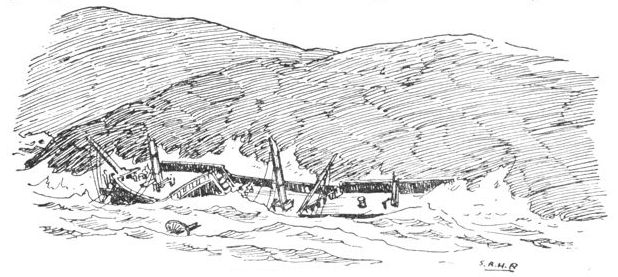
SHELVOCKE WRECKED
Shelvocke asked the carpenter if he could build a longboat out of wood from the wreck, and on hearing the latter say it was impossible the armourer stepped forward and offered to attempt to build a boat. The ironwork was forged from old Spanish swords, and the keel was made from the Speedwell’s bowsprit, and with plenty of help at hand a serviceable boat was quickly built and launched. Now Lieutenant Brooks, who had been promoted from the lower deck, joined a former messmate, one Morphew, a cobbler, in a demand that the treasure should at once be shared out equally among all hands, a demand which Shelvocke was forced to agree to. The boat, which was named Recovery, put to sea, nearly five months after the loss of the ship, with all but eleven English and thirteen Indians, who preferred to remain behind rather than trust themselves to the frail craft. The Recovery had a burden of about 20 tons, and was provisioned with over 2000 dried eels, some live hogs, a few bushels of farina, and 60 gallons of seal-oil. With an armament of one small mounted gun, these privateers set out in their tiny craft to retrieve their fortunes, and, what is more, they succeeded. These forty men, crowded together on top of bundles of dried eels, in a craft so low in the water that she had only 16 inches of freeboard, and which constantly took dollops of water over the side, actually chased a well-armed Spanish merchantman, the Margarita, in spite of the disparity of size. The privateers were desperate. Their craft would not float much longer; they must quickly find a vessel or sink. With their one small gun, and two round shot, a few bolts, the clapper of a bell, and a bag of pebbles for ammunition, they continued to blaze away at the merchantman until she escaped, leaving one man on the Recovery dead and several wounded. Then fortune smiled on the privateers, for they actually succeeded in capturing the Jesu Maria, another merchantman. The captain offered 16,000 dollars for his ship, but Shelvocke, needing the ship more than the money, refused. Sailing to Payta, he again raided the town, but with small reward for his trouble.
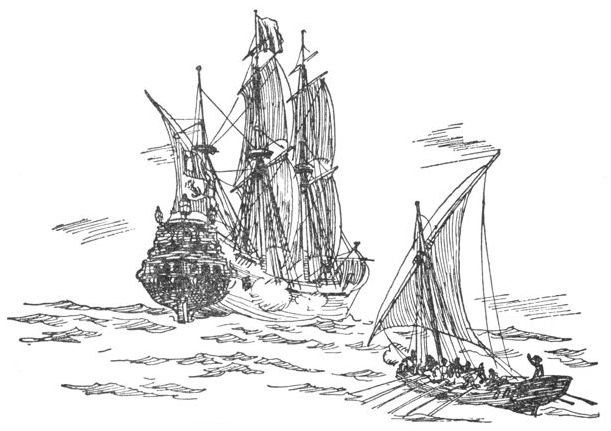
CHASING THE “MARGARITA”
Now, with the intention of crossing the Pacific, Shelvocke sailed due west, and shortly fell in with an English ship which proved to be Clipperton’s Success. Shelvocke went aboard, but he met with a cool reception and was glad to return to his own ship again, after which the two captains parted company. Continuing westward, Shelvocke took the merchantman Santa Familia, of 300 tons, with provisions and ammunition. She was larger than the Happy Return, Shelvocke’s first capture renamed, but on going aboard a difficulty arose, for the Spanish captain showed a letter stating that peace had been signed between Spain and England. Shelvocke doubted its authenticity, and refused to abandon the prize. A few days later a small ship, the Holy Sacrament, was captured, and shortly afterward the Conception, of Callao, was chased and taken after a stiff action. Shelvocke took her cargo, but released the ship, “being doubtful of his position.” After an exchange of civilities he permitted it to continue on its course. Meanwhile, on returning to the small prize, the Holy Sacrament, he found that four of his men left in charge had been murdered by the Spanish prisoners. These fellows were summarily dealt with.
When one of the cases of ‘marmalade’ taken from the Conception was opened it was found to contain bars of virgin silver, and five other cases were discovered to be in the same condition. This, it seems, was a trick to defraud the King of Spain. A similar ruse was discovered by Clipperton, who threw overboard what he thought to be sun-dried bricks, only to discover when there were but four or five left that they were bars of silver coated with clay!
Shelvocke now continued across the Pacific to Whampoa, in China, where he sold the Santa Familia for £700, divided the booty with the companions of his voyage, and then bought a passage home in the East Indiaman Cadogan, arriving at Dover on July 30, 1722.
As for Clipperton, he was having plenty of adventures of his own. A good part of his crew died of scurvy before he reached the Horn, but the rest were able to recuperate from the effects of the long passage when they went ashore at Juan Fernandez some months later. He made several captures of Spanish ships, and then sailed for the Philippines to raise the devil among the Spaniards in that part of the world, but he was betrayed by one of his prisoners, the Marquis of Villa Roche, and nearly lost his ship in the harbour at Guam. As it was the Success was so badly damaged by the Spanish battery on shore that her crew afterward deserted, considering her unfit to be at sea. The money and loot was divided at Canton, and when accounts were settled there was little left for the owners. Clipperton, whose worst fault seems to have been drink, arrived in Ireland in June 1722, a broken-hearted man, and died there within a week of his return.
And this was the last of the famous private filibustering expeditions that went from England “to harry Spanish trade in the South Seas.” The expedition under Commodore George Anson in 1740 was actually a naval enterprise, and does not come within the meaning of the term privateer.
|
The peso, or Spanish dollar, was worth eight reales, thus the Spanish dollars were called “pieces-of-eight” by the English seamen. |
|
As a matter of fact, the burning galleon drifted ashore, where the castaways were able to put out the flames, patch up the hull, and, with a jury rig, sail her down to Mexico. |
|
Morgan was a Welshman. The author has recounted his exploits in The Atlantic (Harrap). |
|
The voyage is described in Sea-lore by the same author (Harrap). |
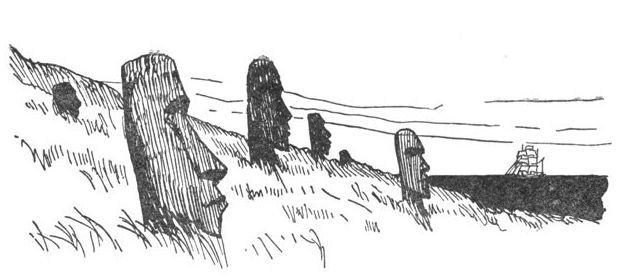
On looking at the map of the Pacific Ocean one notices how its fair surface is broken up by innumerable small islands. These, on a small-scale chart, appear to be within neighbourly distance of each other, so much so that we begin to wonder whence comes this talk of the lonely wastes of the Pacific. There are not nearly so many isles in the Western Ocean, yet one seldom hears the expression ‘the lonely Atlantic.’ But the explanation is, of course, that, compared with the colossal size of the Pacific, the islands are mere pin-points, and actually the archipelagos are separated by great distances. In those three enormous groups of islands which lie in the western half of the Pacific, the three ’Nesias—Polynesia, Melanesia, and Micronesia—are situated all of the Pacific islands that matter; but between the 145th meridian and the coastline of the Americas are found a number of lonely islands, such as Pitcairn, Juan Fernandez, Cocos, the Galapagos, Easter Island, Ducie Island, and Clipperton Island, which, while of little importance to the world without, have most romantic and interesting histories.
Micronesia, the smallest of the three ’Nesias, is made up of those islands lying to the north of Melanesia and consists of the Pelew, Mariana (or Ladrone), Marshall, Gilbert, and Caroline groups. While the Micronesian peoples are a branch of the great Polynesian race, they have certain well-marked differences, probably got from their proximity to Japan and the Asiatic mainland. They have the scantiness of beard and oblique eyes of the Malay, though in the Marshall and Caroline groups a darker and more savage type is often seen, suggesting inter-marriage with the negroid Melanesians to the south. Climate and the natural resources of the islands have, as elsewhere, influenced the development of the people. The Micronesians are of smaller stature than the Polynesians; they have lank, straight black hair and a skin of darker brown. Their state of civilization is on a correspondingly lower scale.
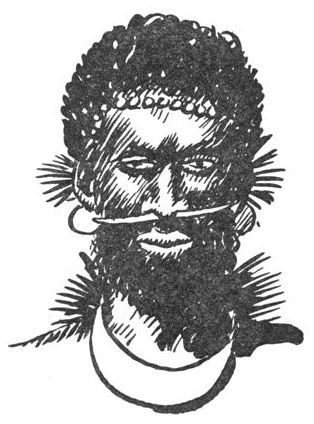
A MELANESIAN
South of Micronesia lies the larger group, Melanesia, which embraces New Guinea, the Bismarck Archipelago, and the Solomon, Santa Cruz, Louisiade, Loyalty, Fiji, New Hebrides, New Caledonia, and a few smaller groups. The Melanesian has frizzy hair, a skin more or less black, and is of the same negroid type as the Australian aboriginal. Their civilization is the lowest of the three groups, and, as is usually the case among the lower type of savages, their womenfolk are mere drudges, holding a position lower than that of wild animals.[1] The Melanesians have few traditions, speak a primitive language, and until recently practised cannibalism. Yet, like most primitive peoples, their artistic instincts are well developed.
Polynesia, to which a special chapter is devoted, embraces the whole of the islands in the western and central Pacific, and chief among these are the Phœnix, Manihiki, Union, Ellice, and Hawaiian (Sandwich), Marquesas, Tonga, Samoa, Society, Cook, Paumotu, and Tubuai groups. The Polynesians have developed far in advance of the other native races of the Pacific. They are tall, well proportioned, with a skin of light brown and glossy dark brown or wavy black hair, quite unlike the woolly mop of the Papuan. They are often beautiful by Western standards, and when not degenerate through too much Western ‘culture’ are a people who command respect.
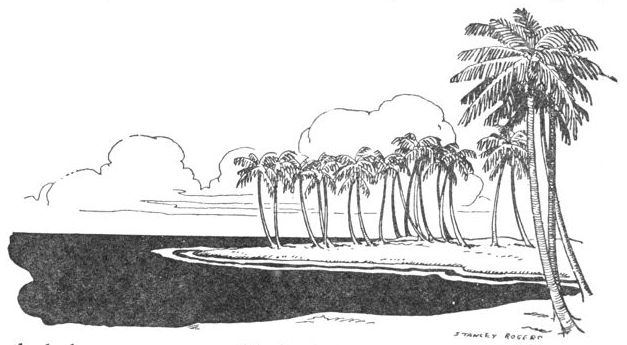
The Pelew and Caroline groups of Micronesia consist of no less than 652 small islands, and of all the isles of Oceania they are, from the standpoint of archæology, the most interesting. On some of the islands are found walls, earthworks, and canals of impressive size which must have been built by people of superior intelligence. Here is a mute remnant of a lost civilization that has exercised the minds of archæologists ever since the islands were discovered by white men centuries ago. Incidentally, it was here on one of the Pelews that the ship Antelope was wrecked in 1783, the story of which is told in Chapter X.
The Marshall Islands consist of forty-six small coral atolls ranged in two parallel lines. Coconut-palms grow on the sandy shores, and in the sparse jungles breadfruit, yam, banana, taro, and pandanus grow in profusion. The natives have copied the Western method of boat-building with such fidelity that they have in many cases built their own trading schooners.
The Marianas, first seen by Magellan in 1521, and named by him the Ladrones from the thieving habits of the people there, consist of seventeen islands, nearly all of them densely covered with jungle. Like the Pelews, the Ladrones bear substantial evidence of having been the site of a lost civilization whose mystery has never been cleared up. The name Mariana, or Las Marianas, was given in honour of Maria Anna, widow of Philip IV of Spain.
The Gilbert, or Kingsmill, group is a collection of barren atolls which, though almost devoid of soil, are more densely populated than most of the Pacific islands. The presence of so many people where Nature has been so parsimonious with her bounties is really an interesting phenomenon. What little soil there is is coral sand, in which nothing thrives but the coconut-palm. In such adverse conditions for development, isolated, as it were, on these coral atolls, denied the amenities of more favoured isles, it is not to be wondered at that the people are a savage, coarse type, living in an exceedingly primitive state and given to fighting.
Melanesia is, in point of population, the largest of the three groups, with six times as many people as in Micronesia and nearly three times as many as in Polynesia.
First, the Bismarck Archipelago consists of that group lying north and north-east of New Guinea. The names of some of its islands—New Pomerania, New Hanover, New Mecklenburg—are reminders of its former occupation by Germany, though paradoxically two of them, New Pomerania and New Mecklenburg, are also known as New Britain and New Ireland. The archipelago was named in honour of the Iron Chancellor.
The Louisiade Archipelago, named by Bougainville after Louis XV, lies to the south of the Solomons and off the extreme south-eastern end of New Guinea. There are over eighty islands and islets, the larger ones densely grown with jungle. The natives are, or were, cannibals.
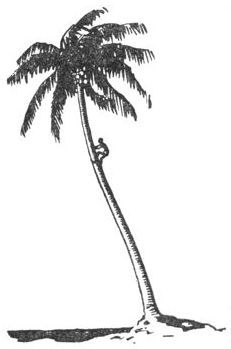
The wicked Solomons, the islands of bad repute for the treachery and murderous inclinations of the blacks there, consist of seven large and a number of small islands. They have remained so far practically untouched by civilization. Adventurers, explorers, and hunters look to the Solomons as one of the few places left on earth where life is still in the raw and savage state of the Palæolithic man. The principal islands of the group are Bougainville, Ysabel, Malaita, San Christoval, Guadalcanar, Choiseul, and New Georgia. They were discovered in 1567-68 by Mendaña, who gave them the name Islas de Salomon, in anticipation, rather than in realization, of their fruitfulness and riches. Most of them are mountainous and densely wooded, Bougainville, the largest of the islands, having a mountain of 10,000 feet.
The climate is humid and enervating. The Solomons are not healthy for white men; nevertheless, white men persist in living there, principally the managers of the estates owned by a large international firm of soap-boilers, who cultivate the coconut-palm for copra, from which oil is obtained for soap-making. The savage and treacherous character of the natives has been frequently demonstrated by the massacre or kidnapping of too venturesome white men who have gone ashore insufficiently protected by arms. A Frenchman, J. F. M. de Surville, made a lengthy stay on the Solomons as long ago as 1769, despite the active hostility of the blacks, but the name he gave the group, the Land of the Assassins, is eloquent testimony of his opinion of the people.
Lying between the Solomons and the New Hebrides is the small group of Santa Cruz. The character of the natives is similar to that of the Solomon blacks, and it was here that Commodore Goodenough and Bishop Patteson received fatal wounds. It was among the Santa Cruz Islands, off the island of Vanikoro, where occurred one of the great tragedies of the sea, the loss of the frigates of La Pérouse, which remained a mystery for forty years.[2]
Directly south of Santa Cruz are the New Hebrides, discovered by Quiros, the Portuguese, in 1606. They consist of thirty inhabited islands; but Quiros took them to be part of a great continent and grandiosely named them Tierra Australis del Espiritu Santo. Then for more than 150 years the group remained unvisited and unknown to the Western world, until 1768, when they were rediscovered by Bougainville and afterward by Cook. The archipelago includes the islands of Malekula, Tonga, Tanna, Espiritu Santo, and the Torres and Banks Islands—two small groups. The Banks group were discovered by Captain Bligh during his extraordinary boat journey to Timor after the Bounty mutiny. The natives of the New Hebrides are pretty much the same in character as their neighbours to the north-west—that is, treacherous and savage, with an incurable propensity to cannibalism.
New Caledonia and the Loyalty Islands, lying some 600 miles to the east of the Australian continent, are neighbours of the New Hebrides group, and are separated from the latter by a deep channel. Of this group New Caledonia is the name of one island (250 miles long), and Loyalty refers to the collection of small islands lying seventy miles away to the north-east, between the larger island and the New Hebrides. New Caledonia was discovered by Captain Cook in 1774, and d’Entrecasteaux explored it in 1791. The large island is noted for its great variety of tropical fruit and nut-bearing trees. Here coconut, breadfruit, banana, ginger, sago, vanilla, sugar-cane, coffee, arrowroot, rice, orange, and tobacco grow wild. The island is in truth a land of plenty where one need only step out of doors to find immediately around all the necessities of life for the trouble of taking. Turtle, fish, and shellfish are plentiful along the coast, but, in common with all the Pacific islands, there are few land mammals, and those are of the smaller kind. The scenery of New Caledonia is rich and lovely, and offers to the eye every variety of tropical landscape.
The last of the Melanesian islands is the extreme eastern group of Fiji—two large islands, Viti Levu and Vanua Levu, and a great number of small ones, about 1800 miles north-east of Sydney and 1200 miles north of New Zealand. The largest of the islands, Viti Levu, was discovered by Abel Janszen Tasman in 1643, but Cook later surveyed them, and Bligh and his boatload of castaways passed among them on the way to Timor.
The capital town, Suva, is situated on Viti Levu, and here the Southern Cross, the only aeroplane, so far, to cross the Pacific, landed after its long flight from Hawaii. This was the first stop on the journey from California to Australia.
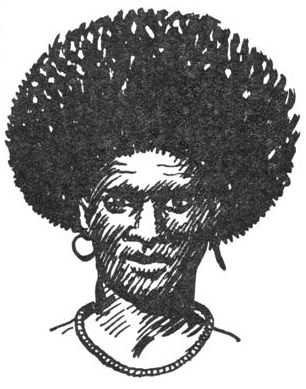
A FIJIAN
Fiji, being on the extreme eastern edge of Melanesia, shows its proximity to Polynesia in the character and appearance of the natives. Physically and mentally superior to the pure Melanesian, they have some of the savage instincts of the latter, but curiously mingled with the gentler virtues and quieter intelligence of the fairer Polynesian. In type they are negroid, with crispy hair and dark skin, but with the finer physique of the Polynesian. The Fijian, on the other hand, is more moral and has a stronger character than the lighter race. The women are more emancipated than the rest of the women of Melanesia, though they have not so much freedom as their sisters of Polynesia. In the bad old days the Fijian was an out-and-out cannibal. Like all proud, savage races, they were cruel, and the practice of human sacrifice was carried out under the most barbaric and inhuman circumstances. The people themselves were encouraged to submit to these cruelties in the belief that such a death would ensure their living happily again in another world. As everywhere in the Pacific, the institution of taboo was carried to a fantastic degree, and to this day endures with all its past significance among the older people.
The coming of the white people marked the decline of the native race. Unaccustomed to white men’s illnesses, they had no resistance to diseases they had never before experienced, and in the year 1875 an epidemic of nothing worse than measles wiped out 40,000 natives, or one-third of the population. If it is obvious that civilization confers some benefits on savage races, it is equally obvious that it brings degeneration and death in its wake. The insistence of the missionaries in covering the healthy bodies of native women with Mother Hubbard dresses was a stupid crime against nature. The native dignity of the people, along with their own highly efficient moral code, declined from the moment they donned trousers and Mother Hubbards, and by and by there will be nothing left but their graves and their handicraft exhibited in the museums of the world for their civilized destroyers to gaze at.
There are, of course, many isolated isles which lie outside the boundaries of the three great ’Nesias. At the top of a chart of the Pacific, and enclosing the Bering Sea, may be seen the chain of rocky isles known as the Aleutians. Bleak and forbidding, they rise from the sea to steep, jagged mountains over which wander the nomad Aleuts, hunting the fox and other small fur-bearers. By way of the Aleutian Islands and the narrow gap of the Bering Strait must have come the stunted Mongolian of Northern Asia to form the race we know now as Eskimos. The Aleuts are of the Eskimo family, but with a dialect and customs of their own. They also differ somewhat in mentality and character. Once a fighting race, they were crushed into a state little better than slavery by their Russian masters before the United States bought Alaska and the Aleutians. From 25,000, it is said, the inhumanities of the white traders caused the population to fall to about 1000 by 1890. The ubiquitous Captain Cook, who knew the Pacific better than any man of his time, visited and explored the Aleutian Islands during his last voyage in 1778. Russia sold Alaska, and with it the Aleutian Archipelago, in 1867 for 7,200,000 dollars, and with characteristic enterprise the new owners began to look over the string of beads which were included in the main purchase of Alaska itself. And if this string of beads were mostly barren, scrub-grown rocks of no great value, fish could be caught, fur could be trapped, and the breeding of reindeer and sheep would bring plenty where was formerly starvation.
The Aleutian chain was first sighted by Vitus Bering, a Dane, and Alexi Chirikov, a Russian, in two ships, St Peter and St Paul, sent on an exploration voyage in the North Pacific in 1741. Bering lost his life when his ship was wrecked on one of the islands that year, and the survivors reached Kamchatka in a boat they had constructed out of the wreckage of their ship.
Straight down the mid-eastern part of the Pacific, on the 130th meridian of longitude, about half-way between the coast of South America and New Zealand, lies the lonely Pitcairn Island, of the Bounty mutiny fame. Situated just within the outermost limits of Polynesia, it is without the coral reefs so characteristic of the islands to the north. It rises abruptly from the sea, a lava rock which, though only measuring two square miles in area, rises to an elevation of 2000 feet. The mutineers from the Bounty chose this island, not for its fruitfulness and charm—for compared with the lovely and bountiful Tahiti it had none—but because of its remoteness and the consequent unlikelihood of the mutineers ever being found by the long arm of the law. It was discovered by Philip Carteret in 1767, and was given the name Pitcairn after the young midshipman who was the first to sight it. The island was reported to be uninhabited and difficult to land on, and then seemingly forgotten by the world for over forty years until 1808, when an American ship, the Topaze, put in at the island, where her crew were astonished to find living a colony of half-breeds who spoke English. It will be remembered that when Fletcher Christian and his companions decided to hide themselves on the lonely Pitcairn they took with them twelve Polynesian women and six Polynesian men; but by 1800 all the white men were dead, except Alexander Smith, who called himself John Adams. Sordid quarrelling and treachery had accounted for the lives of the others.
The next ship, or, rather, the next two ships to call were the Briton and Tagus, in 1817, and there was then an interval of years until 1825, when the ship Blossom called at the island. Strangely enough, these descendants of the mutineers were themselves pious and moral almost to narrowness, so that when they were removed to Tahiti in 1831 through fear of famine on the island they so disapproved of the morals of Tahiti that they next year returned to Pitcairn. In 1856 the entire population, then increased to 194 people, were migrated to the more hospitable Norfolk Island, which lies to the north-west of New Zealand, nearly 3000 miles from Pitcairn; but in 1858 two families grew homesick and returned, and were later followed by other families. Many of their descendants live to this day on the lonely island.
Be it ever so humble——
People have wondered if the inevitable inbreeding of the islanders has not tended to produce imbecility, but from all trustworthy reports it seems that such is not the case.
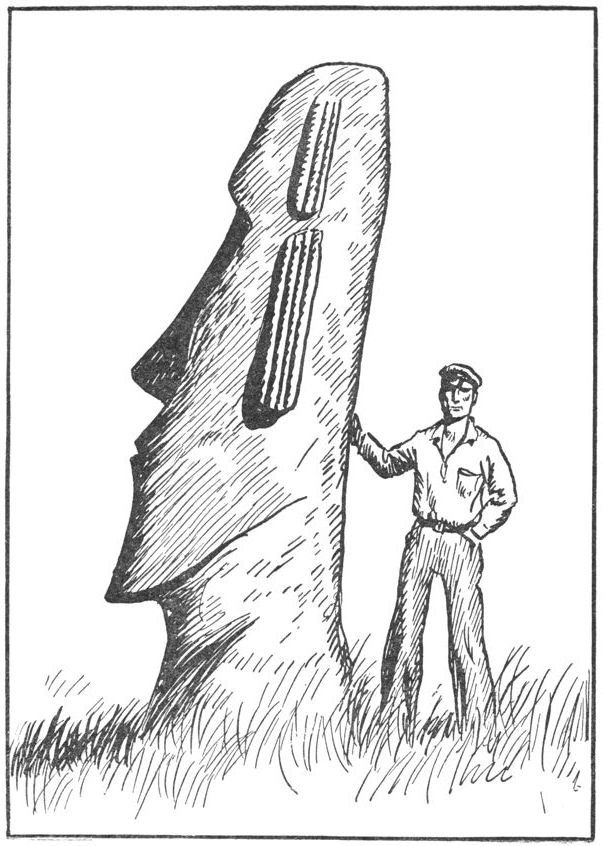
AN EASTER ISLAND MONOLITH
Out in the Pacific, a little south of due west from Pitcairn, stands Easter Island, perhaps the loneliest of all South Sea isles. Its remoteness can be imagined by its distance, 2000 miles from the coast of Chili and 1400 from its ‘neighbour,’ Pitcairn. It is twelve miles long, and rises from the coast in a gentle slope to three volcanic peaks, one of which reaches an altitude of 1768 feet. The island is inhabited by a handful of natives and Chilians, who cultivate sugar-cane, bananas, and sweet potatoes, as well as raising cattle, goats, and sheep. It was first seen by the Dutch Admiral Roggeveen on Easter Day 1722; hence its name. Captain Cook, La Pérouse, and other navigators visited it, and all were greatly interested in huge monoliths of dark volcanic stone, carved to represent human heads, which are all over the island. Many of these huge statues stand on vast platforms facing the sea, and these, along with the discovery there of ancient wooden tablets covered with incised hieroglyphic writing, have given the archæologists a mystery which they have never yet solved. Pierre Loti has written a charming account of his visit to the island when his ship called there during a voyage to the French possessions in the Pacific.

EASTER ISLAND
The huge images for the most part are strewn about the slope as if thrown by some cataclysm such as an earthquake, but a few are standing as the illustration shows. One of these statues, eight feet high, can now be seen in the portico at the British Museum. The stone platforms are vast structures from 200 to 300 feet long and 30 feet deep, built of cut stone put together without the aid of cement. They mostly face the sea, and on the shoreward side are about 30 feet high. On the inner side runs a raised terrace upon which at intervals are large stone pedestals, and it is on these pedestals that the heroic-sized statues once stood. They are from 5 to 69 feet high, though there are some smaller ones. There are also on the island several ancient stone houses 100 feet long by 20 feet wide, with walls 5 feet thick. The interiors are lined with flat stone slabs covered with paintings of animals and geometrical figures. These houses are roofed with the flat slabs of stone. The rocks in the vicinity of the houses are carved to the crude shapes of animals and human heads. The carvings, platforms, houses, and monuments belong to an ancient civilization long since extinct.
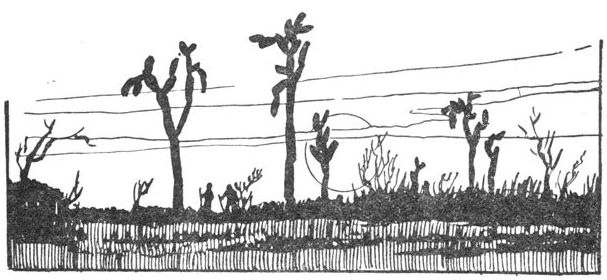
GIANT CACTUS, GALAPAGOS
On the equator, 580 miles west of Ecuador, lie the famous Galapagos, rendezvous for buccaneers in the Pacific, just as Tortuga (i.e., Turtle Island) off the coast of Hispaniola was the rendezvous for Atlantic buccaneers. And, to carry the similarity further, the Pacific islands get their name from galapago (‘a tortoise’), on account of the huge tortoises abounding there. When Darwin visited these islands he found them overrun by large tortoises, some of them veterans hundreds of years old. The Honourable Walter Rothschild heard that they were gradually becoming extinct, and, in order to preserve the species, in 1896 sent an expedition to the Galapagos to secure specimens for his private zoo at Tring Park, Hertfordshire. A remarkable thing about these giant tortoises is that there are seven different species, each isolated on a separate isle, as if in the dim past the Galapagos were one large island which became broken up by some terrestrial upheaval into small islands, causing each group in the course of thousands of years to develop specific characteristics.
Though the islands were discovered in the sixteenth century by the Spaniards, who gave them the name they still bear, some of the separate isles have English names, given to them by the Anglo-Saxon buccaneers and privateers who came later. A feature of the islands is a number of small active volcanic cones, besides many cones no longer active. Apart from the active cones, there are twenty-five dead craters, an extraordinary number, crowded into an area no greater than, say, the county of Sussex. If they were ever all in action at one time life on the islands must have been exciting for the tortoises. Another curious thing about the islands is the two different types of landscape to be seen there. Along the coasts and below 800 feet elevation the land is dry, waterless, rocky, and treeless, but above 800 feet it is thickly covered with trees and impenetrable jungle.
Though they are on the equator, the climate of the Galapagos is not excessively hot, as the Antarctic current, which runs up thus far north, keeps the temperature down to reasonable degrees. On Charles Island, the most important of the group, is a colony from Ecuador under a governor. Another, Chatham Island, has a penal colony of a few hundred convicts living in primitive conditions.
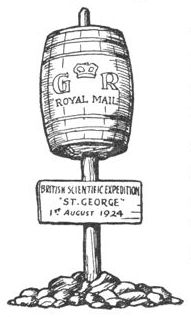
Less than a hundred years ago the Galapagos were put to a pleasant use by whalers and other passing ships. Commodore Porter, of the U.S.S. Essex, during the War of 1812 started the custom. He placed a large terrapin shell on a conspicuous point of black lava rocks to serve as the roof of a crude but practicable letter-box, and thereby inaugurated the famous Old Post Office on the Galapagos. It became the custom of whalemen to go ashore there to overhaul the letters for any mail addressed to them, and to leave letters to be picked up by other ships. The plan worked excellently as long as the old square-rigged ships sailed the Pacific. A friend of the writer’s, Mr William Stilwell, went ashore there in 1924, and erected a new ‘post office’ in the shape of a salt pork barrel on the top of a spar standing out of a small cairn of rocks. The barrel was painted red and bore the legend “G.R. Royal Mail” in yellow. The barrel was erected to replace an American one which had fallen to pieces through age and exposure.
Juan Fernandez owes its fame to that half-mythical character Robinson Crusoe, inspired by the actual experiences of the Scotsman Alexander Selkirk, who spent four and a half years of self-imposed exile there. And those who doubt the facts of his residence will find, if they take the trouble to go and see for themselves, the very cave in which he lived; and fixed to one of the rocks they will discover a tablet to his memory. It briefly recounts the facts of his landing from the Cinque Ports galley, 96 tons and eighteen guns, in 1704, and of his being taken off by the Duke, privateer, on February 12, 1709. The memorial tablet was erected near Selkirk’s look-out by Commodore Powell and the officers of H.M.S. Topaz in 1868.
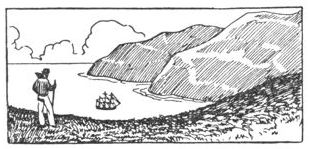
JUAN FERNANDEZ
Juan Fernandez, which many people imagine to be one solitary isle, is actually a group of three islands, two comparatively large islands, known as Mas-a-Tierra and Mas-a-Fuera, and an islet called Santa Clara lying just off Mas-a-Tierra. Mas-a-Tierra, whose name means ‘more to land,’ is a hundred miles nearer to the South American coast than Mas-a-Fuera (‘more to sea’). Mas-a-Tierra, Selkirk’s isle, is about thirteen miles long and four wide, and presents from the sea a skyline of jagged, pointed rocks; but the valleys are densely grown with luxuriant vegetation. When Captain Joshua Slocum called there in the spring of 1896 during his voyage round the world in the Spray he thought the place delightful, called it “blessed island,” and wondered how Robinson Crusoe had ever had the strength of mind to tear himself away from it.
There is only one possible anchorage inshore, Cumberland Bay, and even there it is not without danger, owing to the depth of water right up to the edge of the cliffs. But ever since Juan Fernandez was discovered in 1563 by the Spaniard whom they were named after, ship-masters have taken their vessels into Cumberland Bay and sent boats ashore to get fresh water from the innumerable torrents that course between the deep ravines in the volcanic rocks. Ships sometimes landed crews there to hunt the seal and sea-elephant which formerly abounded on the coast.
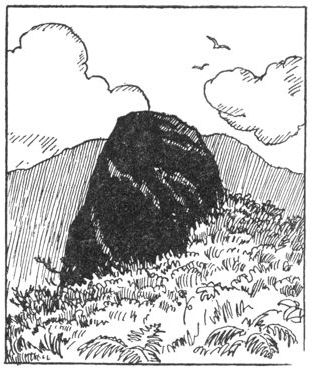
CRUSOE’S LOOK-OUT
Selkirk spoke of wild goats, but there are no indigenous land mammals; and those animals, such as goats, pigs, horses, and dogs, which may be found there in fair numbers now, have been imported from Chili since Juan Fernandez became populated with a small colony of Chilians. Fernandez, the discoverer, obtained a charter of the islands and lived there for a while, during which he raised goats and pigs, and as this was as early as 1563 it gives colour to Selkirk’s statement about the wild goats—the descendants of the original animals brought over by Fernandez. When Commodore Anson returned to England after his successful voyage round the world (1740-44) he proposed to put an English colony on Juan Fernandez; but the Spaniards, hearing of the project, had the enterprise to get there first, putting a small garrison ashore in 1750. When Chili became an independent state early in the nineteenth century the islands passed into her possession.
None of the islands I have so far described has been concerned with hidden treasure, but it is well known that islands are the fit and proper place on which to bury pirated hoards. Buccaneers may have hidden booty on the Galapagos, though I have found no evidence of the fact; but there is at least one isle in the Pacific, Cocos Island, which is about 300 miles off the coast of Costa Rica, where, it is said, there is still lying buried ten or twelve million dollars in treasure left there by nineteenth-century pirates. Cocos Island should not be confused with the Cocos-Keeling Island in the Indian Ocean, the scene of the Emden’s last stand.

WAFER BAY, COCOS ISLAND
The island itself has no feature of outstanding interest. It is small—about three miles long by four miles broad—and is girt by steep cliffs rising to a plateau covered with small trees. From the plateau rise two peaks, the higher one having an elevation of 2788 feet. The island lies in the Pacific Doldrums, and is frequently deluged with heavy rains. Its steep shores and absence of good landing-places make it a place rather to be avoided than sought out. Nevertheless, for the past hundred years it has been a magnet to attract adventurers. Until the pirates had left the Lima treasure there no one but sailors had ever heard of Cocos; now half the world must be familiar with its latter-day history. Though the treasure has not been found, the area about Wafer Bay on the north side of the island has been picked, scraped, sifted, shovelled, and blasted out of all likeness to its former appearance. Ever since the Cocos secret got abroad expeditions have been arriving and leaving, sometimes two rival treasure parties being there together, when feeling has run high and the monotony of digging has been livened by the smouldering jealousies of opposite camps.
That it was the rendezvous of buccaneers in Dampier’s day there is no doubt, for we have the evidence of Dampier himself; but whether those pirates left more than a negligible quantity of booty there is doubtful. We have good reason, however, for believing that an enormous treasure hoard was left there at a much later date, and that it still remains for some son of fortune to come upon one day. This treasure I refer to is that stolen by that cold-blooded opportunist Captain Thompson, of the Mary Dear,[3] who had on board his vessel a number of wealthy refugees, along with their gold, from the city of Lima in the year 1821. There is more than one version of this story, but they all agree over its principal features—the amount of the treasure, its hiding-place, and the identity of the principal villain. The value of the treasure was about twelve million dollars, and the greater part of it was buried somewhere near Wafer Bay on Cocos, and was left there while Thompson and his rascals sailed away until the uproar over the loss had died down. Unfortunately for the precious captain, circumstances—ill-luck—prevented his going to retrieve the treasure until he was a feeble old man, and then only by letting another into the secret. A small vessel was obtained, and, with a few hands, who were not told the real object of the voyage, they sailed for Cocos. Arriving there, they found the hoard after almost giving up the search, but Thompson never profited by his bloodstained wealth. He dared not trust the crew, dared not take the money on board; so the partners agreed to sail away and return secretly with the smallest possible crew. Old Thompson was not going to take any chance of losing a penny of his part of the hoard, but the ironical gods of fortune willed that the old scoundrel should die before he could return to the island. His partner, a man named Doig, sailed with his son to Cocos to dig up the loot, only to find that a landslide had buried the spot under thousands of tons of earth. The difficulties of excavating so much material disheartened them, and they sailed away, the father being drowned a short time after and the son never returning to the island. When he died, a poor man, he left very explicit directions where the treasure lay, and when these directions got known there began the succession of expeditions to the island which have continued with long or short intervals ever since.
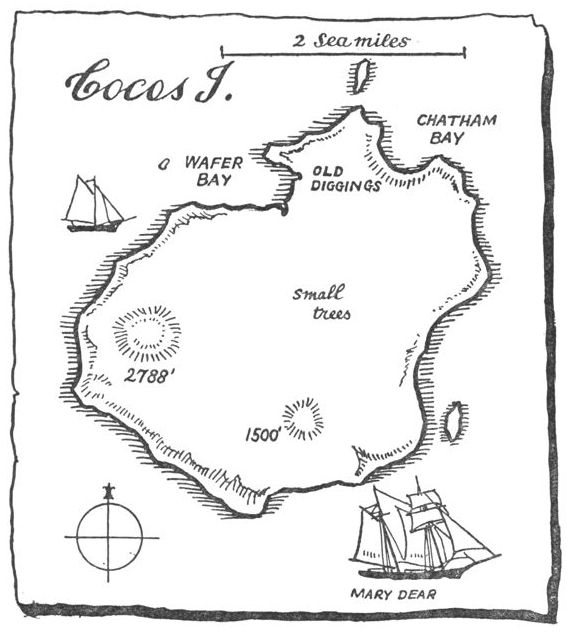
In the middle of the nineties of the last century a warship of the British Navy, H.M.S. Haughty, actually dropped her hook off the Cocos shore, while half her officers landed with explosives and digging tools—a little treasure-hunting diversion. The captain of this man-of-war caused something of a scandal in naval circles by allowing this, and on his return to England was hauled over the coals for his escapade. A few years later, when he had left the service, he took out a small expedition composed of enthusiasts, who, however, after digging up a lot of earth returned home empty-handed.
Cocos by this time had become permanently inhabited. A man named Gissler and his wife lived there for over twenty years, a hermit-like existence whose perfect solitude was sorely marred by the transient visits of noisy, blaspheming, rough fellows who tore up the earth with explosives and picks, until they took themselves off empty-handed and cursing the spot that Gissler had chosen in preference to all others to be his home.
Others have followed the naval men. One, a wealthy lord, whose wealth must have been greater than the amount of the treasure he sought, actually purchased a liner, the Union Castle liner Harlech Castle, and took a number of friends who were glad to escape the boredom of club life for a romp on a treasure island. Two other expeditions were there at the same time, and feeling ran so high between the rival parties that it was almost a miracle there was no bloodshed.
One of the parties there about this time was Captain Voss, who afterward became world-famous for his amazing voyage round the earth in a canoe. Voss was told that the treasure amounted to 35,000,000 dollars, weighed 50 tons, and would require a fair-sized vessel to carry it away. He met Gissler and his wife there, and Gissler told him that the Costa Rican Government (who owned the island) had no objection to treasure-seekers landing so long as they (the Government) got a one-third share of anything valuable found. Voss’s 10-ton cutter Xora was nearly lost by going on a reef in Wafer Bay, but was eventually got off, though most of the gear and provisions were lost. It is hardly necessary to say that Voss returned home like all the rest—without finding the treasure.
|
The Fijians are an exception to this. |
|
The story is told by the present author in Ships and Sailors (Harrap). |
|
Also known as the Mary Read and the Mary Dyer. |

Polynesia is the very best of the Pacific. White men go to this remote fairyland of enchanted isles and return home reluctantly. In Polynesia atolls, sylvan isles, white sandy beaches, coral seas, waving palms, and blue lagoons are not merely the romantic fancies of painters and literary folk. Little wonder the Polynesian man, for all his fine qualities and splendid physique, is an indolent lotus-eating fellow compared with the more energetic Melanesian! In Polynesia Nature has been too bountiful to her children. They have no need to labour, tilling the soil and hunting for food. They have only to stretch out their hands and take what they desire. There are no wild beasts in these Pacific Edens to drive the natives into kraals at night for safety. No snow, no frost, no coal, no dirt, no criminals, no politics, no police, no greed. It is not surprising that some white men have sacrificed all the amenities of Western civilization for the peace of these exotic isles.[1]

Some travellers see nothing but the worst side of the islands, and return to tell of the degeneration of the natives and the sordidness of life there. While that is true in most of the ports, where the effect of civilization on native life has been all to the bad, in the hinterland, beyond the sound of the sea, in the jungle-grown mountain valleys, and in the smaller islands the Polynesian still lives little differently from what he did in the Arcadian days of yore. The ports in Polynesia are like most ports—polyglot, bastard places, neither foreign nor native, pinchbeck towns where the simple natives ape the white invaders’ ways. But the two won’t mix. A Polynesian, naked or at most with a lava-lava, looks a king, but in a pair of trousers he looks pathetic. The ways of the white and the ways of the brown are inimical to one another. One must go to the wall, and it will inevitably be the brown. His race is rapidly dying out through consumption and other diseases of civilization.
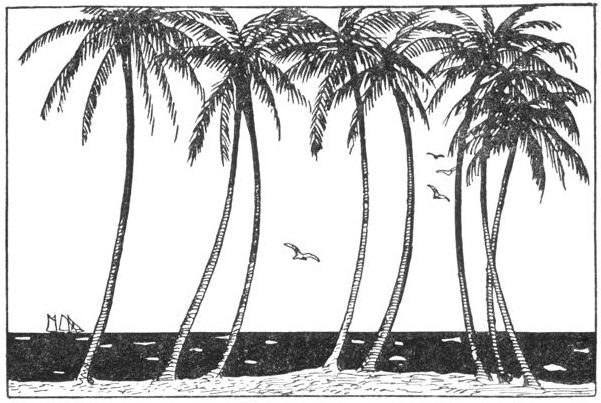
The name Polynesia covers practically the whole of the isles in the Central and Western Pacific, which is by far the largest of the three island-groups of Oceania. The origin of the Polynesian race has never been satisfactorily explained, though it is thought that they must, in the very remote past, before history, have come from the mainland of Asia, venturing to sea in large double-decked boats which were built up of planks fastened on to frames and caulked. Such boats were built by the natives until quite recently. Slowly, over a period of hundreds, or perhaps thousands of years, they would venture farther and farther to the eastward until they came to their most eastern resting-place, the Hawaiian Islands. No doubt others ventured from there, only to be lost in the waste of waters beyond. And if, by chance, any survivors reached the coast of North America they would have been in such negligible numbers as to have had no effect on the evolution of the American Indians. In support of this theory of migration across the Pacific from Asia it is known, for instance, that the ancient Polynesians possessed a culture far more advanced than that of their descendants, and that they had a highly developed knowledge of the stars, an invaluable aid to navigation.
Physically they are our peers, and among the tallest people in the world. Pierre Loti wrote of them, “cette race maorie qui peuple les archipels polynésiens et passe pour une des plus belles du monde; race distincte et mystérieuse, dont la provenance est inconnue.” Their colour is brown with hair dark brown or black, and curly. Their features are generally regular, the men especially being handsome even by European standards. In habits they are scrupulously clean, and the passion for bathing is universal. Until white civilization came among them they were content to wear simple, hygienic garments—the lava-lava for men and the grass- or leaf-skirt for women—nothing more. The men were usually tattooed around the mouth and eyes and from the waist to the knees. One remembers how, in Typee, Melville tells of his friendly captors’ efforts to get him to consent to being tattooed, and how terrified he was lest they should insist and thus disfigure him for life.
The essential trait of the Polynesian character is cheerfulness, the cheerfulness of children. They sing and play their lives through and leave worry to the white intruders of their happy valleys. They are intelligent and brave, and their women are vastly more respected than is the case among most savage races. The reason for the relatively high position occupied by the women probably lies in the fact that the Polynesian is a lover. He is, however, frequently fickle in his loyalties, especially to the white man, whom he will desert without provocation. His women are charming, coquettish, feminine creatures so different from the ugly hags of Melanesia. The morality of the Polynesians varies; in some groups it is very strict, in others it is extraordinarily lax. The people live in clans, but among the clan all property is held in common.
Communism is a workable thing among these people, but that is only because they have no sense of possession as we understand it. Even their children are shared among the family’s relations.
They worship gods and spirits, and believe in the existence of the spirit after the death of the body; their elaborate system of taboo is closely connected with some of their religious rites.

EXAMPLE OF POLYNESIAN ART: SYMBOLIC WOOD-CARVING
In craftsmanship they were (I am speaking of a period bordering on modern times) highly skilled, but suffered the great handicap of having no metals to work. This meant that they had nothing in which to boil water, hence all food was baked. Their knives were made from bamboo, sharks’ teeth, and shells. Hatchets and adzes were of stone, fishhooks of bone, spears of wood, drinking vessels of gourd and coconut shells, and cloth of bark. They made, and still make, very beautiful mats and baskets of fibre, which are stained in varied patterns with vegetable dyes. They never discovered the art of making pottery, possibly because they never had need for it.
In the hot, moist airs of Polynesia vegetation grows not only more profusely than in more temperate climates, but to a greater size. The tropics of Polynesia seem to have been fertilized with H. G. Wells’ “Food of the Gods.” Here are enormous breadfruit, sago, coconut, cabbage, and areca-palms.[2] The coconut, which is the commonest of the palms, thrives best near salt water; hence the profusion of these palms on the atolls and along the sandy shores of the islands. This tree, which grows up to a height of a hundred feet, is crowned with a feathery plume of enormous fronds sometimes 20 feet long. The coconut grows in bunches of from ten to twenty, and is encased in an exceedingly tough fibrous outer covering, which has to be stripped off before the coconut can be broken up for copra or shipped abroad to become the familiar coconuts of country fairs.
The wide distribution of the coconut-palm over the islands of the Pacific is explained by the character of the nut, which in its watertight outer husk will float for a long period without becoming waterlogged, thus permitting the seed to travel great distances by sea. Such floating nuts are washed up on the shores of distant isles, where they readily germinate.
If the coconut-palm is the king of Polynesian trees the breadfruit is the queen, for it is hardly less important to the islanders than the coconut itself. As a food staple it is even more valuable, and, like our bread, is the staff of life in the part of the world where it is found. Unlike the coconut, which is found in both hemispheres, the breadfruit is indigenous to the South Sea islands. The fruit is spherical in shape and grows to the size of a small English melon, but varies considerably, for there are several varieties. As the different varieties ripen at different periods of the year the supply of the fruit is practically constant. It is usually picked just before it is quite ripe, when it is considered best for food purposes. Alfred Russel Wallace described it as being superior to any other vegetable he knew of, and spoke of eating it with “sugar, milk, butter, or treacle” as a dessert, or with meat as a substitute for potatoes.
The natives prepare the breadfruit in a number of curious ways. One recipe is to store it until it ferments into an evil-smelling mass of doughy consistency, when it is baked among hot stones. This brings about such a remarkable chemical change in the fermented fruit that what was an offensive, decaying mess becomes a most agreeable and healthy food. Sometimes it is sliced and dried in the sun and afterward ground into a sort of flour, or else baked whole after drying. A common, and delightfully simple, way of preparing it is to put the ripe fruit, just as it comes from the tree, into hot embers, and after it is more or less baked scoop out the interior, which tastes very much like potatoes mashed in milk.
This fruit has interesting historical associations. Dampier first described it in 1688, and when Captain Cook explored Polynesia he advised the British Government to transplant a number of trees to the West Indies. This recommendation was later acted upon when the Government, in 1787, sent out the ill-fated ship Bounty under Lieutenant Bligh to Tahiti, to carry the plants from there to the West Indies. It was after the young trees had been gathered and put on board that the famous mutiny broke out which gave the world something to talk about for many a day thereafter.
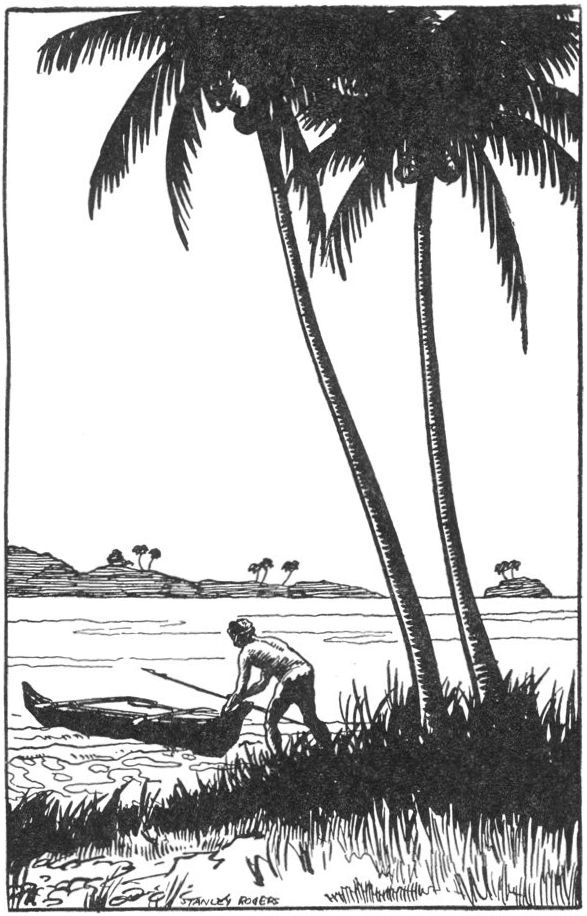
HAWAII
The best-known of the islands of Polynesia is the Hawaiian group, so unæsthetically named the Sandwich Islands by Captain Cook. Situated on about the 20th parallel north of the equator, they are only just within the tropics. A little farther north and the Hawaiian Islands would have had the cooler climate of the Temperate Zone. But in Polynesia even those isles on the equator itself are cooled and made bearable for white men by the winds from the Pacific. The Hawaiians, which belong to the United States, are 2000 miles from San Francisco and 3000 from Fiji. Incidentally, these two vast hops were spanned by the monoplane Southern Cross in its flight across the Pacific in 1928. The Hawaiian Islands were probably known to the early Spanish venturers, but, to our certain knowledge, Cook was the first European to see them, and to him goes the credit of their discovery, though he was not to live long enough to enjoy the fruits of his work, for this last jewel in the crown of his fame was to cost him his life at the hands of the very people he had befriended.
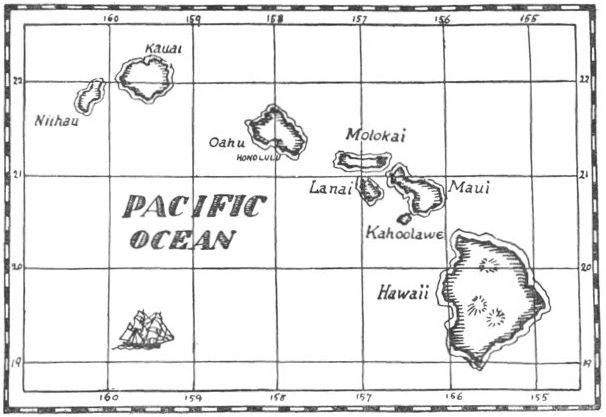
HAWAIIAN ISLANDS
The group consists of a chain of eight inhabited and several uninhabited islands, the names of the former being, in the order of their size, Hawaii, Maui, Oahu, Kauai, Molokai, Lanai, Niihau, and Kahoolawe. On Oahu lies the principal port and town, Honolulu, now a busy American city, and on Molokai is the famous leper settlement, of which more presently. The islands can boast of several active volcanoes, though the craters are so large that they usually erupt and discharge lava without any particular disturbance; though something more than fifty years ago one[3] of them erupted a two-mile-wide stream of lava which flowed for fifteen months!
On the island of Hawaii are Mauna Loa, or Great Mountain, and Mauna Kea, or Snow Mountain, so named from the snow on its summit. The latter has a height of 13,823 feet, which is a little higher than Mauna Loa. There are no taller mountains on any island in the world, and they are therefore the highest elevation in the Pacific.
Honolulu, the focal point of the Hawaiians, is the capital, and possesses one of the only two safe harbours in the islands, the other being Pearl Harbour, now a United States naval station, six miles from Honolulu. The city itself is too exotic, too modern, too commercialized to belong to Polynesia. A mixture of Kansas City and New Orleans, of San Francisco and Shanghai, with a tropical background will picture Honolulu. There is a large Asiatic population there which far outnumbers the Hawaiians, for in Honolulu, as everywhere in Polynesia, the natives are dying out before the march of ‘progress.’
Four miles from the centre of the town, along the coast toward Diamond Head, is Waikiki Beach, immortalized in our contemporary jazz songs. It is here that the thrilling pastime of surf-board riding is seen at its best. The long rollers of the Pacific are particularly suitable for the sport, which the natives had brought to a high art long before white men had ever heard of it. Lying or standing on a board six feet long by two feet wide, a skilled surf-rider will slide down the front of a big wave and race half a mile toward the beach at a breathless speed. Success at the sport requires judgment in seizing just the right moment to begin the swift glide shoreward. A half-second too late or too soon means failure, and possibly a stunning blow on the head or body from the surf-board. The swimmer, pushing his board in front of him, swims out through the breakers until he is some distance from the shore, when he turns his back to the incoming seas, and, lying partly on the board, gently paddles in the trough of the rollers until one comes along which he chooses to ride in on. He then paddles forward as hard as he can, and if the time has been judged nicely the big roller will carry him along, he slipping, as it were, down its front slope without ever reaching the bottom. A really skilful surf-rider will draw himself forward along the racing board, then carefully get his bent knees under him, and from a kneeling position raise his body until he is standing erect. Only the experts can do this.
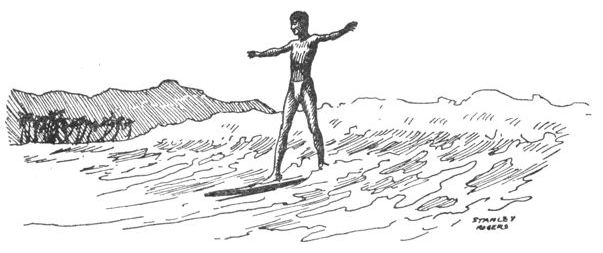
SURF-RIDING
With the island of Molokai the name of Joseph de Veuster, better known as Father Damien, will for ever be associated. This young Belgian priest gave his life for the spiritual and physical welfare of the Hawaiian lepers. Despite his selfless devotion to this work of mercy, there were people who tried to harm him, and it was the pen of Robert Louis Stevenson that eventually silenced further slander. When Father Damien went to Molokai the lepers were far less fortunate than they are now. Left to take care of themselves, they lived like animals in the utmost squalor and misery until the young priest set about putting the house in order and instituting a sense of cleanliness and discipline in the wretched community. For ten years he fearlessly went among the lepers without catching the terrible disease, and even when, at last, his skin showed signs of leprosy he took no proper precautions. He lived for another twelve years, the leprosy he had become infected with slowly destroying his body until at last he died a hideous death.
The leper settlement is a vastly different place from what it used to be. It is hardly an exaggeration to say that it is a happy place. The lepers are well fed, clothed, and housed, and looked after by a staff of American doctors. In the two villages on the island there are clubs, schools, and churches. Many of the lepers are comparatively well off and own houses, carriages, horses, and boats. The population is mixed, but is made up mostly of natives or half-bloods, the rest being Portuguese, Chinese, Negroes, and Americans. The climate is so delightful on Molokai that a considerable number of non-lepers choose to live there, these being native helpers, physicians, ministers, and Franciscan sisters and brothers.
The lepers live just as other people do. They follow their trades, and have recreations similar to those of other people. The social life of the island is brightened by the Athletic Club and the Rifle Club, and at frequent intervals relatives are allowed to visit the lepers, living, while on the island, in clean, disinfected guest-houses. The lepers know just what their fate will be, but they are too busy working and playing to worry overmuch. The disease marches rapidly if neglected, but can be delayed by modern treatment. Meanwhile the doctors are searching for the cure which sooner or later must come.
Between the Hawaiian Islands and the large groups south of the equator are scattered a number of small and lonely islands which come within the area of Polynesia. Due south of Honolulu lies Fanning Island, the British cable station, a low-lying coral ring six miles wide and twelve miles long covered with coconut- and pandanus-palms. Its highest point is no more than eight feet above the sea-level. Owing to its low position, it is not sighted by approaching ships until they are comparatively close to it. The handful of white people there are all employees of the cable company. During the Great War, while the German raiders were at large, they had a harrowing time.
Just south of Fanning Island is Christmas Island, three degrees north of the line, and with a circumference of 100 miles, one of the largest atolls in the Pacific. The lagoon is noted for its pearl-shell beds. The atoll was uninhabited and treeless until a private company planted it with coconut and developed the copra industry. It is now leased by a famous soap firm. It was discovered by Captain Cook on Christmas Day 1777; hence its name.
Still farther south is Penrhyn Island, a dependency of New Zealand and lying 735 miles from Rarotonga, in the Cook Islands. It is a ring of coral 48 miles in circumference, and is said to be the most perfect example of an atoll in the Pacific. This brings us to the interesting archipelagos below the equator, the true South Sea islands. The largest of these groups is the Low Archipelago, better known as the Paumotus, which consists of seventy-eight atolls. Adjoining the Paumotus is the smaller group known as the Gambier Islands, which differ from the former in having a much higher elevation, since the wooded peaks of the largest island, Mangareva, rise to 1300 feet. The isles of Pitcairn and Ducie run south-east in a line with the Paumotus as if they were once part of the latter. The name Low (also called Dangerous) Archipelago comes from the very low elevation of the atolls, which are almost invisible at a distance, especially as there are very few trees on the atolls. The water in the lagoons is so clear that it is almost as if water was not there at all. Below, on the shallow sea-bed, can be seen truly amazing submarine ‘landscapes.’ Exotic rainbow-hued fish swim in and out of bright red and blue coral grottos, or through the gently waving fronds of sea ferns which sway upward from among the brightly coloured shells on the bottom—a veritable submarine Aladdin’s Cave.
The climate on the atolls is healthy, thanks to the winds from the sea—in this case the easterly trades. In the stormy season, which begins in November and ends in March, the islands are occasionally swept by terrible hurricanes which uproot palm-trees and level the native houses. Since there are no indigenous land mammals, save rats, on the islands, the natives were mainly vegetarian until the arrival of the French, who now occupy the archipelago. On some of the atolls grow coconut, pandanus, pineapple, breadfruit, and bananas, all but the first two having been introduced from Tahiti. While the land thereabouts is so meagrely stocked with animal life, the sea and lagoons swarm with all manner of fish, crustaceans, molluscs, and turtle, and valuable banks of pearl oysters line the bottom of some of the lagoons.
To the south-west of the Paumotus lie the Tubuai, or Austral Islands, which, it is said, were bought in 1881 by the French from a native king for a suit of clothes and a gallon of rum. Though the archipelago is well watered and fertile, producing coconut-palms and bananas, it lies too far south of the equator to grow breadfruit. On the island of Oparu have been found the remains of stone platforms and walls resembling the mysterious platforms on Easter Island, nearly two thousand miles away to the east.
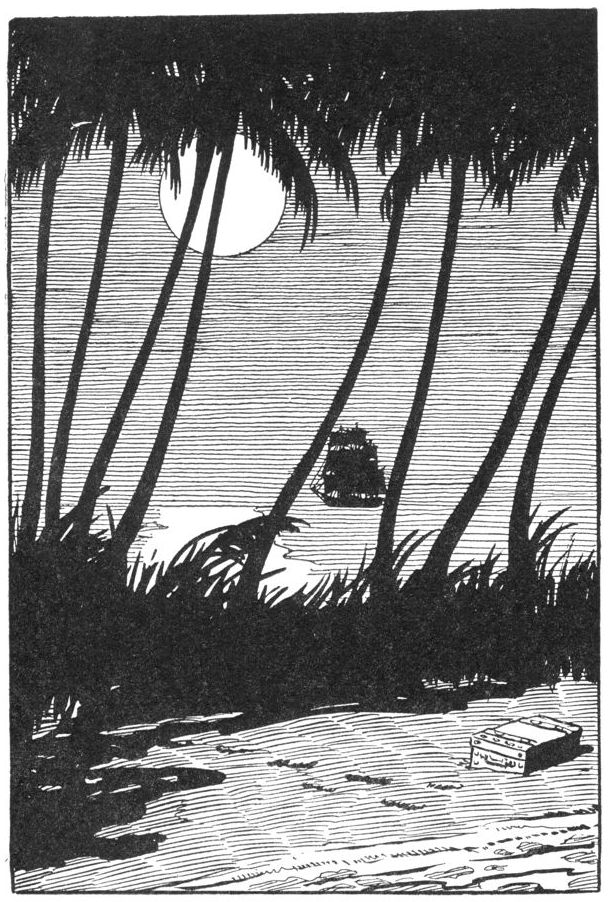
POLYNESIAN NIGHT
On a line with the Austral group are the Cook Islands, of which Rarotonga, where the New Zealand representative lives, is the most important. The natives, who are of Polynesian stock, have legends that their ancestors, who came from Samoa, found black people on the islands, and this is borne out by the strong Melanesian strain evident in some of the natives. The archipelago, which was discovered by Captain Cook, was formally annexed by the New Zealand Government in 1901.
The Tonga, or Friendly, Islands lie close to the Fijis, and just within the western limits of Polynesia. Though there are about a hundred islands in the group, they are so small that their total land area is only 385 square miles. In the middle of the nineteenth century volcanic eruptions frequently terrified the islanders, and much damage was done. During this period an island rose out of the sea, and was named Wesley, but shortly after being named quietly sank back whence it had come. The natives of Tonga are, with the single exception of the Hawaiians, the most intelligent of the Polynesians, and their amiable character is testified by the name, Friendly Islands, which Cook gave to the archipelago. It is significant that these islands have been the last native state to relinquish their independence to the white race. They became a British Protectorate under a native flag in 1900.
Belonging to the Friendly Islands is one of the most curious and interesting islands in the world. This is Niuafou, known by traders as Tin Can Island. This name originated from the custom of floating the mails ashore in a sealed tin can when the weather made the coast inaccessible for ships’ boats. Steamers throw over the tins containing the mails to leeward, and natives swim out to pick them up. Niuafou is of volcanic origin, and forms an almost perfect circle, roughly three miles in circumference. Being a volcanic atoll, its central lagoon is really a crater. This rises a hundred feet above the sea, and is filled with brackish water. In this it is quite unlike the coral atolls, the lagoons of which are salty and at sea-level. Subterranean upheavals are constantly at work there, and in the summer of 1929 an unusually severe eruption destroyed one of the only two landing-places on the island. The eruptions occur about every twenty years. Not only was one of the landing-places destroyed, but about a third of the cultivated ground on the island disappeared. This was a serious blow to the inhabitants, whose lives depend so much on what they can grow. There are about 1250 natives and less than half a dozen whites living on this tiny volcanic ring, which is a great distance from its nearest neighbours. Though of the Tongan group, it is isolated from the rest of the group by about three hundred miles of sea. It lies almost equally distant from Samoa, Fiji, and the Tongan group, but fortunately—or unfortunately, depending upon how you look at it—it stands in the direct steamship track between Samoa and Fiji. In the autumn of 1930 two scientific expeditions, one from New Zealand and the other from the United States, went out to Niuafou to make observations of the total eclipse of the sun which took place there on October 21.

POLYNESIA
About 150 miles north of Tonga is Samoa, whose fame owes something to Robert Louis Stevenson. The group consists of fourteen islands, which share with the Society Islands and the Marquesas the distinction of being the most beautiful of all the South Sea isles. In the forests of Samoa grow every variety of the coconut-palm and the breadfruit-tree, which form, with fish and pork, the entire menu of the natives. The Samoans, like the Tongans and the Maoris of New Zealand, are a fine, virile race, the men being courageous fighters and physically perhaps the most perfect type of Polynesian. The average height of the men is 5 feet 10 inches, which is considerably taller than the average Englishman. The tribal customs and religious rites are, or were, similar to those of the rest of Polynesia, though they have, as elsewhere in the Pacific, abandoned most of their ancient beliefs and customs and assume the ways and religion of the white man. Samoa lies in the path of the terrific hurricanes which visit this part of the world between January and March every year; and in the last chapter of this book I have given an account of the unforgettable hurricane which wiped out the shipping in the harbour of Apia in March 1889, when several warships which happened to be there were wrecked with great loss of life.
Jacob Roggeveen, the Dutch navigator, is supposed to have been the first to sight Samoa during his Pacific cruise in 1722, but it was Bougainville who, in 1768, first definitely plotted them on the chart and gave to them the name which is still used by sailors—Navigators’ Islands (Iles des Navigateurs). It was here that nineteen years later La Pérouse lost de Langle, commandant of the Astrolabe, and eleven others during a fight with the natives. It is on the island of Upolu that Stevenson’s house, Vailima, still stands under the towering Mount Vaea.
Comparable to lovely Samoa, if not actually superior to it, is Tahiti, in the Society Islands, which lie to the eastward of Samoa and close by the Paumotus. The archipelago is made up of two groups, named by the French Iles du Vent and Iles sous le Vent—i.e., Windward and Leeward Isles. They were first seen by Quiros in 1606, after which they were lost to white men until 1767, when Wallis rediscovered them, or, to be more exact, rediscovered the large isle, which he named King George the Third’s Island. A year later Bougainville came that way, and, claiming it for France, poetically named it La Nouvelle Cythère, which reflected his opinion of the island. In the following year (April 1769) Captain Cook, with his collection of scientists in the expedition sent to observe the transit of Venus, arrived there, and gave to the Leeward group the name Society, after the Royal Society, at whose instigation the expedition had been dispatched. This name has been retained for the whole group ever since, but Bougainville’s La Nouvelle Cythère is now known as Tahiti, which Robert Keable, the novelist, called the “Isle of Dreams.” Tahiti is 33 miles long, and shaped something like a figure 8, the narrow isthmus which joins the two portions being nowhere more than a mile wide and impassable at high water. The entire island is mountainous, with the exception of a strip of flat jungle-covered terrain along the coast. The highest peak rises to over 7000 feet, a good elevation for such a comparatively small island.
The Tahitians are perhaps the most interesting of all Polynesian peoples. In spite of licentiousness and degeneration from association with traders, sailors, and corrupt Europeans, the Tahitians—what is left of them—still retain much of their ancient heritage of physical beauty and virility. The men often reach a height of over six feet, and their bodies might have been models for the Greek sculptors. Their skin ranges from dark brown to olive, and their wavy hair and deep, intelligent eyes are black or brown. The nose is straight and the chin well formed; the mouth, though large, is shapely and not too full.
In character they have been described as brave, generous, courteous, and care-free, but also treacherous and cruel. Never specially strict in their moral outlook, the advent of the Latin invaders further encouraged them in a way of life which as long as they lived in primitive state did them no harm, but now is contributing to their degeneration. For some remote reason the Tahitians were never cannibals, as were so many of the natives of the South Seas.
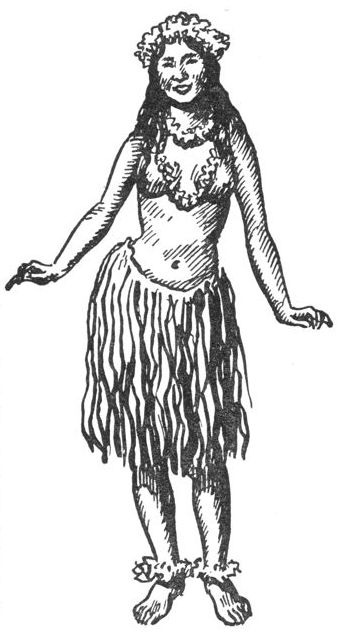
The name of Paul Gauguin, the French artist, will for ever be associated with Tahiti. By occupation a stockbroker, but by nature a rebel, he suddenly left his work and his family and sailed for Tahiti, where he lived for some years according to his tastes, his mind in Arcadia, his body in squalor. This eccentric painter, who arrived in Tahiti in yellow shoes, white clothes, a red cravat, and a green hatband, and preferred the natives to the whites, wrote that civilization was falling from him “little by little,” and vowed that peace was descending upon him. But his soul never knew peace, and after ten years at Tahiti he went, at the age of fifty-three, to the Marquesas, where he died miserably two years later. He respected neither man nor God, boasted that he was a savage, and lived like the natives, in a half-nude state. All he desired of life was painting materials, strong drink, and spiritual freedom, and it must be said that he got them all. He died in debt, and his pictures were sold in Papeete[4] at miserably low prices. There was something ironical about the last picture he painted: it was of a winter scene in Brittany with the snow lying deep on the ground. Another Frenchman whose name was associated with Tahiti was Pierre Loti, to whom I shall refer later.
The last of these Polynesian islands, the Marquesas, are, like the Society group, under the French flag. They consist of eleven mountainous islands and a number of islets, which lie 900 miles from Tahiti north of the Paumotus, half-way between them and the equator, and in the very heart of the tropics. But the climate, though humid and hot, is, because of the trade winds, not unhealthy for white people. In character and scenery they resemble Samoa. Herman Melville, in his autobiographical story, Typee, gives an interesting account of the Marquesas, especially the principal island of Nukahiva, where he spent an enforced stay among the Happa cannibals.
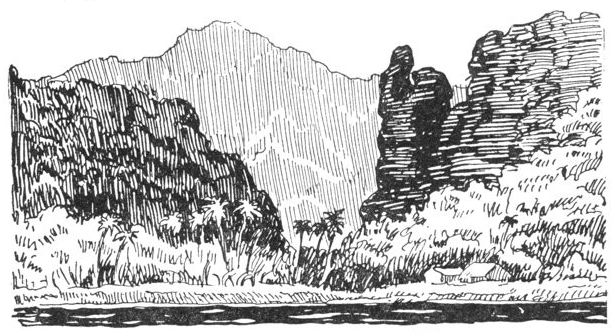
VALLEY OF FATU HIVA, MARQUESAS
The Marquesas have their staunch supporters, who claim that the Marquesans are bigger, braver, more handsome, and more intelligent than any other Polynesian race. Certainly travellers to Nukahiva speak in superlatives about the island and the people, who live as near to an Arcadian existence as seems possible in this world. Olive-skinned maidens and handsome young brown-hued gods plunge in the surf or frolic in the happy valleys, wild, shy, laughing, care-free children. Here is the poets’ paradise where the world is forgotten and well lost. Here love and laughter once reigned, with an occasional combat among the men by way of a change from the more important business of play. For, apart from fighting, there was little else to do but play in a land where breadfruit and coconut grew in abundance and without the trouble of cultivating them, and where the airs were so warm that every one went about naked, and clothes were more a convention than a necessity.[5]

THE MARQUESAS
And yet these charming people were cannibals, without even the excuse of eating human flesh as part of their religious rites, as some of the other Polynesians did. The word ‘cannibal’ seems impossible applied to these lovable people; but anyone who has seen a pretty Marquesan maiden pick up a small live fish and put her white teeth into its wriggling body as she eats the still living creature can understand how the Marquesans could be cannibals.
The people have a code of good manners that is as punctilious as any other in the world. If you offer a Marquesan a gift he will affect to forget it, but he will expect you to offer it again before he departs. This and other formalities equally strict are as much part of his code as is his religion. He is modest, but he has a fierce pride which never forgets an insult or a slight. His customs and his way of living differ in many particulars from those of the people of other islands of Polynesia. In Hawaii the native dwellings were made of grass on a wooden framework, in Tahiti the flimsy huts resembled bird-cages, and the Samoans built a sort of open shed which could be closed with a primitive sort of Venetian blind; but the Marquesan built, and still does when not living in a civilized house, a paepae-hae, or dwelling-platform, 25 to 50 feet long and of black volcanic stone, over which he erected an open-fronted house which was his home. In this community dwelling lived and slept as many people as it would comfortably accommodate, and if it had certain structural shortcomings it had at least solid foundations.
|
Alain Gerbault, the famous lone yachtsman, after returning to France in 1929 from an around-the-world voyage, vowed that he would return to the Pacific to buy an island in Polynesia and spend the rest of his life there. |
|
From the areca-palm comes the betel-nut. |
|
Mauna Kea. |
|
The European town on the island. |
|
This idyllic condition no longer exists. |

The first trade-route across the Pacific must have been that of the Manila-Acapulco galleon, which for many years made the annual traverse from the Philippines to Mexico with treasure destined for Spain. This trade had been fairly regular until the belligerent Drake inaugurated the game which afterward became so famous, the game of attacking the Acapulco galleon. Commerce between Manila and Mexico became more and more perilous after the privateers and pirates got to know of the easy pickings to be had in those waters; until at last the trade was abandoned, and the Pacific saw few merchantmen for the next hundred years or so. It is true that the Spanish ports in South America carried on a desultory trade with Asia, but it was not until the start of the Californian gold-rush in 1849 that regular commerce on the Pacific really began. Some years before that Captain Robert Waterman, the notorious Bully Waterman, took the early clipper Natchez round the Horn and across the Pacific to Canton for tea. That was in 1843. There followed several more passages, and one in 1845-46 from New York direct to Hong-Kong was made in 104 days—fast travelling, especially for an old ship[1] which, during the first few years of her life, when she had been a Western Ocean packet, had earned a reputation for being a slow ship. It was as if the change of scene had an accelerating effect on the old hooker.
Captain Waterman earned his sobriquet of Bully Waterman from his habit of enforcing an order with the aid of an iron belaying-pin. So great was his unpopularity among the fo’c’sle crowd that during one stay in San Francisco his ship (then the Challenge) was boarded by an angry mob crying for his blood; but as the captain was absent ashore at the time the incident came to nothing.
Before the discovery of gold in California had brought the clippers the American whalers had invaded the Pacific, cruising in search of their quarry, but, following no regular trade-route, they did little actual trade beyond a negligible amount of bartering with the Kanakas for curios and coconuts.
What is one man’s meat is another man’s poison. The beginning of California’s prosperity was the beginning of the decline of the Pacific whaling industry. It all started at Sutter’s Fort in California in January 1848, when a man named Marshall discovered alluvial gold in the millrace which Colonel Sutter, the founder of the settlement at Sacramento, had had built. The news of the discovery spread like a prairie fire, and whaling-ships calling at the small ports along the California coast (then a wild country sparsely populated by Spanish settlers and missionaries) were deserted by their crews, who, as an ill-equipped rabble, stampeded to the valley of the Sacramento river, whence came the tales of fabulous gold discoveries. Up to this time San Francisco had been a small and sleepy mission settlement, but now it rapidly grew into a raw, sprawling frontier town. By the end of the year the news reached the Atlantic coast, and people thereafter talked of nothing else but gold. But it was a blow to the prosperous whaling ports of Nantucket and New Bedford. Fifteen whaling-ships lay idle, their crews having deserted, in the Californian ports of San Francisco and Santa Barbara, and the whaling captains were in despair. Who wanted to risk his life for a slave’s pay at the monotonous trade of whaling when he could, as a free adventurer, fill his pockets full of yellow gold for the mere trouble of picking it up? Every footloose man in the United States itched to go westward, and staid heads of families deserted their homes, begging, borrowing, or stealing passage-money to California. Whaling-ships were chartered for huge sums to carry passengers and freight, and every deep-water ship along the Atlantic coast could have filled its holds over and over again with gold-mad people whose hearts were set on the new El Dorado. People could not get there quickly enough, and the faster the ship the higher the fare. So began the era of the California clippers, which sailed from Boston, New York, and Philadelphia to San Francisco via Cape Horn. The shipyards were busy, new keels were laid down every week, while great naval architects devoted their energies and brains to perfecting the fast-sailing, streamlined ship. Foremost among these Cape Horn clippers was the Staghound, designed and built by Donald McKay, who built so many famous clipper-ships. When the Staghound was launched in December 1850 the California freights had reached fantastic prices, and when she sailed on her first voyage for San Francisco in February 1851 the cost of her building was already paid for in freight and passage-money.[2] She crossed the line twenty-one days out and reached Valparaiso sixty-six days after leaving New York. San Francisco was made in forty-four days more. This seems slow to us who are used to steamers, but actually it was very good time for a sailing-vessel. She did 358 miles on her best day’s run. Her next passage was made to San Francisco in 124 days, not such good time. These clippers usually made the return passage home via China and the Cape of Good Hope, thus going round the world on a single voyage.
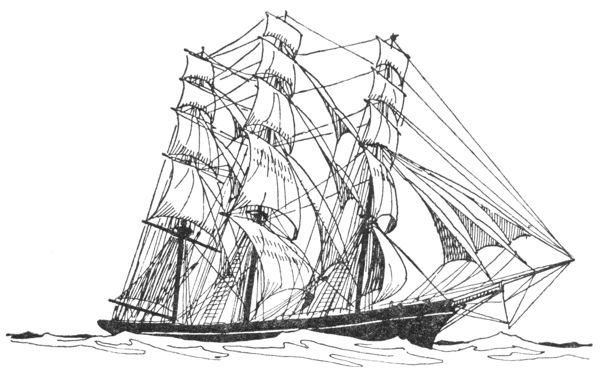
THE “FLYING CLOUD”
The finest of all the California clippers was the wonderful Flying Cloud, another one of Donald McKay’s ships. Longfellow’s poem The Building of the Ship is said to have been inspired by this vessel. She was launched in April 1851, and in June of the same year left New York for San Francisco under the command of Captain Josiah Creesy. Captain Creesy was a driver of ships, a ‘cracker on,’ and he drove the Flying Cloud for all she could stand. Sails were carried away, topgallant masts and topsail yards were lost, but Creesy carried on, sending up new spars, bending on new canvas when necessary, and for reward he arrived at the Golden Gate in the remarkable time of 89 days 21 hours from Sandy Hook. Trouble had been met and conquered. The men mutinied, and when this was overcome the ship had the misfortune to get into the Doldrums; yet she beat the world’s record for a ‘short’ long voyage. At times she averaged for twenty-four hours a speed of fifteen knots, a figure which was not exceeded by a steamer till twenty-three years later. The Flying Cloud crossed the Pacific to Canton, where she picked up a cargo of tea, and then returned to New York via the Indian Ocean and the Cape—a passage of ninety-four days. Her arrival in New York was the sensation of the day. This ship, by virtue of her fine sailing qualities and her graceful lines, was for years the most popular clipper in America, and on at least one occasion Captain Creesy had to escape to his home at Marblehead to avoid the embarrassing popularity of being captain of the smartest ship afloat. She ended her days in 1874 at St John, New Brunswick. She caught fire while on a slip for repairs, and was so badly damaged that she was condemned to be broken up.
Statistics can be dry reading, but the following figures showing how Pacific commerce began are certainly most graphic. From April 1847 to April 1848 (one year) four vessels only arrived in the Golden Gate from Atlantic ports. During that year nine American whalers put in at San Francisco. Note that only four vessels arrived there from Atlantic ports during the year before gold was discovered; but in the year following no less than 775 vessels—272 of them being full-rigged ships—left Atlantic ports for San Francisco! Every one of them carried passengers, and the hardships endured by these gold-crazed people during the long voyage were terrible. Some of the ships never reached San Francisco; some were disabled in bad weather or through their own unseaworthiness, while a few were never heard of again. Despite the difficulties of the voyage and the number of disasters in that first year of the gold-rush, nearly 100,000 passengers landed in San Francisco from all over the world. Desertions among the crews were the order of the day, many ships’ crews being so eager to get to the gold-fields that they could barely wait long enough, after the ship docked, to stow the sails and gear. Over a hundred vessels were unable to get crews and remained at anchor or tied alongside the docks to be turned into hospitals, store-ships, hotels, and even temporary prisons, and there they remained until they rotted to pieces.
To induce them to serve on board the clippers seamen were offered wages as high as 200 dollars a month. The result was that many an otherwise humane captain had, in desperation, to shut his eyes to the barbaric practice of shanghai-ing in order to secure a crew for the return passage. San Francisco became notorious for this unlawful and brutal custom, which seems to have endured until quite recent times.
Captain Clark, speaking[3] of the inflated prices of all commodities in California during the early days of the gold-fever, says that tea, coffee, and sugar cost 4 dollars a pound, boots 45 dollars a pair, beef, pork, and flour 40 to 60 dollars a barrel, picks and shovels (essential to the gold-prospector) cost 5 to 15 dollars each, and a pack of playing-cards cost 5 dollars. But labourers received as much as 30 dollars a day, and the luckier among the miners were getting at the mines anything from 100 to 1000 dollars a day for washing out gold.
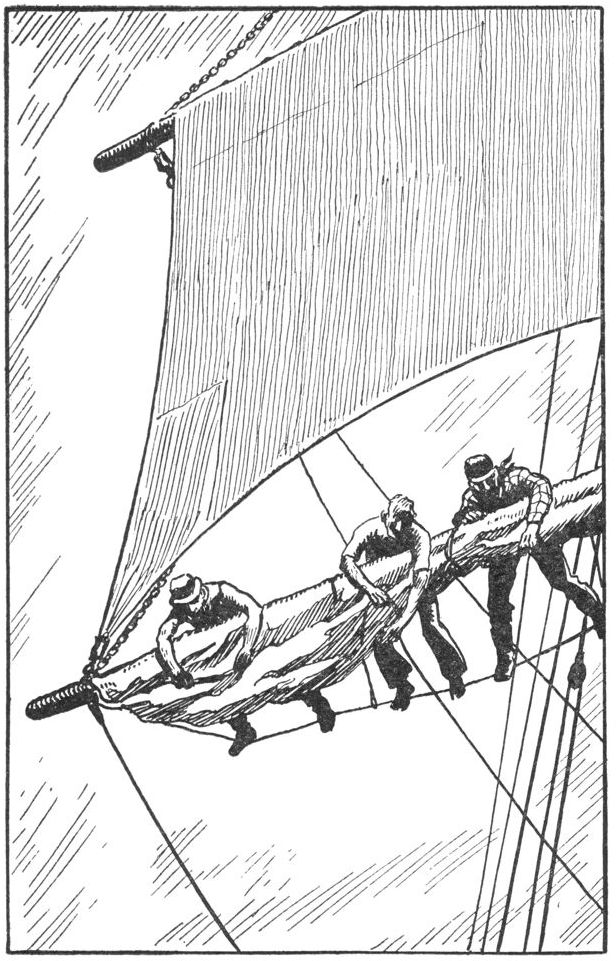
IN THE CLIPPER DAYS
The steamship was then in its infancy, and, though sailing-ships were still paramount on the seas, they did not entirely monopolize the California trade. Early in 1849 the steamship California reached San Francisco via Magellan Strait, and on the return voyage to New York carried back a huge consignment of gold. Continuing to run between New York and San Francisco for a period of nearly three years, she safely carried over 121 million dollars in gold.
The first steamers carrying on a regular trade between Europe and the Eastern Pacific were the famous little paddle-steamers Chili and Peru, built in London in 1839 for the Pacific Steam Navigation Company, of Liverpool. This company, known familiarly to all Pacific mariners as “The P.S.N.,” is running a big fleet of ships at the present time. The Chili and Peru were tiny boats of 700 tons, with engines of 150 horse-power, and they ran regularly between London and the west coast of South America until 1852, when they were superseded by four new paddle-wheelers of over 1000 tons each, and 450 horse-power. Thereafter the company built ships in increasing numbers until, in 1877, it possessed a fleet of forty-eight ships, the greater part of them screw-steamers. Though the company has such an extensive trade, it has never opened a route across the Pacific, its commerce being limited to the west coast and Europe.
For a long time no steamship company seemed ready to start a regular trans-Pacific service. The great central area of the Pacific was left to the sailing-ships. Until 1853 no steamers had crossed this ocean, but in that year the 1000-ton screw-steamer Monumental City, an American vessel, crossed from San Francisco to Sydney. The passage took sixty-five days and was considered good time. She never lived to better this time, for a month later she was wrecked on the Australian coast between Sydney and Melbourne.[4] If the Monumental City had continued to cross the Pacific she would most likely have escaped the fate which overtook her, but instead of being allowed to return to the United States, she was put into the Sydney-Melbourne trade. In the early hours of the morning on Sunday, May 15, 1853, the Monumental City, under sail and steam, ran on to the rocks on a small island near Cape Howe, New South Wales, and started to break up at once. To ease the ship the fore-mast was cut away, and in falling it brought down the main-mast. There was great confusion on the decks in the darkness, and it was not known till later how many people had lost their lives. When eventually the survivors got ashore in the boats it was found that out of the eighty-six people on board thirty-three had been lost. Among these were four women and three children. Afterward the captain took eighteen of the survivors in a boat to the mainland, where assistance was secured to rescue those left on the island.
Though the Monumental City had only made one passage across the Pacific, she had set an example which other American steamers were quick to follow, and from now onward a regular steamer route between San Francisco and Australia was definitely established. Until the coming of the big Canadian and Japanese liners the American companies reigned over the Pacific. The first trans-Pacific mail steamers were those of the Pacific Mail Company, a line which had begun in 1848 by sending steamers from New York round the Horn to Panama. The discovery of gold in California diverted the company’s ships to San Francisco, and so rapidly did the young company expand that by 1875 it owned over sixty ships. The company’s first trans-Pacific steamer was the Colorado (3728 tons), a big vessel for her day, which crossed from San Francisco to Yokohama in 1867. The Pacific Mail Company, which prospered for so many years, ceased to exist in 1925, when the crews were paid off and all the ships were sold.
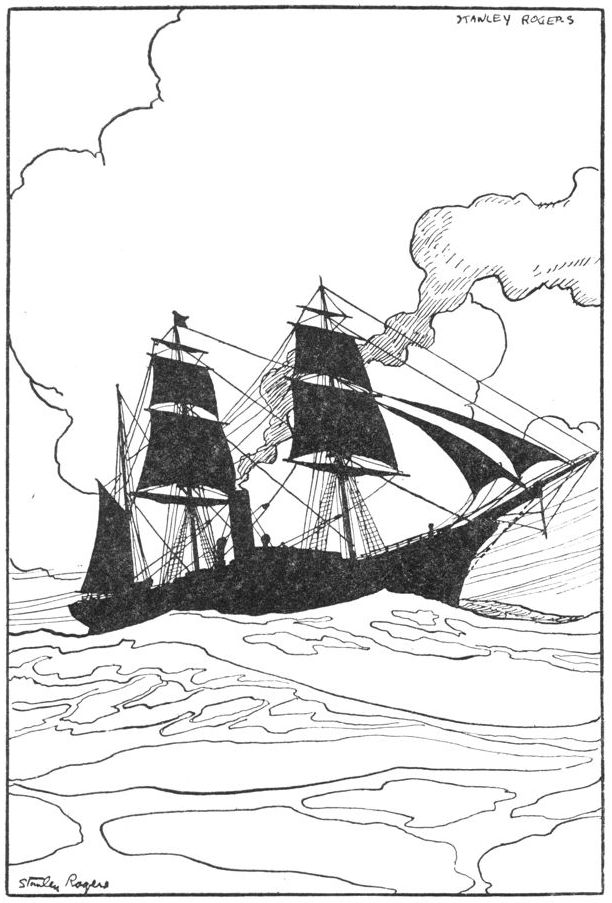
THE “MONUMENTAL CITY”
Among the ocean trade-routes of the world not the least important is coastal trade, of which the Pacific, by virtue of its important coastline, has its full share. The first steamer in the North Pacific was the old coaster Beaver, which appeared as far back as 1836. The Beaver arrived in the North Pacific long before there were any towns on the west coast, and she continued to sail from British Columbian ports until 1888, when she fouled the rocks of the Narrows close to Vancouver. For four years her broken hull hung on the rocks, until 1892, when the wash from another old timer, the Yosemite, which was passing, lifted her off the rocks, when she at once sank in deep water. During the four years the Beaver had lain there people from all round had come to see her and take away souvenirs of the romantic old craft. The Beaver had originally come from England, whence she had sailed in company with the barque Columbia, an American-built paddle-wheeler. All the early Pacific steamers were, of course, paddle-wheelers. It was a long time, however, before these pioneer steamers discarded sail, for engines were imperfect and liable to break down when they were most needed. Sail, with all its faults, could be relied upon, and without it many of the early steamers would have been in a bad way some time or other during their careers.
To return to the sailing-ships. Roughly speaking the halcyon days of the California clippers extended over the ten years between 1850 and 1860. These were the brave years when most, if not all, of the really smart American clippers were built. Carrying passengers to California and then across the Pacific for tea from Hong-Kong was their usual programme. Some, of course, were employed to bring back gold,[5] but very few passengers, for California absorbed most of those hopefuls who had gone out to make their fortunes and return to ‘civilization.’ Once in California they usually remained there.
Seventy years ago San Francisco, the metropolis of the Pacific, did not exist. Dana described it in 1835 as nothing more than a lonely mission-station. The magnificent harbour was seldom visited, and where the town of San Francisco now stands was nothing but “dreary sand-hills.” Two lone buildings stood at the inner end of the bay—the tumbledown presidio and, a few miles away to the left of it, the Mission of Dolores. Beyond the hills, out of sight of the bay, were scattered rancheros and small missions where Spanish settlers and the monks lived a hermit-like existence. From the sea nothing made by the hands of men was to be seen. Along the entire Californian, Oregon, Washington, and Canadian shore there was not a single lighthouse. The whole coast was still virgin country, and its remoteness from the civilized world accentuated its loneliness. Dana wrote:
Not only the neighbourhood of our anchorage, but the entire region of the great bay was a solitude. . . . Birds of prey and passage swooped and dived about us, wild beasts ranged through the oak groves, and as we slowly floated out of the harbour with the tide, herds of deer came to the water’s edge, on the northerly side of the entrance, to gaze at the strange spectacle.
Twenty-four years later Dana, now a prosperous and distinguished man, visited the scenes of his youthful adventures and found astonishing changes there. He first saw the lonely harbour of the San Francisco Mission from the deck of the little brig Pilgrim in 1835, during that almost historic voyage which inspired one of the finest books on the sea that has ever been written.[6] In the month of August 1859 (eleven years after the gold-rush had begun) the steamship Golden Gate entered San Francisco Harbour with Dana among her passengers. And his impressionable mind did not fail to remark every detail of the busy scene around him. As they approached the coast he noted the powerful lighthouse on the Farallone Islands, and still another near the brand-new fortress at the entrance to the Golden Gate. Steaming round the point, Dana saw before him and in the distance the towering masts of ships, wharves, and warehouses, and, beyond, buildings, steeples, and the lighted streets of a city of a hundred thousand inhabitants! At the dock the steamer (which was one of a fortnightly service from New York) was met by “express-wagons and hand-carts to take luggage, coaches and cabs to take passengers”; and by people “looking out for friends among our hundreds of passengers—agents of the Press, and a greater multitude eager for newspapers and verbal intelligence from the great Atlantic and European world.”
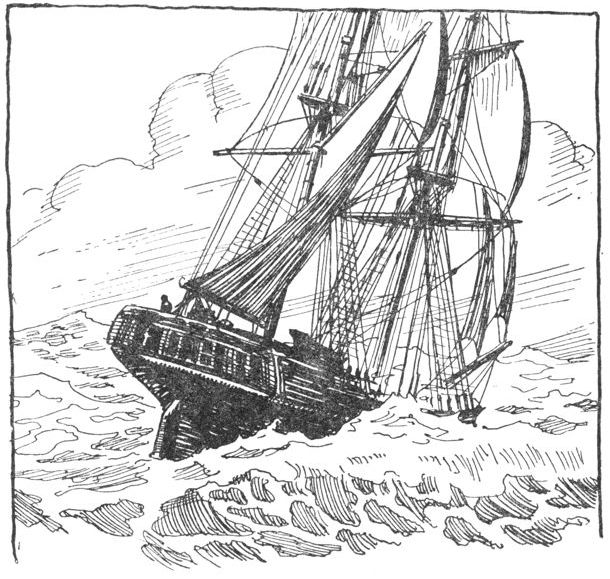
THE “PILGRIM”
From his hotel window the next morning he looked out upon the busy city of San Francisco and noted its towers, theatres, hospitals, court-houses—
the sole emporium of a new world, the awakened Pacific; . . . when I saw all these things, and reflected on what I once was and saw here, and what now surrounded me, I could scarcely keep my hold on reality at all, or the genuineness of anything, and seemed to myself like one who had moved in “worlds not realized.”
So wrote Dana of the mushroom city of San Francisco, in which the population had grown to 100,000 from nothing within twenty-four years. And where would the city have been without the ships? The only way was by water. There were no railways west of the Mississippi river and no wagon roads. Only a small part of the covered-wagon pioneers ever reached the Pacific coast, but hundreds of thousands came by sea. San Francisco made the California clippers, and the clippers made San Francisco, as they made also Santa Barbara, Los Angeles, and, later, the big coastal cities in Oregon and Washington.
The passage from New York to San Francisco round Cape Horn took from three to four months, and anything like a regular time-table (under sail) was impossible. A ship might take a week or a month to beat round the Horn into the Pacific against the prevailing winds from the west, and if she chose the ‘inside’ passage—i.e., through the Magellan Strait—she risked being becalmed for uncertain periods by the high mountains of the mainland and Tierra del Fuego. Winds and currents were imperfectly understood, and each ship-master sailed on a course of his own choosing. Sometimes they had the luck to pick up a fair wind; at other times they found themselves in the Doldrums.
It was not until after the heyday of the clippers, not until the steamers invaded the sailing-ship’s domain, that Lieutenant Maury gave to the world his celebrated and invaluable wind and current charts. Steamers scarcely required them, though they were still useful. They would have been infinitely more useful had they been made earlier. Briefly, Maury’s great work was the collecting of data concerning the regular winds and currents of the world’s oceans, indicating them by charts for the benefit of posterity. By corresponding with sea captains all over the world and receiving from them their careful observations of winds and currents, and by afterward sorting out and assembling this data, he was able to show that over the entire hydrosphere the sea-currents have a definite and well-marked flow, and likewise the currents of air above it. Thus, by taking advantage of these known winds and currents the sailing-ship captain could save much time and distance on a long voyage.
Maury, who was born in Virginia in 1806, entered the United States Navy at the age of nineteen. In 1830 he was sent to the Pacific in command of the sloop-of-war Falmouth, and, wishing to make a quick passage, he searched the Navy records before leaving for information concerning winds and currents. Lack of success in this direction gave him his great idea, which took him over twenty years to develop. In 1855 there was published in America a book, Physical Geography of the Sea, by Lieutenant Maury, which was subsequently translated into most European languages, and ran into twenty editions in English. Its value to ship captains was inestimable, and they were not slow to avail themselves of its advice. This, and other published works of a similar nature, brought him honours from all over the world in recognition of his service to humanity. He began a sailor and ended a scientist, his seafaring days concluding on his appointment as head of the Department of Charts and Instruments at Washington, a department which later became the Hydrographic Office. He died in 1873 with the rank of lieutenant, but with decorations an admiral might envy.
Let us return to the California clippers. There was one ship, the Andrew Jackson, which actually beat by a few hours the Flying Cloud’s record run. In 1860 she reached San Francisco 89 days 4 hours out from New York. This was a record, and she never again came near to this performance, whereas the Flying Cloud twice did the passage in less than ninety days. When it is remembered that the distance from New York to San Francisco, via Cape Horn, is 15,000 miles, eighty-nine days under sail (which must include loss of time in the Doldrums) is remarkably fine sailing. Sometimes there would be no wind; again there would be foul winds, especially round the Horn, where ship captains entering the Pacific had to beat against the strong westerly winds, the Roaring Forties, blowing straight into their faces. It was not uncommon for a ship bound for Australia to spend a month off the Horn trying to get into the Pacific, only, in the end, to turn tail and run eastward for the Cape of Good Hope, and thence across the Southern Indian Ocean—‘running her easting down’—to Australia. Another fast vessel on the California run was the Great Republic, the ship which for a time was on the Atlantic ferry service between New York and Liverpool, and which was for many years the biggest sailing-ship in the world.[7]
The names of all the famous California clippers and their records need not be told: there are too many for this short summary of the trade. Donald McKay, that prince of shipbuilders, was responsible for most of the finest square-riggers of the fifties and sixties. Staghound, Flying Cloud, Flying Fish, Sovereign of the Seas, Westward Ho, Bald Eagle, Empress of the Sea, Great Republic, Romance of the Sea—all were McKay’s contribution to the California clipper fleet, and all distinguished themselves.
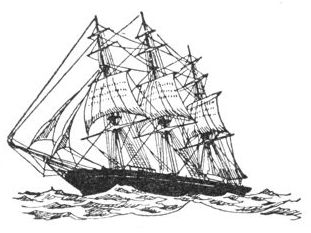
THE “STAGHOUND”
The Pacific sailing-ship trade can be divided quite distinctly into three eras. First, the old clippers, which began with the discovery of gold and lasted, say, for twenty years. They were wooden ships with very lofty spars, and carried for the most part single topsails. Their hulls were of the extreme clipper design, streamlined like a racing yacht. Then the middle era, say from 1870 to 1890, the era of iron or composite ships, such as the Loch Torridon, a British four-masted barque which made a passage, loaded to the Plimsoll marks, from Newcastle, Australia, to San Francisco in forty-six days. On another occasion she crossed from Newcastle to Valparaiso in thirty days. In 1886 the ship George Thompson broke the record for a voyage from Sydney to the Puget Sound and back. The total time, including her stay in port, was 122 days. Finally came the era of the big steel four-masted barques—say from 1890 to 1910. A trifling few of these last representatives of the age of sail still remain. Finland, to her great credit, owns most of them. Some have been built since 1910, but it is reasonably certain that when these are gone—lost or broken up—the square-rigger will be seen no more on the sea. Compared with the earlier clipper, they are not so handsome, with huge steel hulls almost square in section, like a modern steamer; but these big steel ships still preserve, in their lines and rig, some of the beauty of their prototypes, and one cannot be too critical.
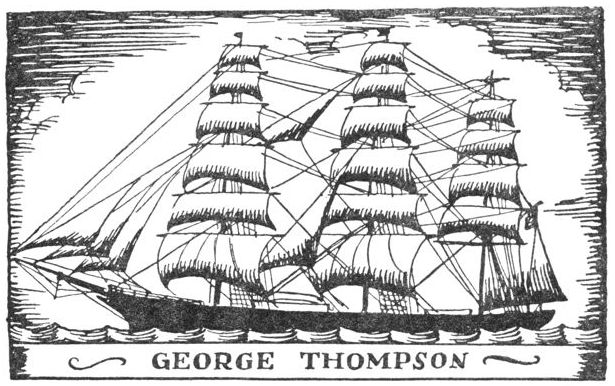
The latter-day Pacific square-riggers have been mostly employed in carrying nitrates from Chili, or wheat from Australia—both for Europe. But even this trade has gone to the steamers. They are quicker, safer, and more regular. A shipper of wheat from Australia to England likes to know when the wheat will arrive at its destination. With a steamer he does know, but with a sailing-ship, so dependent on the moods of the wind, he cannot be promised a delivery on a given date: the ship may take 90, 100, 150, or even 200 days on such a passage.[8]
In the year 1928 there were not more than thirty big square-riggers in the world, and half of these were owned in Finland. In 1929 there was only one big British windjammer left. That was the Garthpool, kept at sea more from sentiment that from sound business reasons. In November 1929 she was wrecked at Boavista, an island off the west coast of Africa, during a voyage to Australia. All the crew were saved, but the vessel was a total loss. There are two shipowners, Sir William Garthwaite, Bart., of Montreal, and Captain Gustaf Erikson, of Mariehamn, Finland, who deserve the greatest credit for their efforts to keep the square-rigged ship on the sea. The Garthwaite ships have had nothing but bad fortune since the end of the War.
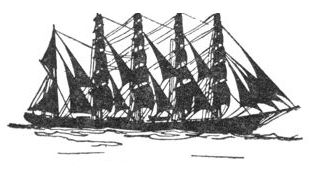
THE “KÖBENHAVN”
The Finnish and German windjammers, on the other hand, have been able to keep the seas where others have failed, partly because of the cheap labour available, but also because some of the ships have been subsidized by their Governments in order to encourage the future generation of sailors to get their training in sail. The Swedish Government makes this obligatory. Hence, when, in 1927, nineteen square-riggers left Australian ports for Europe—some via the Horn, others via the Cape—only two of them were British, the Garthpool and William Mitchell. Among the foreigners were the gigantic five-masted barque Köbenhavn[9] (a Dane), the Beatrice, C. B. Pedersen (Swedish), and the Herzogin Cecilie, Archibald Russell, Olivebank, Lawhill, Grace Hawar, and Killoran, all Finnish. The Finnish supremacy is due to one man, Captain Erikson, whose heart is in the square-rigged ship. Herzogin Cecilie, the pride of his fleet of sixteen ships, was an ex-German training-ship which he bought from France in 1921. She is still a training-ship, to encourage the Finnish youth; but combines business with training by engaging in the trans-Pacific wheat trade from Australia. The sailing fleet gets smaller every year; but so long as the Germans and Scandinavians keep alive their enthusiasm for the square-rigged ship, so long will the Pacific be furrowed by their old-world clipper bows.
Which brings us to the age of steam and the big trans-Pacific mail steamers. The honours of the Pacific are shared by two great steamship lines, the Canadian Pacific and the Nippon Yusen Kaisha, of Japan.[10]
The Canadian Pacific Steamship Company’s Pacific service began in 1887 with the chartering of the former Cunard vessels Batavia, Abyssinia, and Parthia to run to the Orient from Vancouver. Two years later the company got the contract for carrying British mails to Hong-Kong via Vancouver, the service to be every four weeks. The line received £60,000 a year from the British and Canadian Governments, and in turn were pledged to forfeit £500 whenever the steamers were delayed in starting, and a further £100 for every twenty-four hours after the first day’s delay, and so on in an increasing scale. The company had every inducement to sail to time, and they did.
In 1891 they put into commission the handsome liner Empress of Japan, built at Barrow. In compliance with Government requirements she was built to be used, in case of need, as an auxiliary cruiser, and had mountings in her for light guns. Both at Vancouver and Hong-Kong a number of 4.7 guns were stored, always ready. Her first run from Vancouver created a record (with less than ten days to make the crossing) with a speed of something like 18 knots. Later the Empress of India, of the same line, did a knot better than her sister ship. In 1903 she was run down by a clumsy Chinese cruiser, the Quang-Kai, but her stout build saved her, though the cruiser sank almost at once. Another one of the ‘Empress’ steamers, the Empress of China, was wrecked in the summer of 1911, thirty odd miles from Yokohama, but without tragic consequences. The mails were saved, and the ship herself was afterward refloated, though she proved to be too badly battered to be worth more than her breaking-up value. The earlier ‘Empress’ steamers were clipper-bowed like the American liners City of New York and Philadelphia, but the later Canadian Pacific steamers have the conventional straight stern. When the Tokyo Kisen Kaisha brought out three splendid 13,000-ton turbine steamers about 1910 the Canadian Pacific had to look to its laurels. The competition was too much for the old ‘Empress’ ships, and so the company ordered the two 17,000-ton liners Empress of Russia and Empress of Asia; the latter brought the time of crossing down to 8 days 19 hours, which was beaten by two and a half hours in May 1914 by her sister ship.
In 1914 when the Great War began the Empress of Russia was in Vancouver, but was at once rushed across to Hong-Kong, where she arrived safely after running the gauntlet of Von Spee’s prowling cruisers. She was armed with four of the old-fashioned 4.7 guns that had lain awaiting just such an emergency for so long that they were hopelessly out of date. With a mixed crew and this dangerously inadequate armament, she assisted in the chase of the Emden, and though (perhaps fortunately) she did not come to grips with the redoubtable cruiser, she was used to transport the Emden’s prisoners from Cocos-Keeling to Colombo.
The most recent of the Canadian Pacific trans-Pacific liners is the big Empress of Canada, 625 feet long, with a displacement of 26,650 tons. She was built by the Fairfield yards in 1922, and has become the most popular liner in the Pacific service. Incidentally she has lowered the Empress of Russia’s record by eight hours. In 1921 the company bought, from the Reparations Commission, the Hamburg-Amerika steamer Tirpitz, which they eventually renamed Empress of Australia. These fine modern ships, with their yellow-ochre funnels and gleaming white hulls, make a pretty sight as they surge at nineteen knots through the long rollers of the North Pacific.
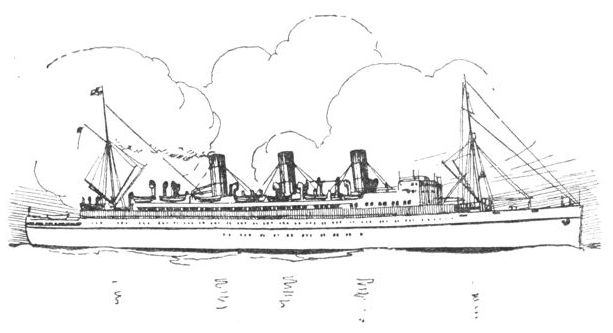
THE “EMPRESS OF CANADA”
The beginning and development of the big Japanese steamship line, the Nippon Yusen Kaisha, is especially interesting, not to say remarkable, when one remembers that little more than half a century ago Japan was living in a feudal state comparable to our own medieval times. With no gradual approach to our modern Western civilization as we have had, the Japanese have profited by our experiences and mistakes, and have learned, in fifty years, what took us five hundred to acquire. Something like half a century ago their navy and merchant fleet was, except for wooden craft of the junk type, non-existent, but now they have a fleet of ships (many of them built in Japanese yards) as fine as any in the world.
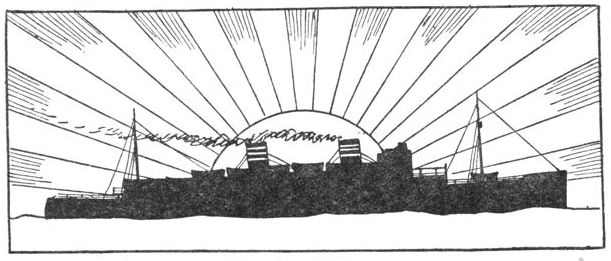
AN N.Y.K. STEAMER
The N.Y.K. began in 1885 by the amalgamation of two older firms, the Mitsu Bishi Company, which was formed in 1871, and the Kyodo Unyu Kaisha, founded in 1882 in competition with the former company. But when it became apparent that the two rival lines were crushing each other they wisely joined forces. Thus was born the famous N.Y.K. At first the company confined their trade to the western side of the Pacific, running services to Korea, North China, Vladivostok, Manila, and occasional steamers to Australia. In 1892 they opened the first regular long-distance service with a line to Bombay. Shortly after the Chino-Japanese War of 1894-95 the N.Y.K. sent their first steamers across the Pacific to America, when, in 1896, they inaugurated the Hong-Kong-Japan-Seattle line, running fortnightly each way.
When the Panama Canal was opened the company started a trans-Pacific Japan-New York monthly service of cargo steamers. The line now possesses 150 vessels, aggregating 875,000 tons! And this in fifty years!
The company has recently built three 17,000-ton passenger motor-vessels to run on the fortnightly service from the Orient to California.
The Asama Maru, the first of these fine ships, was launched in Japan in 1928 and commissioned in October 1929. Her powerful motors can drive her 16,800 tons through the seas at 21 knots. This is the latest engineering triumph of a nation which should be regarded rather as a friend than as a rival; for the day may come when the Japanese ideals are recognized as worthy of our greatest respect, and the nation itself as the best possible safeguard against the spread of anarchy in the East.
|
The Natchez was built in 1831. |
|
Her revenue from freight was over 70,000 dollars for the passage out. |
|
In The Clipper Ship Era (Putnam). |
|
I am indebted to Pacific Steamers, by Will Lawson (James Brown and Son (Glasgow), Ltd.), for the facts of this disaster. |
|
Gold could not for ever be the cargo of the California clippers. Some of the emigrants, having poor luck in the gold-fields, turned their minds to farming. It was soon discovered that the fertile Californian earth was ideal for growing wheat, and many who had failed at mining now prospered as exporters of another gold—golden grain. The first cargo of wheat from California—4750 odd bags—was taken to New York by the barque Greenfield in 1855. This was the beginning of a trade which has never ceased, though steamers have now supplanted the lovely square-riggers. |
|
Two Years before the Mast. |
|
Her history is told by the author in Sea-lore. |
|
A passage is one journey; a voyage is the journey out and back. |
|
Since reported lost, with all hands, in the South Atlantic. |
|
Other Pacific lines are the Union S.S. Company of New Zealand, from San Francisco to Auckland; the Australian United Steam Navigation Company, from Vancouver and ’Frisco to Honolulu and Sydney; the New Zealand Shipping Company, the Branch Line; Burns Philip’s and Donald and Maxwell’s line among the islands. |
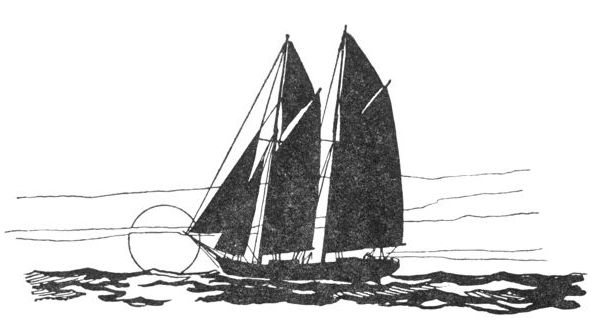
Certain stars in the literary firmament will for ever be associated with the South Seas. The brightest of these are Herman Melville, Robert Louis Stevenson, Pierre Loti, and Jack London. Rupert Brooke shone there for a brief moment and was gone. Herman Melville was the first of the romantic writers of the South Seas, but his fame was posthumous, and it was not until the post-War years, since 1918, that the long-since-dead author has really come into his own with the frequent reprinting of Moby Dick. Melville, a strange and disappointing genius, whose last years were spent in writing second-rate stuff unworthy of his great beginning, was the only purely South Sea author. The Pacific was his muse, he knew no other, whereas R.L.S. had ‘arrived’ in Europe long before he came to the Pacific, and Loti had other loves besides his fair Tahiti.
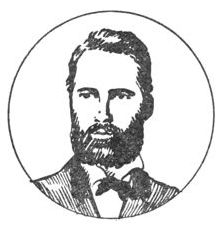
HERMAN MELVILLE
In the stormy month of January 1841 the American whaler Acushnet, 359 tons register, commanded by Captain Pease, set out on a whaling cruise to the South Seas. It was her maiden voyage, and among her company was a young man, twenty-two years old, named Herman Melville. This young man, a New Yorker born, came of a family of some social pretensions who, while he was still a child, fell upon evil days and lost their wealth. The boy was sent to work first in a bank, and afterward in a hatter’s shop. But the quality of resignation which keeps some people working in shops was not in Herman, and he broke his bonds and fled before habit made him grow resigned to the accursed harness. He did nothing by halves, and when he walked out of the hat-shop for the last time it was to sign on in a sailing-packet bound for Liverpool. The change from the safe and smug life in a shop to the hardships and dangers of the North Atlantic was almost terrifying, but the determined youth stuck it until the life actually came to fascinate him. Though he afterward wrote, “Miserable dog’s life is this of the sea: commanded like a slave and sent to work like an ass: vulgar and brutal men lording it over me, as if I were an African in Alabama,” he was to endure voluntarily many years of such an existence before he gave it up to settle ashore and turn writer. After the Western Ocean experiment he took a berth ashore as a school-teacher, and for three years held the position of pedagogue until the call of the sea grew too strong for him, and in the depth of winter he joined the Acushnet for a four years’ whaling cruise.
Scarcely had the vessel dropped the land astern than the true character of the captain and officers showed itself. They began at once to make the ship a hell afloat, until life for the men became almost insupportable, with the result that the spirited Melville planned to desert at the first opportunity. This would not be easy, as the ship might not touch at a civilized port for years, and to trust oneself to the fickle friendship of the Polynesians, many of whom were still cannibals, was a prospect to deter anyone but an unusually desperate man. Melville confided his resolve to a youth of sixteen named Richard Tobias Green, and one day when the Acushnet was at anchor at Nukahiva in the Marquesas the two young men left the ship and fled into the jungle to take their chances among the dreaded Marquesan cannibals. It is all related faithfully in his first book, Typee, a Narrative of a Four Months’ Residence among the Natives of a Valley of the Marquesas Islands, or A Peep at Polynesian Life, which was published in 1846.
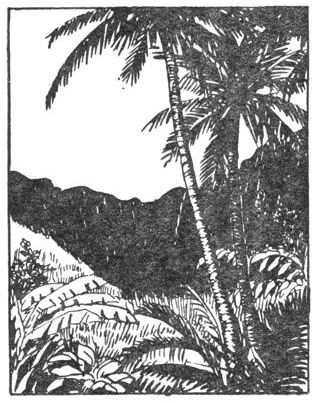
TYPEE VALLEY
The pair of youthful runaways wandered through the tropical valley of Happar until they found themselves in a native village where they were detained without hardships, captives, but treated with every mark of affection and respect by their savage gaolers.[1] Their prison was a veritable Garden of Eden—perfect climate, an abundance of delicious fruits, enchanting glades among which dwelt thousands of white doves unafraid of men; fairy landscapes, with waterfalls scattered in falling into brilliant rainbows, and clear pools where the care-free people of the valley played like happy children. But, however idyllic this South Sea paradise and however friendly the Marquesans, it was not his home, and they were not his people, and even the beguilements of the lovely maiden Fayaway could not reconcile Melville to his condition. Though the inability to endure nostalgia is a characteristic weakness of the Polynesian himself (he frequently dies of a broken heart when taken from his own island), Melville’s captors, save for a few of the softer-hearted women, turned a deaf ear to his requests for liberty. Finally he was rescued by the crew of an Australian vessel after a skirmish with the natives on the beach of the Typee bay, and returned to New York two years later, by which time he had become an experienced deep-water sailor. But, except for a voyage round the world as a passenger in 1860, he never went to sea again.
The publication of Typee determined Melville to devote his life to literature, and in the year following (1847) its publication another book bearing his name appeared. This was Omoo, a Narrative of Adventures in the South Seas. Then followed Mardi, Redburn, Whitejacket, or The World in a Man-of-War, and then, in 1851, the immortal Moby Dick. This book was his passport to immortality. Nothing else he wrote anywhere near reached its greatness, and, indeed, all that appeared thereafter was of such a trivial, inferior, opinionative, and eccentric nature that it can only be explained by a partial breaking down of the author’s dark and mystic mind. He died in New York on September 28, 1891.
His experiences on the Acushnet provided him with the background and the inspiration for his sombre tragedy Moby Dick. If the Acushnet was not “built in th’ eclipse, and rigg’d with curses dark,” she was certainly a ship of ill-omen. Half her crew came to melancholy ends. Captain Pease finished his days in an asylum at Martha’s Vineyard, and Melville made his Ahab a madman who drove his ship and crew to their doom. Another member of the Acushnet’s crew killed himself at Mobile (Alabama), four died of filthy diseases and one of tuberculosis, and many deserted the unhappy ship among the islands.
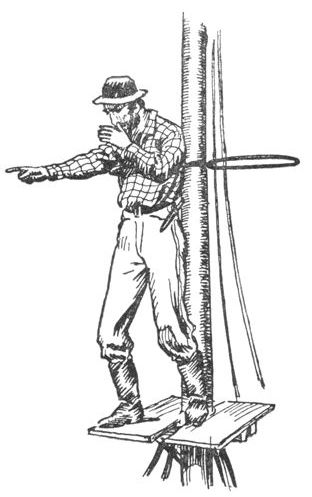
It is characteristic of the majority of the reading public that Melville’s first books were popular. They are simple, straightforward tales of adventure, related with the same freshness and sincerity that distinguished Marryat’s works. Then after an interval came Moby Dick, a book which marked the beginning of the author’s obscurity. The disappointment may have influenced the trend of his later works. In Pierre and The Confidence Man he plumbs the abyss of gloom, but fails deplorably to attain the quality of Moby Dick. He was essentially a man of one book—not perfect, but a great work that is only now receiving its due.
No one understood Moby Dick when it appeared, and, except by the connoisseurs, it was quickly forgotten. Just after the Great War Melville was discovered by the dilettanti of America and England, and several new editions of his masterpiece have appeared. And we may owe it, I think, not to any renaissance of learning, nor to the enthusiasm and perspicacity of the critics, but rather to the revived interest in the sea, sea-lore, ships, and ship-models which spread like an epidemic over the United States toward the latter days of the War, and, after the passing of a decade, still holds the fickle attentions of the public. American fashions usually find their way to England a year or so later, and by 1921 or 1922 British essayists, journalists, and other writing people were naïvely confessing that they had only just heard of Moby Dick. The present writer was introduced to this work under romantic circumstances in Greenwich Village, New York, in 1921, but that is a story for another time.
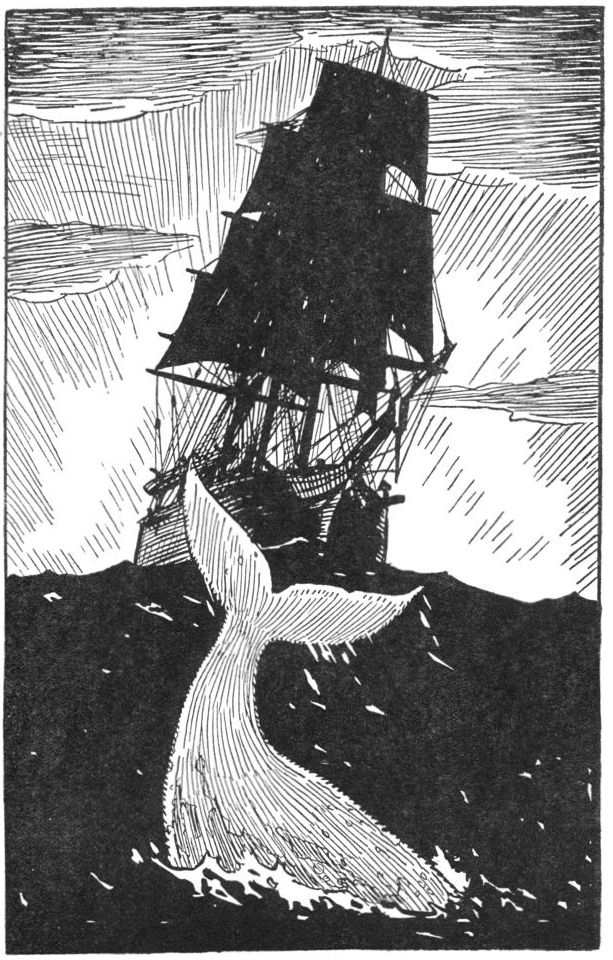
MOBY DICK
The scene of Moby Dick is laid, except for the opening pages, entirely in the Pacific, during the whaling cruise of the Pequod, a ship as bizarre in its fittings and equipment as were the officers and crew who manned her. The story concerns the chase of a vicious white whale (Moby Dick), who on a previous voyage had been responsible for the loss of one of Captain Ahab’s legs. The loss of the limb had preyed on the captain’s mind until vengeance became his one passion in life—vengeance on Moby Dick. But the book is more than that: it is a frame for the author’s musings on life and human passions. It is unique in its treatment and its conception. There has never been anything else like it in literature. In it philosophy and fact, whaling and metaphysics, are woven into a book of wonderful beauty and profundity of thought and imagination. It has the gloomy tragedy of Macbeth, the virility of the sea, and the metaphors and allegories of the Bible. It is several books in one, but through it all runs the deeper theme which it were a mistake to try to explain.
In the summer of 1888 Robert Louis Stevenson went to the Pacific to save his life, and he remained there, an exile, till his death at the end of 1894. The years 1886, 1887, and 1888 were years of great physical prostration to the consumptive author, and in search of health he chartered the schooner-yacht Casco from Dr Merrit, of San Francisco, for a cruise in the South Seas. The yacht was 94 feet long, with a beam of 22 feet, and her fittings were luxurious, as became the tastes of her wealthy owner. Stevenson paid Dr Merrit 500 dollars a month for the use of the yacht, paying also the wages of captain and crew, as well, of course, as providing the provisions and stores for the voyage. Dr Merrit had chosen as sailing-master a bluff old yacht skipper, Captain Otis, whose impressions of his new employer, Stevenson, were anything but favourable, though he quickly came to like and respect the frail and sickly man who knew no fear. One can understand the bluff captain’s feelings on meeting R.L.S. for the first time. A man of over average height but so thin that his brown velvet coat hung on him as on a scarecrow, big dark eyes, wide apart in a thin white face, a thin drooping moustache, and long hair reaching to his shoulders—the general effect did not inspire confidence in the sailing-master of the Casco. Otis even confessed, years later, that he made secret arrangements, before sailing, for the burial of R.L.S. at sea, so certain was he that the invalid could not live through the voyage.
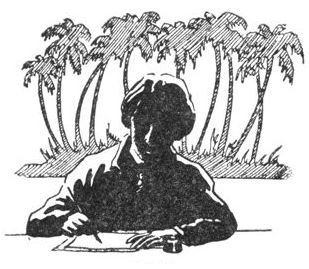
R.L.S.
Otis was to be master of the ship, and all sailing orders from the charterer had to be subject to the sailing-master’s approval. R.L.S. quickly won the respect of the dubious old sailor. He proved to be a good sailor himself, and seemed quite fearless during gales when some of the yacht’s party were none too happy. His health began to improve during the cruise, and his days afloat were full of work and play. The man who wrote An Apology for Idlers knew how to idle profitably. When his strength mended he rose at dawn and dictated to Osbourne, his stepson, until breakfast, and if the mood was on would work during the forenoon. The rest of the day he would spend lounging on deck or practising on his flute, an occupation that the others endured rather than enjoyed. Among the party were Stevenson’s wife, his mother, and Lloyd Osbourne, with whom R.L.S. so ill-advisedly collaborated in writing more than one book.
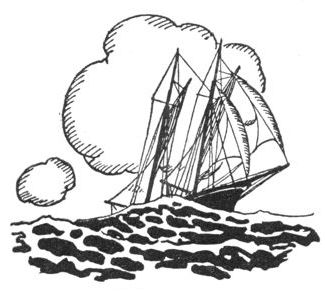
THE “CASCO”
The first objective from San Francisco was the Marquesas, which was reached after three weeks’ sailing, most of it in bad weather. The gales experienced during this passage gave Stevenson some of the local colour for The Wrecker. After a short stay in the Marquesas the Casco stood for the Paumotus, six days’ sail from Nukahiva. Here the party dallied two weeks, hunting pearl-shells, fishing by moonlight, and exploring the islands. During the stay Stevenson caught a cold and was hurried off to Papeete for the attentions of a doctor. He was carried to the Hôtel de France in the town, where severe hæmorrhages caused his friends to despair of his recovery. In three weeks, however, he was not only better, but able to travel, and the yacht set forth once more. Five weeks were spent at Tahiti while the Casco was fitted with a new main-mast, and when the repairs were completed a quick run was made for Hawaii in a heavy gale and short of provisions. The Stevensons stayed six months in Hawaii, but the invalid found the climate too cold for his health, and a search was made for a more salubrious home.
During the stay at Hawaii the Stevenson family rented a house and began light housekeeping at Waikiki Beach, where, within sight of the sea, The Master of Ballantrae was completed for Scribner’s Magazine, through which it ran serially. In Fanny Stevenson, the author’s American wife, he had an ideal companion, one who not only understood and was in sympathy with his character and moods, but was herself a woman of superior intelligence and strength of character. Much of a Bohemian and entirely unselfish, she no doubt prolonged his life considerably by her devoted nursing. As a distinguished man his time was in much demand, and part of Mrs Stevenson’s work at Waikiki was ridding her husband of tiresome guests who seemed to have no understanding that they were wasting his time. In Hawaii he was far from well, and he once confessed to a questioner that he wrote wild, strong tales of men who did great deeds because regrets for his own feeble body made him admire physical strength in others.
He was popular in Hawaii, and many laments were heard when it was known that he was leaving the island. At this period Hawaiian politics were in a turmoil of party strife and jealousies, and R.L.S. threw his interest into the cause of the Hawaiian royalists, whose figurehead was the somewhat dissolute King Kalakaua. The King came down to the dock when the Casco sailed to bid farewell to the Scottish author, bringing with him a present of a basket of champagne in ice. While at Hawaii he visited the leper island of Molokai, a visit which made an impression on him he never forgot.
On June 24, 1889, the trading schooner Equator, 70 tons, with the Stevensons on board, left Honolulu for the Gilbert Islands. Except for a brief visit in 1893, he never went back to Hawaii. For six months the wanderers cruised in search of a home, until, on Christmas Day 1889, R.L.S. found Samoa, where he stayed six weeks. Early in 1890 he went to Sydney, where he nearly died, so easily was he affected by change of climate. It was realized that his only chance of life lay in the tropics, so trunks were once more packed and the family took passage on the little trading schooner Janet Nicoll for the islands. In November 1890 he settled at Vailima, an estate he bought on Upolu, in the Samoan group, where his health at once began to improve. Here, on the slopes of Mount Vaea, near Apia, he built a two-storeyed tropical bungalow and lived the life of a planter, employer of labour, and benignant despot in feudal state—his native servants wearing Stuart tartan lava-lavas, the livery of the house of Stevenson. Here he received his Samoan name ‘Tusitala’ (‘the Teller of Stories’). ‘Vailima’ means ‘Five Waters’—i.e., five of the many streams running through the plantation.
From Apia, the island town, a good road led directly inland for two miles and then changed to a mountain track, which zigzagged upward for some miles more through the jungle toward a wooden gate, beyond which could be seen through the trees Vailima. Except from the gate the house was not visible from any spot on the island outside the estate, though from some miles out at sea it could be seen, solitary on the wooded mountain-side, looking out over the broad Pacific. The house, surrounded by its wide verandah, was built of wood imported from America, and roofed with terra-cotta. The interior furnishings of the building were simple, but books lay everywhere, and the master’s own library was hopelessly untidy; books were on the table, on the chairs, and on the floor. On the plantation, in which Stevenson took great interest, were cultivated taro, bananas, and cacao, and for the family’s special benefit a kitchen garden provided them with the more conventional vegetables of our own tables.
Here dwelt Stevenson, his wife, her son, Lloyd Osbourne, and sometimes Tusitala’s mother, an old-fashioned Scotswoman who adapted herself remarkably well to the life at Vailima. R.L.S. spent his days writing and managing his estate. With the Samoans he was well-beloved, and when he died their grief was genuine and long-felt.
In their island retreat the Stevensons lived a sort of South Sea vie Bohême. On hot days pyjamas were de rigueur, and Mrs Stevenson shared her husband’s weakness for cigarettes. A woman who smoked in the eighties was surely a woman of independent character. All the family were heavy smokers, and always preferred to roll their own cigarettes. After Stevenson’s death in December 1894 Mrs Stevenson continued to live at Vailima, and when Captain Joshua Slocum called at Apia in July 1896, during his round-the-world voyage in the Spray, he visited her at Vailima. Lloyd Osbourne showed him over the house, and the novelist’s wife made him a gift of four volumes of sailing directions which had once belonged to her husband. Captain Slocum, who was himself a charming character, described his hostess as a delightful woman whose tastes were similar to those of her distinguished husband. She had his sense of humour and the same adventurous spirit—an ideal mate for such a man.
Trusty, dusky, vivid, true,
With eyes of gold and bramble-dew,
Steel-true and blade-straight,
The great artificer
Made my mate.[2]
When Tusitala died the first few chapters of Weir of Hermiston lay unfinished on his table, and this fragment had promised to be one of his finest books. There was also the nearly completed novel St Ives, which Sir Arthur Quiller-Couch so courageously finished. R.L.S. had written thirty chapters, and “Q.” added the last six. The Wrong Box, The Wrecker, and The Ebb Tide (which R.L.S. disliked) were written in collaboration with Lloyd Osbourne. Other works of Stevenson’s, written during his exile, were The Master of Ballantrae (begun in America) and Catriona, a Scottish romance and sequel to Kidnapped. There was also A Footnote to History, a work which contains some fine passages, and Vailima Letters, collected and published posthumously by Sir Sidney Colvin. The short story The Beach of Falesà (now included in Island Nights’ Entertainments) raised a storm of criticism in the Puritan camp when it was published, the pundits declaring it to be immoral. But the author very rightly refused to alter a line of this Polynesian idyll. Autres temps, autres mœurs. Nowadays we wonder what all the excitement was about.
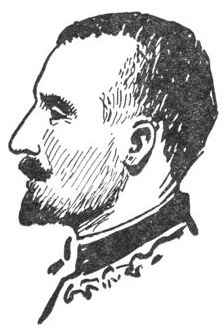
PIERRE LOTI
In a lonely grave on the slopes of the peak of Vaea lie the mortal remains of R.L.S., which sixty natives, in a solemn cortège, carried up the mountain the day after the novelist’s death. On his gravestone is the famous epitaph Requiem, which he wrote some years before, and which has since become so widely known.
In 1850 there was born in Rochefort, in France, Louis Marie Julien Viaud, the future author of Le Mariage de Loti, the most haunting of all South Sea romances. Born into an old Protestant family of some social prominence in Rochefort, he was sent at the age of seventeen into the Navy, where he served until 1910, when he was put on the reserve list with the rank of captain, which he had attained four years before. When he began to write he assumed the nom-de-plume of Pierre Loti, from le loti, an Indian flower which blushes unseen, whose name was bestowed on Viaud by his shipmates. His first book (1876) related his experiences in Constantinople, a place for which he had a great affection. As a naval officer he sailed all over the world, and during a sojourn in the South Seas had a love affair with a beautiful island maiden, and, like so many artists, found relief for his feelings by dramatizing them. The result of this idyll was the appearance in 1880 of the romance called Rarahu, which was reprinted later as Le Mariage de Loti. The originality of the story, with its inexpressible sadness, gives it a distinction that haunts the memory long after the book is laid aside. The story concerns the love of an English midshipman, Harry Grant, on H.M.S. Rendeer, for Rarahu, a Tahitian maiden of noble birth. When he first meets her she is but fourteen, and, after a liaison interrupted by the movements of his ship, he finally leaves Rarahu for good to return to his own people in England. Later he hears of her death (at eighteen) in sordid circumstances, but ever faithful to her love. At the end she is homeless, consumptive, and trying to forget her misery in eau-de-vie. She writes many letters to her lover, letters reminiscent of those of Héloïse. In her last letter she writes to him:
Ô mon cher petit ami, ô ma fleur parfumée du soir! mon mal est grand dans mon cœur de ne plus te voir! Ô mon étoile du matin, mes yeux se fondent dans les pleurs de ce que tu ne reviens plus! . . . Je te salue par le vrai Dieu, dans la foi chrétienne.
Ta petite amie,
Rarahu
As a writer Loti had an exquisite style and a perfect cadence which was as fine as anything written by French writers in the nineteenth century. As a man he was effeminate and eccentric even to the point, in later years, of using cosmetics, powdering and scenting himself like some pathetic old actress. Except for a brief interval during the War when he gave his services to the Navy, he lived in his latter days the life of a recluse, his body in France, but his heart in those exotic places that inspired so much of his work.
There is a vast chasm between the melancholy Pierre Loti and the robustious Jack London. They both found in the Pacific a stage for many of the players of their creative fancy, but that is as far as the likeness between them goes. Jack London was essentially masculine, and his books reflected his masculine character just as Loti’s reflected the feminine streak so marked in him.
Jack London had a rule that he must write a thousand words a day, and during his two years’ voyage in the Pacific wrote Martin Eden (begun in Honolulu and finished at Papeete), South Sea Tales, and The Cruise of the “Snark,” which was the story of the voyage written for the Cosmopolitan Magazine and Harper’s Weekly. During this cruise he also wrote The House of Pride and Adventure.
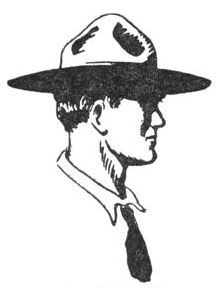
JACK LONDON
The Mutiny of the “Elsinore,” a rugged tale of mutiny on the high seas, was inspired after a voyage, in the four-masted barque Dirigo in 1912, from Baltimore to Seattle round Cape Horn. Mrs London accompanied him, to the astonishment of her friends, who believed that a Cape Horn voyage in a windjammer would be too rigorous for a woman. But Charmian London had accompanied her husband on most of his adventures, even to going among the savages at Malaita—men who had never before seen a white woman, and every one of whom was capable of murder. I believe that she was the only woman present at the Burns-Johnson prize-fight in Sydney, where Jack London went to report the fight for an Australian and an American newspaper.
The original plan of the Snark voyage[3] was to sail round the world, taking at least five years over it, but after two years the cruise came to an end through Jack London getting a mysterious skin disease which attacked his hands and refused to heal so long as he remained in the tropics. He remained for five weeks in a hospital in Sydney, and for five months in Australia, receiving treatment for the strange malady which defied all the expert doctors that money could summon. When he returned to California the disease left him, and not until long afterward, when he read an article on the effects of tropical light on white people, did he discover what had caused the disease.
The idea of the voyage came to the novelist during a conversation with some friends, and from a small beginning the idea grew into an ambitious plan which called for a sea-going yacht, ketch-rigged, with a length of 45 feet and a beam of 15 feet. Her name, Snark, suggested by Lewis Carrol’s Hunting of the Snark, was given her for the sufficient reason that they could think of no better one. The progress of her building was delayed by the great Californian earthquake on April 18, 1906, but at last, after exasperating delays and the expenditure of 20,000 dollars more than Jack London had bargained for, the Snark was ready, and on April 23, 1907, she stood out through the Golden Gate with the novelist, his wife, and four or five others on board, among whom was the young enthusiast Martin Johnson, who was later to make a name for himself as a traveller in the wild places of the earth. Oahu, Hawaii, the first objective, was reached twenty-seven days out. For four and a half months the Londons worked and played at Hawaii. Jack wrote steadily, with intervals for recreation, surf-riding at Waikiki, and visiting the lepers at Molokai.
On October 7 the Snark stood southward for Nukahiva, 2000 miles away, and arrived there two months later, after sailing 4000 miles due to wrong winds and currents. At Nukahiva Jack explored the Typee valley on horseback among the scenes of Melville’s captivity, growing enthusiastic over that island paradise and the Marquesans themselves, the most handsome of all the Polynesian race. The Marquesans have always shared with Tahiti the affections of South Sea travellers, but London saw a greatly different country to what Melville knew. From the Marquesas the Snark sailed westward, eventually coming to Suva, in Fiji, and from there to the Solomons, in many ways the most interesting place of all.
Jack London, hungry for sensation and new experiences, met stark, raw savagery among the treacherous natives at Malaita, where a white man dare not step ashore unarmed. It was in the Solomons that he and others of the Snark crew fell victims to the tropical malady which was to bring about the termination of the cruise, a few months later, in Australia. The Londons nearly wept with disappointment at the failure of their plans, but there was no help for it; the novelist’s hands were of more importance to him than the continuation of the voyage. The Snark was sold for a third of her cost, and Mr and Mrs London returned to America as passengers on a Scotch collier, the Tymeric, from Newcastle, N.S.W., to Ecuador. Jack London had, of course, been in sail on the Pacific long before he became a famous writer, and his book The Sea Wolf got much of its colour from personal experiences of the author himself. In January 1893, at the age of seventeen, he signed on for a sealing voyage in the three-masted schooner Sophie Sutherland, bound for the Bering Sea and the coast of Japan, and returned to San Francisco after a seven months’ cruise, a full-blown able seaman.
He died on his ranch, Glen Ellen, in California, on November 22, 1916, after an illness lasting only a few hours.
In the month of May 1913 Rupert Brooke, the English poet, left for New York on a sort of wander-year in the New World. Progressing leisurely through Canada and the United States, he arrived in the autumn at San Francisco, whence he sailed for Hawaii and the South Seas. Honolulu he called “a dreadfully American place.” Of Samoa (where he went later) he wrote enthusiastically of “heaven on earth,” and of “naked people of incredible loveliness and immense kindness; a divine tropical climate, and intoxicating beauty of scenery.” He said that the “Samoan girls have extraordinarily beautiful bodies, and walk like goddesses,” and delighted to see the boys swarming up the perpendicular coconut-palms to cut off the nuts and drink from the holes made in the ends. Fiji he found “not so attractive but more macabre,” and of the native dancing he preferred watching the siva-siva to Nijinsky. The town of Suva he likened to a “large English town,” but it was “a queer place, much civilized.”
The Polynesians he thought were “much nicer and better mannered than ourselves,” a verdict most of us would endorse could we meet some of the best of the race—those unspoiled by civilization. Brooke spent three idyllic months at Tahiti, where he did some of his best work—Retrospect, The Great Lover, and Tiare Tahiti. Here he spoke of “a blue lagoon with deep water for diving and coloured fish that swim between your toes.” In Tahiti he tried to find some overlooked Gauguin paintings, but it seemed that none had been overlooked. Gauguin dead was Gauguin appreciated.
In April 1914 the poet left Tahiti for America and then home, but he was loath to go, and afterward wrote, “I want to live in a hut by the sea and pretend I’m a Polynesian.” Had he lived there is little doubt that he would have visited the South Seas again. The contrast of modern America with the romantic South Seas evoked cynical comment from the poet as he hurried across the continent to England, the War, and his death.
He was born at Rugby on August 3, 1887, where he was educated until he went to King’s College, Cambridge, in 1906. At the age of eighteen he won a prize for a poem called The Bastille, his first published work. For a poet and a genius he was very normal and wholesome in his tastes. He loved athletics, good plays, and the Russian ballet. In appearance he was tall, golden-haired, youthful-looking, with eyes of the most intense blue. His manner and his appearance were distinguished without the least trace of self-consciousness.
When the Great War began he remarked, “Well, if Armageddon is on I suppose one should be there.” He died of blood-poisoning on board an Army transport in the Near East, and lies buried in an olive-grove at Scyros.
He has been described as vivid, which, at his age, means that he possessed youthful joie de vivre, vitality, enthusiasm—the attributes of an uncommon spirit. He was tenacious of life, he loved it intensely; yet he gave it up as gladly as he had lived it. The sonnet Waikiki,[4] written in Hawaii, is the measure of his joie de vivre:
Warm perfumes like a breath from vine and tree
Drift down the darkness. Plangent, hidden from eyes,
Somewhere an eukaleli thrills and cries
And stabs with pain the night’s brown savagery.
And dark scents whisper; and dim waves creep to me,
Gleam like a woman’s hair, stretch out, and rise;
And new stars burn into the ancient skies,
Over the murmurous soft Hawaiian sea.
|
Green became separated from Melville, and made a successful escape before the latter was rescued. |
|
My Wife, by Robert Louis Stevenson. |
|
The Cruise of the “Snark” (Mills and Boon). |
|
The Collected Poems of Rupert Brooke. |

The Pacific has a language of its own, a vast hotch-potch of words that serve the world, apart from the native languages of the islands and the bêche-de-mer lingua franca of Melanesia. In any history, any novel, or any travel-book about the Pacific there frequently occur words the sight of which we are familiar with while being somewhat vague as to their meanings. It is the purpose of this chapter to dispel such vagueness, assuming, of course, that the reader has no initial knowledge of the subject. The expert, the old trader of fifty years’ experience in the South Seas, has nothing to learn here. We are not concerned with him, but rather with those who, like the present writer, have often wished for some sort of glossary attached to the South Seas book he has been reading.
To begin with, bêche-de-mer English is quite a different thing from the pidgin-English of the Chinese. Bêche-de-mer is the language spoken all over Melanesia by the blacks, and by the white traders in dealing with them. The traders being mostly seafaring men, many sea phrases and words occur in bêche-de-mer. An example of this is in the word ‘empty’—to empty a bucket. The native does not know the term ‘empty’; he uses instead the word ‘capsize’—obviously a heritage of the sea. Capsize also means to die. When the white traders followed the explorers into the Pacific they found it useless to learn any native language, since that language would not be understood by the natives of another group of islands; hence the common language—what may be called a South Seas Esperanto—gradually evolved. Since its inventors were men of rough manners and scanty education, it was natural that the language they built up should be conspicuous for its absence of the finer nuances of cultured speech, but what it lacks in culture it makes up in picturesqueness.
The invention of bêche-de-mer served a triple purpose. It not only established a means of communication between the English and the natives of the different archipelagos, and other white races (for German, French, and Dutch had all to learn it), but gave the natives a means of communication among themselves. Before the arrival of this jargon one islander could not speak with an islander of another group. So it is obvious that, however absurd the strange, ugly, crazy, but picturesque lingo is, it takes a very important part in the commerce and development of the greater part of Oceania. The natives use it as freely as their own tongue, and, whether he likes it or not, the non-English-speaking white trader must learn this crazy-quilt English jargon if he is to hold any intercourse with the islanders.
On first hearing it, or seeing it written down, bêche-de-mer gives the impression of having been invented by children—very young children. A few examples will show what I mean. The bêche-de-mer for the English “The weather is better to-day,” or “It is a fine day,” is “The rain he stop, sun he come up.” Or, again, “My coat” would be “Coat belong me.” The adverb ‘very’ and most superlatives are rendered by the words ‘too much.’ Thus you get “Belly belong me walk about too much,” meaning that the speaker is simply very sick in his stomach. “He was very angry” is “He cross too much.” “This is a very powerful rifle” becomes “This feller musket he strong too much.” The common interrogations ‘what,’ ‘which,’ ‘why,’ ‘how,’ are metamorphosed into ‘what name.’ Thus “What name you do him” for “Why did you do that?” ‘To know,’ ‘to understand,’ is translated the same as in pidgin-English—i.e., ‘savee,’ which incidentally is a slang noun (spelt ‘savey’) for ‘understanding,’ ‘intelligence,’ ‘brains,’ in the Western United States. A ubiquitous word, since it is no doubt a corruption of the French savez. ‘To talk,’ ‘to speak,’ is ‘to sing out.’ If you wished to take a photograph of a native, and he demanded to know why you wanted to photograph him, he would ask, “What name you catchem picture belong me?” The jargon is richly sprinkled with metaphors and comic twists to ordinary dull matters. A tram-car is a ‘bungalow he run along street.’ A movement such as a disturbance becomes ‘walk about’; to say that the ground walks about signifies an earthquake. To express the idea of taking off your hat in the presence of the dead bêche-de-mer has “Fella hat, he taboo along dead fella.” The native cannot pronounce some of our sounds, so he strikes a pleasant compromise. He cannot say ‘box,’ but he can say ‘bokkis.’ Nor can he say ‘fence’ or ‘store.’ One becomes ‘fennis’ and the other ‘sittore.’
The word ‘kai-kai,’ one of the native words used in bêche-de-mer, is both a noun and a verb. It means ‘food’ and also ‘to eat’ or ‘eating.’ When the cannibals learned bêche-de-mer they called the pièce de résistance of their cannibal feasts—the victim’s body—‘long pig,’ a euphemism that fooled no one. ‘Kai-kai’ and ‘long pig’ were not so long since associated only too frequently in a macabre partnership. A few nouns in bêche-de-mer: ‘Mary’ is a woman, any woman; ‘fella’ a man; a paddle or an oar is ‘washee,’ and tinned beef, a common food seen on the trading schooners, is invariably ‘bullamacow.’
Before leaving the subject it will be apropos to refer to another meaning of the word bêche-de-mer which has nothing whatever in common with the language of that name. I refer to the large sea-slug which is known by this name or as the trepang, and eaten as a delicacy by Chinese epicures. As a gastronomical delight it finds few enthusiasts among Europeans, but the demand for it in China is sufficient to keep a fleet of sailing-vessels busy during the season among the islands of Melanesia.
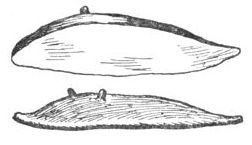
THE TREPANG
There are four known species of trepang, which is found in shallow water close to the shore. The native fishermen wade among the pools left by the tide, dislodging the trepang and throwing them on to the rocks to dry in the sun. They are later collected and taken to be boiled in copper boilers, split open, cleaned, and dried in a smoke fire. Alive they measure as much as eighteen inches long, but during the drying process they shrink considerably. In appearance the trepang is like nothing more than a gigantic snail without its shell, and is simply a big slug and in no sense a fish, except that it lives under water. It has the remarkable habit of emptying itself of its intestines when attacked, but if afterward left alone it has the equally remarkable property of growing new organs to replace those lost.
Many white men have engaged in trepang-gathering, which some years ago was the indirect cause of a tragedy on an island of the Howick group, off the Australian coast. A man named Watson, with his wife and child and a Chinese manservant, were living on the island for the purpose of bêche-fishing. One day, while Mr Watson was away from the island on the mainland on some business or other, the little homestead was attacked by the blacks. Mrs Watson barricaded herself in, and the attackers, finding themselves for the nonce unable, or afraid, to break into the house, withdrew to fetch reinforcements. Taking advantage of the lull, Mrs Watson, with her baby and the faithful Chinese, managed to get down to the beach and launch an empty oil-tank, into which they scrambled just as the natives reappeared. With improvised paddles they paddled the tank across to another island, where they landed on a reef. And here they were found later, dead from thirst and starvation. The plucky woman had kept a brief diary written with her own blood. It told how the baby had died first and how the faithful servant had gone mad from thirst before he died.
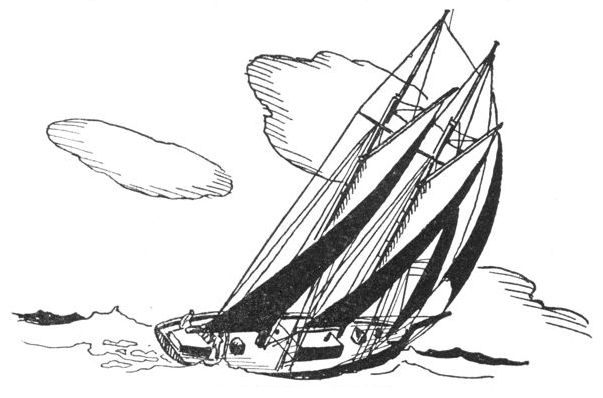
A RECRUITING SCHOONER
In Melanesia originated the inhuman traffic in black labour called ‘recruiting.’ The blacks, the stark savages of the Solomons, the Carolines, and other islands, were induced to go aboard recruiting schooners, the blackbirders of the old days, and lured by extravagant promises to go to Queensland to work on plantations and in mines. The recruits, as they were called, were bound to so many years of servitude by contracts which they very imperfectly understood, living and working under conditions no better than slavery. This state of affairs was eventually stopped by the Australian Government, and every recruiting schooner had to carry an accredited Government agent, whose business it was to see that the natives were not procured by illegal means. The perils of recruiting in Melanesia and the risks of an agent’s post are clearly shown in the story of the wreck of the Tropic Bird, told in Chapter X.
Of all the words associated with the Pacific the most significant is that short word ‘copra’—one might say King Copra, for copra is king in the Pacific. Copra, the dried kernel of the coconut, is used in commerce for many purposes. From it is made lard, margarine, oils, glycerine, soaps, and perfumes. The word comes from the Hindustani khopra and the Malay kopperah, meaning ‘coconut,’ and was shortened to its present form by the early Spanish and Portuguese traders.
The shells are broken open and placed in the sun until the drying kernel separates from it. This dried coconut ‘meat’ is copra. The process of drying copra takes, in a hot sun, three or four days, and the purpose of it is to drive out the water from the meat. The oils, of course, remain. In the most modern plantations copra is dried in vast hot-air kilns, which can deal with a ton of copra a day. Natives smoke the copra on islands where the sun is uncertain, but this results in the meat being darkly browned, and it is worth considerably less than the whiter product. A thousand coconuts will produce about 25 gallons of oil, which is extracted either by boiling or by pressure. Compounded with other substances, it will make a marine soap which can be used with sea-water. The solid matter left after pressing out the oil is known as ‘coco-stearin,’ which is used in making candles. Besides the margarine, soaps, and glycerine, etc., already mentioned, there are many by-products from copra after the oil has been extracted. One of these is a very valuable cake for cattle. In fact, copra, like crude oil, has many by-products, and, to use a metaphor, is the oil which helps the wheels of Pacific commerce to go round.
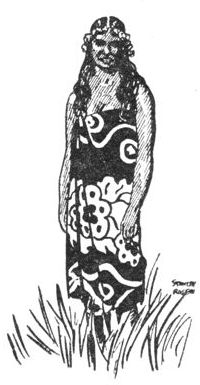
A MARQUESAN VAHINE WEARING A PAREU AND LEIS
The main language groups of Oceania are Polynesian, Melanesian, Papuan, Micronesian, and Australian. Polynesian is spoken in New Zealand, Tonga, Samoa, Hawaii, Tahiti, the Marquesas, and several lesser groups. Papuan is confined to Papua (New Guinea). Melanesian prevails in the New Hebrides, Banks Islands, Solomons, Santa Cruz, New Britain, Bismarck Archipelago, and New Guinea; Micronesian in the Carolines, Marshall, and some others, and lastly the Australian aboriginal tongue. Of all these languages Polynesian is the only one that most of us ever even remotely come in contact with. Through the medium of the literature of travel and seafaring and romantic South Sea fiction we do frequently meet with some of the commoner Polynesian words. And if the reader doubts this let him think of ukulele, a word that has become part of our language, not to speak of a number of others of like origin. The plaintive melodies that are strummed on that miniature guitar, played alike in London, New York, and Honolulu, had their origin in the South Seas. But whereas the ukulele[1] in New York and London is played in jazz orchestras and on the vaudeville stage, in Hawaii it is played in its proper setting. I have heard it coming across the still waters of a lake on a warm summer night mingled with the voices of flower-wreathed kanakas. Somewhere out on the lake they sang and played their barbaric music while their canoe drifted, and the world and strife were forgotten. In such a setting, and with the natural acoustic properties of a tree-fringed lake, the ukulele sounded vastly sweeter than when it strives to make its plaintive notes heard among the cacophony of a modern dance orchestra.
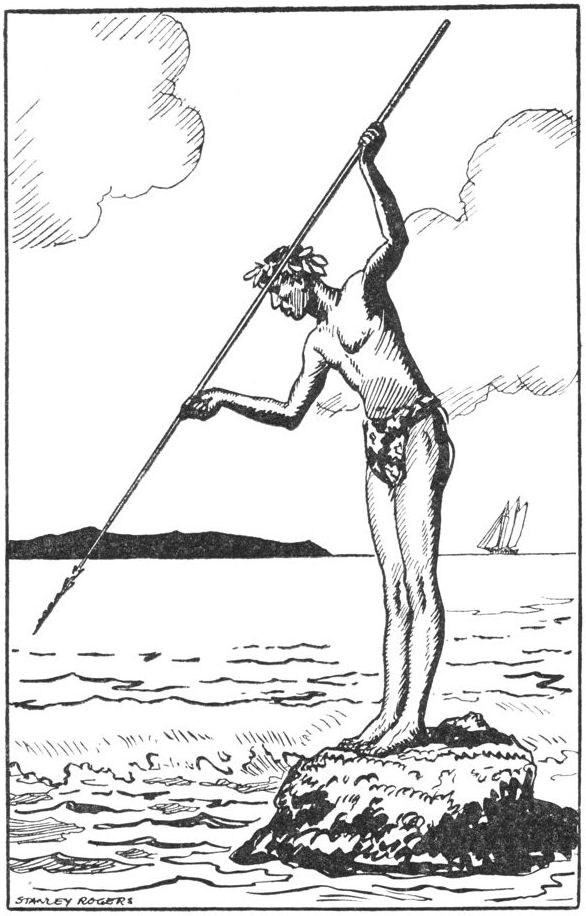
A KANAKA
‘Kanaka’ is the Pacific term for Polynesian[2] as distinguished from the other races of Oceania, and is not used in any derogatory sense. All along the West Coast of the United States and among the archipelagos of the Pacific the word ‘kanaka’ designates the brown men of Polynesia, and is not to be classed with the insulting titles of dago, Chink, and wop, so commonly used by the lower ranks of the Nordic race to indicate their contempt for certain races they make no effort to understand. The Polynesian woman is not the ‘Mary’ of the bêche-de-mer speech; she is a vahine—her own proper native title. The word ‘Maori,’ which we use to designate the native Polynesians of New Zealand, is their own word for ‘mankind.’ The so-called hula-hula is a dance, not unlike the danse du ventre of the Ouled Nails of the Sahara. Like so many primitive dances, it is largely sexual in its significance, with its swaying of hips and abdomen to the barbaric thrumming of tom-toms. But there is nothing lascivious, nothing sordid, in the character of these frank, happy, grown-up children. Life was to them made for love and laughter; and if their lack of morality shocked us it is equally true that our excess of morality, with its prudery, passions, and jealousies, shocked them. Of this dance Herman Melville writes in Typee:
The young girls very often danced by moonlight in front of their dwellings. There is a great variety of these dances, in which, however, I never saw the men take part. They all consist of active, romping, mischievous evolutions, in which every limb is brought into requisition. Indeed, the Marquesan girls dance all over, as it were; not only do their feet dance, but their arms, hands, fingers, ay, their very eyes seem to dance in their heads. In good sooth, they so sway their floating forms, arch their necks, toss aloft their naked arms, and glide, and swim, and whirl, that it was almost too much for a quiet, sober-minded, modest young man like myself.
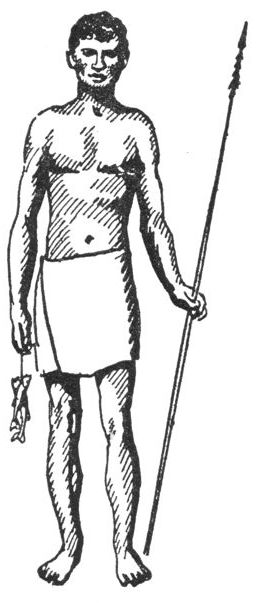
LAVA-LAVA
The lava-lava is the short garment—a mere strip of cloth, worn round the waist and extending to the knees, a sort of tight kilt.[3] This was the common and only garment of both sexes until the terrible Mother Hubbard and trousers were introduced. The lava-lava, which is now supplied by the traders in gaudily printed cotton, was, and still is in some parts, made of tapa, a substitute for cloth made from the inner bark of certain trees. The bark is stripped, wrapped up in large leaves, tied round with a piece of grass, and placed for a few days in a stream of running water until it begins to decompose, when it is withdrawn and laid out on a hard, smooth surface to be gently beaten with a sort of mallet which is grooved, on its business side, with parallel indentations. These serve to help bind the fibres together as well as further to soften the ‘cloth.’ At intervals it is dampened with water and again beaten until it becomes not only as thin as cotton cloth, but as white as bleached linen, to be later stained in a bright pattern with vegetable dyes.
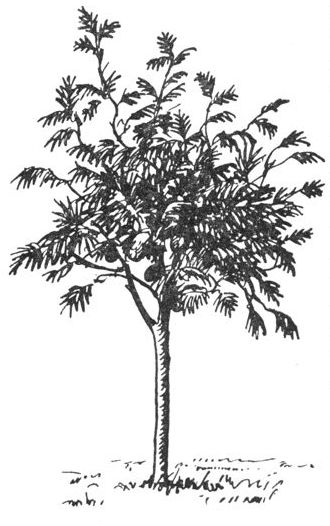
BREADFRUIT-TREE
Poi-poi, another common Polynesian word, is the staple food of the islands, as rice is the staple food of China. Poi-poi is commonly made from the root of the taro plant; but in the Marquesas the natives also make it of breadfruit. The method of preparing the food is simple. The fruit (or the root) is put into a calabash and pounded with a stone pestle into a stiff, sticky paste. It is then wrapped in leaves and put in the ground until needed, when one of these leaf-wrapped packages is placed among hot stones in an open fire and baked. Before eating it is well mixed with cold water to thin it down, and then placed in a communal dish round which the family sit, dipping their fingers into the sticky mess. A liking for poi-poi is an acquired taste.
The paw-paw is, next to the breadfruit, the most useful fruit in Oceania. It is an excellent fruit and grows everywhere in abundance, the birds carrying the seeds to the remotest islands. Its juice is rich in a ferment which has the virtues of pepsin in that it will digest two hundred times its own weight of some foods. If the fruit is rubbed on tough meat the toughness disappears. The unripe fruit is not unlike vegetable marrow after it is boiled. The seeds are eaten, and can be regarded medicinally as an aid to digestion.
Arva-root is found all over Polynesia, and from it is made, by a most astonishing process, a beverage which produces a sort of mild intoxication. It is not brewed, but it is made by masticating lumps of the root and emptying the chewed mass into a bowl. Water is poured in, and then stirred with the fingers. The chewing is done by boys, who scrupulously rinse their mouths with water before they start to chew the root. Arva is used for medicinal as well as convivial purposes.
The typical South Sea word ‘taboo,’[4] is elastic in its application. It may mean that certain things are not done as being ‘bad form,’ or that certain things are definitely prohibited. Taboo is sometimes invoked as a punishment. A native tabooed is unlucky. He is a pariah, and is avoided by every one of his fellows. For a woman to break a taboo usually meant death. It is a harsh, tyrannical fetish, but it often works for the good of the community, as when, for instance, one’s property is tabooed from theft, or when the wanton taking of fruit from trees is tabooed during a bad season. At times the taboo only applies to one person, at others to the whole community. Taboo has a religious significance: it is chiefly identified with the priests and the mystic rites of the tribes. Women were, in the past, tabooed from all sorts of things, from entering canoes to entering certain houses; and to this day on many parts of the Marquesas and other groups the laws of taboo remain as rigid as they ever were. The Polynesians pronounce the word as if it were spelt ‘tapu,’ but as it has become customary among white people to pronounce it ‘taboo’ we may as well adhere to that form. Taboo can be compared to our boycott, but among the superstitious natives it can carry a much more sinister meaning. It is a great asset in the stock-in-trade of local witch-doctors. By playing on the childish minds of his victims he can, by pronouncing taboo, reduce them to a state of utter wretchedness. A witch-doctor can starve a man to death by tabooing all food. So strong is the belief in taboo that natives have been known to die after eating food they were later told had been tabooed. Superstition killed them. A particularly grasping witch-doctor does a good trade in bribery and extortion. Most natives can be frightened into paying for immunity from a threatened taboo. The witch-doctors have every inducement to wish to keep alive these superstitions which the white men are trying, by education, to stamp out. But surely many generations will have passed before beliefs and customs so deep-seated entirely disappear.

A BEACHCOMBER
An English expression identified almost entirely with the Pacific is that hackneyed word ‘beachcomber.’ It is used all over the South Seas, but above all in Polynesia, though one can be ‘on the beach’ in Singapore or Hong-Kong, or in any port for that matter. But the wise fool, if he must beg, will choose to be a beggar on the pleasant shores of the Marquesas or Tahiti, where the airs are soft and the natives are ready to play the whole day through. The languors of these lotus-eating lands get into the blood, and the beachcomber presently ‘goes native.’ But in reality he is neither native nor white man, and soon becomes a pariah. The natives (except in certain Arcadian isles which are not yet spoiled by civilization) do not respect him, and he is no longer persona grata among his own people. Among all races it is the same; the hybrid, the hyphenate, the apostate, is respected by no one. But the beachcomber does not always go native; he may be signed on a ship, or turn his experience to literary use, and thus escape from those enervating airs that rob him of ambition and change the very essence of his nature.
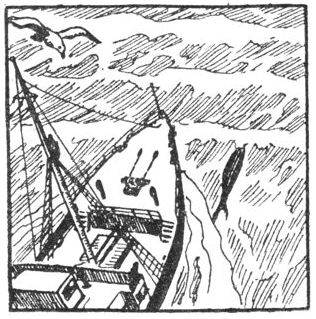
PELORUS JACK
Lastly, I must refer to a name that for years was familiar to every traveller on the Pacific—Pelorus Jack, the deservedly famous wonder-fish which for years piloted ships passing through Cook Strait, New Zealand, from French Pass to Nelson. The creature got its name from Pelorus Sound, which leads to French Pass. With most uncanny regularity it used to swim just ahead of the bows of a ship, piloting it through the strait. It visited every ship and was always alone, and so well known did it become that public sentiment caused the New Zealand Government to pass a special Act for its protection, and a passenger who once had the temerity to shoot at it was thereafter banned from travelling on ships entering the sound. Though it has been photographed and has even had a film made of it gambolling round the bows of a ship, no one seems to know for certain to what species it belonged, though it was commonly believed by many who had seen it to be a white shark. If so it was the only shark that ever commanded the respect and friendship of men. I have seen photographs of the creature without, however, being able to distinguish sufficiently its outline to identify its species. For a great number of years it regularly met the ships passing from Cook Strait into French Pass. So unfailing was its punctual appearance that when it disappeared for good some years ago[5] its loss was mourned as the loss of a favourite pet. Mystery and sensation-mongers attributed its disappearance to the War—the Germans. It may have been struck by the bow or the propeller of a ship or, more possibly, have died of old age, an event that must sometimes even be the lot of sharks.
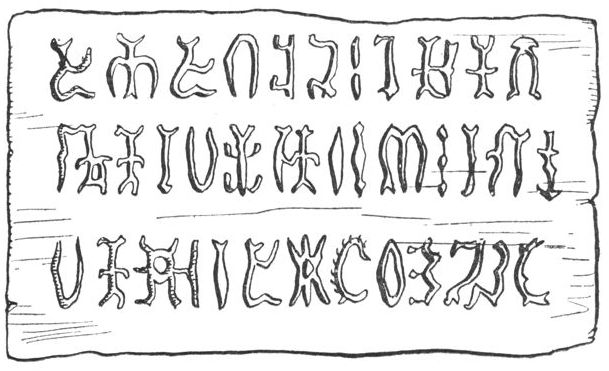
EASTER ISLAND HIEROGLYPHICS
As a footnote to this chapter I should like to refer to the wooden tablets bearing curious symbols found on Easter Island. It is germane to the subject of Pacific languages, for on these tablets are carved crude pictures and signs which point to the fact that the original inhabitants had a form of hieroglyphic writing—the only thing of its kind found over the entire Pacific. There is not much doubt that these people had the only written language in the Pacific, a fact of great interest if we pause to think upon it.
|
The modern ukulele is an American-made substitute for the original native instrument. |
|
The male sex only. |
|
Often worn longer by the women and called a pareu. |
|
The more correct spelling is tapau. |
|
In 1915, I believe. |
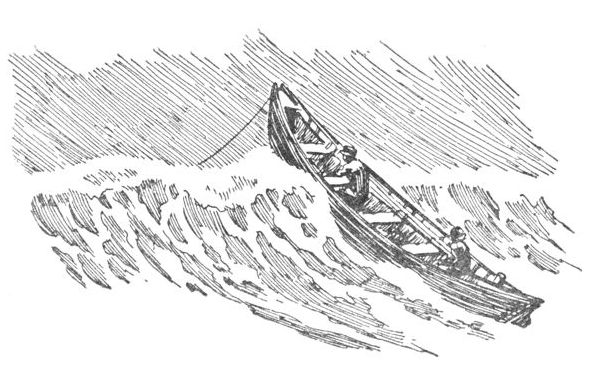
One of the most stirring tales of deep-sea adventure that has ever been written is Bligh’s official report to the Admiralty of the mutiny of the Bounty and the casting adrift of himself and eighteen companions in a small boat. But that, like the account of the lost ships of La Pérouse,[1] is history too familiar to bear repeating. But if the plums have already been picked there are still many fine records of South Seas adventure that are not so familiar and can safely be told again. All of these tales are heroic, and some are horrible, but to leave out the latter would be to give a false picture. The sea is cruel, and true tales of the sea are not for the squeamish, particularly the records of the trading schooners of Melanesia, where cannibalism was until recently practised by the untameable savages of the Solomons.
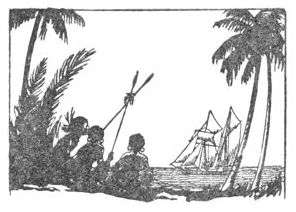
“YOUNG DICK”
Here is the gory tale of the labour schooner Young Dick, which left Brisbane on April 7, 1884, for the Solomons. Besides Captain Rogers, first mate Marr, second mate Hornidge, and Mr Popham, the Government agent, she carried seven white seamen and a Polynesian boat’s crew. By May 2 eight recruits had been obtained, and Hornidge went ashore at Mabo, Guadalcanar, to seek more recruits. He was met by two natives who invited him to go to the village, situated among the trees a hundred yards from the beach. He foolishly consented, with the result that before he had reached the village the precious pair attacked him with hatchets. Though badly wounded, he contrived to get back to the boat and escape. When he was once again on board the Young Dick weighed anchor to take the wounded man to Port Adams, where he could be properly treated. While there H.M.S. Opal arrived, and Hornidge was transferred on board her, where, in time, he recovered from his injuries. When Lieutenant Wright, of the Opal, heard of the occurrence at Mabo he sailed to that place and made a formal demand for the two natives who had attacked Hornidge. Receiving an evasive reply from the chief, he shelled the village, while the natives gathered in a group farther along the beach to watch the bombardment. Nineteen shells were sent over, without, however, doing much damage.
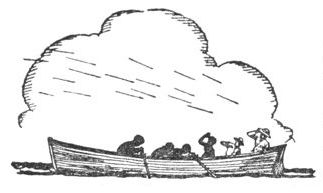
On May 11 the Young Dick resumed her cruising for recruits along the Malaita coast, one of the worst regions for native treachery. Here the schooner’s boat-crew was the object of an attack as they rowed past a point along the shore. A shower of arrows sent over wounded one of the Kanaka rowers, but a couple of rifle-shots put the natives to flight. Such trifles as that did not deter these South Sea captains from carrying on with their work, and recruiting was continued, still at Malaita. On May 20, while in Sinerago Bay, Captain Rogers went ashore with two boats to recruit, taking with him three white sailors and his Polynesians. After the boats had left six blacks paddled out to the schooner in a canoe and informed Mr Popham, who was in his bunk with a fever, that there was a native boy who wanted to be a recruit. They were told to bring him on board, and half an hour later they returned with five more blacks, including the chief and the boy who wished to sign on as a recruit. Taking advantage of the agent’s illness and the captain’s absence, other canoes came out, until the Young Dick was surrounded by scowling blacks, who swarmed on board, carrying, as it afterward transpired, concealed weapons. Besides the sick agent, there were on board Marr, the mate, Merlin, the cook, Beirr, Lagerblom, and Crittenden—carpenter, sail-maker, and able seaman respectively. Crittenden was asleep below.
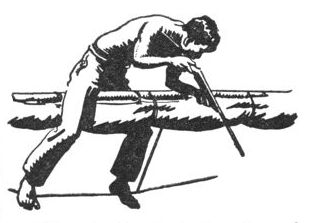
The situation was one of the greatest peril to the white men. It was madness to allow the blacks on board, but now they had swarmed on deck it was too late to avert an attack. The signal was given by the chief when Marr refused the old savage any more trade goods. The redoubtable mate knocked the chief down, and then, grabbing a revolver, shot two natives dead as they sprang at him. He now whipped round and fired at the blacks who were attacking the crew until his revolver was empty, when he snatched a Snider rifle and cartridges out of the deckhouse and continued shooting into the yelling fiends who were boarding the schooner. The unhappy agent had meanwhile been brutally slaughtered in the cabin. Crittenden, awakened by the noise of firing, ran on deck clad in his vest only. The first thing he saw was Lagerblom fighting for his life like a stag surrounded by wolves. With one jump Crittenden was again below, but only to get his revolver, with which he returned to the deck, where he ran aft, firing at several natives, who jumped overboard in their agony as they were shot. But two who tried to hold him tore his shirt off. The magnificent fellow once more escaped below, this time to thrust his legs into a pair of trousers and fill his pockets full of cartridges for the Snider rifle he had snatched from the rack. Returning to the deck, he managed to reach the shrouds and climb to the topsail yard, where he calmly sat down and potted the murderous blacks on the deck. He fired altogether fifteen shots, and to such good purpose that the savages were forced to dive overboard. With two cartridges left, Crittenden warily descended the rigging and hailed the deck. The planking was spattered with blood, and bodies doubled up in the grotesque attitudes of sudden death lay everywhere. There was nothing living on the deck, but he heard the voice of the mate, who had taken refuge in the deckhouse when his rifle had become damaged and useless. Together they searched the ship, but the other white men were dead, though thirteen recruits, hiding below, had escaped the massacre. As the mate and Crittenden entered the cabin a black who had been hiding there sprang at them with a tomahawk, but Crittenden’s revolver settled the fellow before he could do any harm. The recruits were brought up from below and enlisted and armed to resist another attack if it came, but when the ship’s two boats appeared from round a point the natives on shore gave up all thoughts of further attack and slunk back into the woods. When Captain Rogers returned he was struck with horror and grief at the news, and ordered an immediate return to Australia, where he arrived on June 1.

A RECRUITER
Here is another instance of the perils of recruiting among the Solomons—the tragedy of the Janet Stewart. In the year 1883, when the Janet Stewart was lying at Oni Harbour, Malaita, some islanders came alongside her in a canoe and said that a number of natives farther down the coast wanted to go to work in Queensland. The master, Captain Thomas, with two boats and their crews, set out to row to the place where the natives were said to be, the blacks in their canoe accompanying the boats for part of the journey. After paddling a mile or so the blacks had turned inshore and landed, after indicating to the white men that the rendezvous was some distance farther on. When, however, the two boats reached the spot and found it deserted Captain Thomas suspected treachery and ordered the return to the schooner. When the Janet Stewart hove in sight smoke was observed to be issuing from her skylight, and as the boats approached members of her crew were seen lying in huddled positions on the deck, as though they were dead. Closer inspection showed that they were, indeed, dead, butchered as they attempted to defend the vessel. Aft, on the poop, lay the mutilated body of Lockhead, the Government agent, who was attacked as he was sitting in a deck-chair reading. With such swiftness was the attack begun that Lockhead had not time to rise from the chair and defend himself before he was a dead man. The ship was found to be ransacked from end to end and fires started in the cabin and fo’c’sle. Captain Thomas descended below, calling out to see if any of the crew were alive, and he was rewarded by the sight of the cook, emerging from a half-full water-tank. During the attack the savages had searched the ship for him, one native even thrusting a leg into the tank to discover if the missing cook was there, but without finding the terrified fellow, who had just been able to crouch down out of reach of the searcher’s foot. The black returned to the tank and again thrust a leg through the opening, but went away, as before, unsuccessful. It seems that after the departure of the two boats the blacks had gathered in large numbers on one of the small islands off the shore, and from there a party had come on board on the pretence of selling fruit and coconuts, and then, at a signal from their leader, had dropped pretence and cut the crew down before they had a chance to defend themselves.
As the fire had got such a hold on the schooner that the flames could not be mastered, Captain Thomas and his men got into the boats and left the Janet Stewart to burn and, like a Viking ship of old, cremate its dead. The survivors reached the island of Uigi, where they were picked up by a passing vessel and taken to Queensland. The tale ends somewhat ironically: Captain Thomas on his return was arrested on a charge of setting fire to his ship!
Sometimes white men will outdo the savage for cruelty. Nothing I know of in the Solomons can equal for sheer fiendishness the ghastly mutiny on board the barque Caswell, carried out with unsurpassed cruelty by so-called civilized men. It was the Caswell’s first voyage, and she was on the way from Antofagasta, Chili, with nitrates for Falmouth when the tragedy happened. Her captain was an Englishman, George Best, her chief officer William Wilson, the second mate Maclean, and the steward Griffiths. There were, besides, two apprentices and Macgregor, the carpenter. The crew consisted of three Greeks, Big George, Christo, and Nicholas; two Maltese brothers, Jasper and Giuseppe; a Scotsman, Carrick; and Dunne, an Englishman.
The barque left Antofagasta on New Year’s Eve, 1876, and on that very first day out Big George refused duty when ordered to take the watch of a sick companion. Nothing more happened until January 4. On the forenoon of that day, when the captain was standing in his shirt-sleeves by the starboard main rigging instructing Big George how to put on a seizing, the Greek jumped down from the rail and drove his knife into the captain’s stomach, almost disembowelling him. The mate, who was on the fo’c’sle head, ran aft to the skipper’s aid, but did not get far, for he was attacked by the other two Greeks, who sprang out of the galley and stabbed him to death. While the captain and mate were still living they were repeatedly shot at by the mutinous Greeks.
The next victim was the steward, whom the murderers called up from below, shooting him, stabbing him, and then, before he was dead, cutting out his heart. This was Big George’s work. Now came the second mate’s turn, and after a pitiful chase round the deck in an endeavour to escape from the human wolves bent on his murder he fell, shot and stabbed in the body. With the captain, mate, second mate, and steward dead or dying, the murderers looked for more victims for their lust. They remembered the carpenter and called out his name, but, finding he had locked himself in the deckhouse, they left him alone.
Now, by that strange infirmity of purpose which sways the minds of lunatics and murderers, the mutineers suddenly ceased the saturnalia of killing. Giuseppe, who spoke English, ordered the British seamen to get out the kedge-anchor, and when this was up the four men lying on the deck, two of whom were still alive, were made fast by their legs to the anchor by several fathoms of line and dropped overboard. The carpenter was forced to go on his knees in the blood of the captain and promise to help man the ship. After cleaning the mess off the decks, the cabin and lazarette were pillaged for food, and such cabin delicacies as eggs and cold ham were handed round. The ship’s name was now painted out wherever it appeared, and the mutineers announced to the rest of the crew that they were going to leave the ship at Valparaiso. A week later they had decided to take the ship instead round to Buenos Ayres, where Jasper the Maltese had a wife and family. Jasper was not a bad sort, and more than once shielded the innocent members of the crew from the treachery of the others. But he and his brother left the ship in a boat when off the River Plate. Before leaving he told the men that Big George intended taking the vessel to Greece. After the two Maltese had gone the mutineers very plainly did all they could to provoke trouble with the loyal men. They more than once threatened to kill the carpenter, whom they forced to be cook, and once Big George threw a pan of scalding hot rice in his face. But the unarmed men fully understood that to start a quarrel would give the mutineers the chance they wanted—an excuse for murder—so the poor devils held their tongues and suffered every indignity passively.
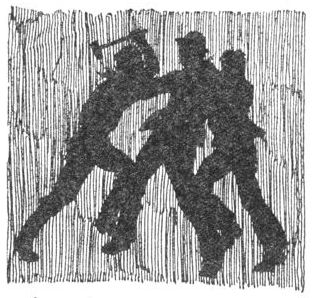
On March 13, when the Caswell was half-way up the Atlantic, and at two o’clock in the morning, Macgregor, the carpenter, came forward and told his companions that he had again been threatened by Big George and that they were all going to be killed. At this the men decided to make a desperate attempt to retake the ship. Two of the Greeks were asleep in the cabin aft, but Big George was on deck. The time was propitious for an attack. Arming themselves with hammers, except for the carpenter, who secured a hatchet, the men made a rush toward the poop, but were met amidships by Big George. Being outnumbered, and by desperate men, the Greek had little chance, and went down unconscious under the bludgeoning from the men’s hammers.
Leaving Big George lying on the deck, the men hurried aft into the cabin, where they found that the two Greeks had been awakened by the noise above, and were in the act of getting up. A desperate fight ensued. Nicholas, who was armed with a revolver, fired three shots at the invaders, though without doing any damage. But after a ferocious struggle, during which the cabin was half wrecked, the two mutineers were overpowered. The humane victors did what they could for the vanquished in attending to their wounds, but despite their efforts Nicholas and Big George died. Christo, who recovered, was put in irons.
Under the temporary command of Carrick the Caswell was brought to Queenstown, where she was towed in by the gunboat Goshawk, who put on board her five marines under a petty officer. Christo was sent to Bridwell Prison, tried, and sentenced to death. Three years later one of the two Maltese brothers, who had left the Caswell when off the River Plate, was arrested and brought to England, where he was tried and found guilty. The Caswell, under other masters, sailed the seas for many decades after this tragic event, but never again were her decks the scene of such a tragic event.
Of all adventure on the seas that of mutiny is the most terrible, though in the heyday of the American whaling industry in the Pacific men frequently went through experiences that reached the acme of physical suffering. I refer, not to the mutinies on board the whalers, of which there were some fearful instances, but to those instances of whalemen being adrift and alone in a small boat in mid-ocean. The story of the American whaler Janet, hailing from Westport, Maine, is perhaps not too well known.
Toward the end of June 1849—the 23rd, to be exact—when off the coast of Peru, whales were raised, and Captain Hosmer sent off three boats in pursuit, he himself being in charge of one boat. All the boats had luck, each being fast to a whale, and the usual signals were made to the ship to bear down to them. As the catches were scattered, and the Janet could not pick up all three boats at once, Captain Hosmer ordered his men to begin towing their whales, not an uncommon thing to do. After they had started on the slow pull back to the ship the wind strengthened and the seas grew choppy, with the result that in a moment of negligence one of the whale-boats—the captain’s—turned over and threw men and gear into the sea. Most of the gear was lost, including the keg of water, compass, and bucket.
The boat was righted, but she remained nearly full of water, and to keep her from capsizing again the oars were lashed across the gunnels. While chasing the whale, whale-boats were frequently capsized, and this accident would not in itself have been at all serious had the boat been picked up by the ship. Whalemen went out prepared for just such an emergency, and the lashing of oars across the thwarts was always done when a boat had been badly damaged by the flukes or the jaws of a cachalot. But what was unusual and inexplicable was the failure of the ship to pick up the men. Having lost their bucket, they had no means of baling the boat, which, with its load, now floated awash—a miserable position for the distressed whalemen to be in.
Within a mile or two rode the other boats, and after the ship had come down to them and made fast to the whales the captain’s crew expected, as a matter of course, to be picked up. One can judge of their bitter alarm when they saw the barque bear away on another tack after approaching within a mile, and the agony of mind of the men as night came down with the ship farther away than ever.
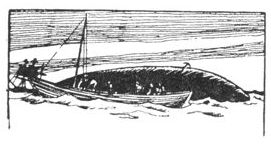
Sitting waist-high in the icy-cold water, the wretched men pulled their boat into the lee of the whale’s carcase, which being afloat made a natural breakwater. They tried to bale out their craft, but after they had worked for some time with hands and caps and finding no lowering of the water this was given up. Seeing the lights of the Janet some miles away, and still having their mast and lugsail, they set sail in their waterlogged boat toward the barque. When daylight came they were shocked to see their objective as far away as ever, and their frantic signals were apparently not seen.
When the Janet reached port the mate, who was in charge, reported to the owners that his and the second mate’s boat had been picked up by the ship, but though they searched for three days for the captain’s boat, they could not find it. In the end they concluded that the missing boat had met with disaster; possibly dragged under by the whale it had been fast to. It seems incredible that some sharp eyes from aloft could not sight the boat, and the failure to pick up the men suggests gross negligence. But all this happened eighty years ago, and it makes little difference to know why the mate failed to find the boat; the important thing is that the ship sailed away, leaving the waterlogged whale-boat full of men, without food or drinking water, adrift in the Pacific a thousand miles from land. The situation was not only desperate, but seemingly hopeless; the men might as well jump into the sea and save themselves inevitable suffering before they surely perished. But men who go to sea are not made that way; they are not so easily discouraged, and while there was life there was hope of being picked up.
During the second day they made another effort to bale the boat, and before dark had succeeded; but in the process had lost two men over the side. Two more were raving from their sufferings. This already—after two days in the boat! There seemed no chance at all that any of them could survive. But Captain Hosmer was a man of unconquerable spirit, and he determined to try to reach Cocos Island, which was estimated to be a thousand miles away. Having neither compass nor sextant, he must steer by instinct and by observing the ocean currents and the stars. For a week there was neither food nor water for the castaways, and they discussed the idea of sacrificing one of their members to provide—terrible thought!—food for the rest. Suffering had made the men apathetic, and there was no dissenting voice to this proposal. So lots were drawn, and the loser submitted to his horrible fate without protest. Cannibalism among white men has happened more than once when driven desperate through hunger, and the records of the South Sea whalers contain many confessions of this sort of thing.
After this it rained and the survivors slaked their burning thirst, and then bountiful Fate, tired of sporting with the poor wretches, sent them a dolphin, which, in its gambols, fell plump into the boat. Then, on July 13, they saw to the east the low grey shape of distant land, and on the following day, twenty-one days after they had left the ship, they crawled ashore more dead than alive. They had landed on Cocos Island, Captain Hosmer’s objective; and when one looks on the chart at the pinpoint of Cocos Island one’s respect for the captain’s navigating ability increases proportionately. Here they found the New Bedford whaler, Leonidas, which had put in at Chatham Bay on the north side of the island for water and wood. But of the original six men in the whale-boat only two, Captain Hosmer and a sailor named Cortez, crawled ashore. Two had been drowned at the outset while they were baling the boat, one had died, and the fourth had been sacrificed to save the others.
And now, as a respite from tales of mutiny and cannibalism, here is an adventure of an altogether different character, a robustious yarn of the sea which happened not so long ago and leaves no aftermath of horror. This is the true record of the three men who, in a small boat, lived through a hurricane; but it is more, it is one of the few authentic cases in the history of the sea where a boat has survived the experience of being completely rolled over by the seas.
As most people are aware, a typhoon is a giant, whirling cone of air with a tremendous velocity at its periphery, but absolutely calm in its centre. This cone, spinning like a Gargantuan and invisible top, travels across the ocean whipping up such mountainous seas that only the staunchest vessel, manned by skilled seamen, can live through one.
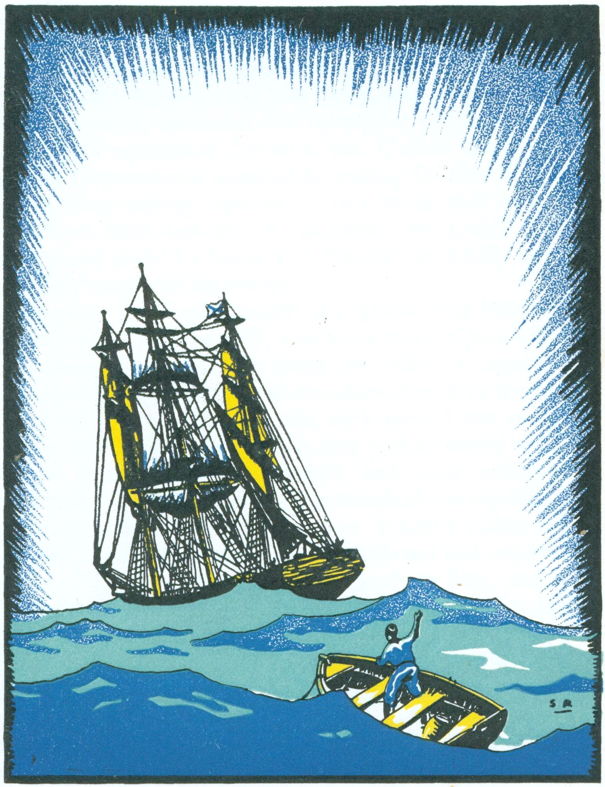
THE RESCUE
In June 1912 Captain Voss, who a few years before had made the famous voyage round the world in the Chinook canoe Tilikum, was in Yokohama, out of a ship, when two young Englishmen named Stone and Vincent approached him with a proposal that he should accompany them round the world in a 25-feet yawl that Stone was having built.[2] Voss had been in command of a sealer, but the then recent international agreement between the United States and Japanese Governments prohibiting sealing for fifteen years had put many sealing captains out of a berth, and, as Voss had neither home ties nor job, he looked favourably upon the proposal made by Stone and Vincent, especially as he liked the young men themselves.
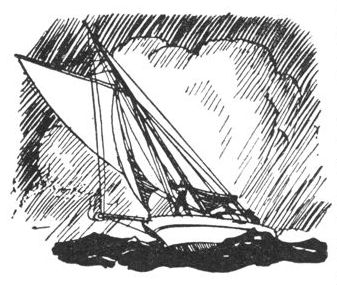
The yawl, which was named Sea Queen, was launched early in July, and on the 26th, with three months’ provisions, 120 gallons of water in the tanks, two rifles, a camera, a gramophone, and navigating instruments, the three men set sail on their world voyage. As they passed out of the harbour the British ensign which they had displayed somehow got adrift and fell overboard, and some onlookers were heard to make a disparaging remark about the British flag being hauled down, whereupon Vincent called out, “Never!” and, fully dressed, dived overboard and retrieved the flag. The Sea Queen proved a good sea boat, but on August 5, while riding to a sea-anchor, hove to in a stiff gale, she began leaking so badly that Voss advised turning back for repairs. The others were reluctant to do this, but the experienced captain talked to them of the folly of facing the Pacific traverse, the longest in the world, in an untried and leaky boat. It was the skipper’s birthday; he was fifty-four years old, and his judgment was bowed to without question. It took them five days to cover the 500 miles’ distance to the whaling station of Aikawa on the Japanese mainland. Here repairs to the Sea Queen were carried out, and the three voyagers made their second start on August 22. A course was set for the Marshall Islands, and for the first three days the winds were light and little headway was made. On August 25 it came on to blow from dead ahead, and during the next two days the force of the wind increased with a corresponding rising of the seas. The course was south-east. On August 28 the wind moderated to a breeze, but the heavy swell on the sea was increasing, the barometer was falling, and there was a fiery glow around the sun. Voss read the signs of an approaching typhoon, and warned his shipmates. There was a bigger swell on the sea, and the glass was still falling. The typhoon could not be far off now. On August 30 the wind increased to a gale, and there were heavy rain squalls that laid the boat over to leeward. All canvas was taken in except for a reefed mizen and storm staysail, and the boat was left thus until 2 p.m., when she was hove to with a sea-anchor and riding sail. By two the next morning the seas were so high that oil bags with holes punctured in them were hung over the side, and their effect in flattening the tops of the breaking seas at once became apparent. At nine o’clock in the morning it was blowing so hard the men had to lie flat in the cockpit, and though the Sea Queen was riding the hurricane splendidly, the oil now had almost no effect. Voss was in the cockpit and Stone and Vincent were in the cabin when the line to the sea-anchor parted and the boat broached to. The crew felt her fall broadside into the trough of the seas, and Voss yelled, “All hands on deck!” The sea-anchor was lost, but a makeshift one was made with the cabin ladder and a small anchor as the three men lay flat on deck. This was paid out over the bows, and, though not of much help, it held until 11 a.m., when the second line parted and the boat again broached to.
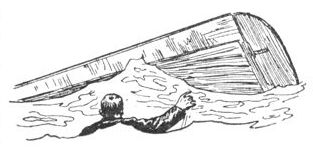
Then, without warning, came disaster. A huge sea struck the boat and rolled her over so that the keel pointed to the sky. Voss says that when he found himself in the water he decided to die quickly rather than prolong his misery by keeping afloat until he perished; but as he rose to the surface he saw the keel of the boat uppermost and without further thought hauled himself up on to it. His two friends would still be inside the cabin, and he felt desperately that he must try to right the boat to save them. At that moment another sea struck the craft and slowly rolled her over on to an even keel. Voss scrambled over the gunwale as she righted. While he lay, half drowned, in the flooded cockpit the scuttle opened, and he heard Vincent shout to ask if he was safe. A moment afterward Vincent and Stone appeared from the cabin, apparently none the worse for their experience; but both Voss and Stone discovered when they had time to think of themselves that they had got considerably damaged as the boat went over, Stone getting struck by the gramophone in the cabin.
The typhoon was now at its worst, and the Sea Queen was flooded with water which had to be baled out quickly if the craft was to float. Somehow the three men managed to get her on the port tack and make a start at baling out the water. The business of baling out the cabin was laborious and slow, owing to the necessity of keeping the scuttle shut, only opening it to pass out the full bucket and receive the empty one. All the time this was going on the typhoon raged unabated. The cabin was completely wrecked, and nearly half full of water; clothing, bedding, furniture, books, provisions, and oil were all mixed up and floating about in the flood. The baling was done with an empty five-pound sugar-tin, and during their efforts to rid the boat of some of the water in her Stone was twice washed overboard, but on each occasion was washed back again.
By the time the cabin was comparatively free of water the sea outside had gone down and was now dead calm, a sure indication that the boat was in the centre of the typhoon. But Voss knew that they would have to go through the other side, and they could hardly expect to escape capsizing with no sea-anchor and no means of keeping the boat’s head on to the seas. Meanwhile they profited by the lull to get the tangle of gear on board. Both masts had snapped off and floated alongside, attached to the boat by their stays and rigging. The only things on board that were dry were the matches, which were in a watertight tin, and there, while actually in the centre of the typhoon, they got the oil-stove going and prepared some hot food. It might quite likely be the last meal they would ever have, especially if the prophets who said that no craft which gets into the centre of a typhoon can ever get out again were right. In less than an hour the wrecked Sea Queen had drifted to the other edge of the terrible circle and had entered the second stage of her disastrous experience. But now, with the spars gone, she was safer, and, with her heavy keel and absence of top-hamper, she rode out the typhoon, and emerged, battered—shall we say?—but victorious. The trim little yacht that had so recently left Japan, smart with her white-painted sides, varnished spars, and shining brasswork, had been thrown out of the centre of the typhoon a poor broken thing, like a crippled bird. There was no hope of continuing the voyage, and so with difficulty a jury-mast was rigged with lashed spars, and, with a storm trysail only, the Sea Queen crawled back toward Yokohama, 350 miles away. Owing, however, to the chronometer being out of action, observations were difficult to get accurately, and the boat finally put into Habu Harbour, where the three men found the village had been wiped out by the typhoon and a 2000-ton steamer had been sunk with a loss of forty lives.
Voss and Stone had to be treated by a doctor and were laid up for some time with their injuries; but though they eventually recovered, the voyage, for sufficiently good reasons, had to be abandoned.
A Pacific adventure which seems to me not to have had the publicity it deserves is the flight of the aeroplane Southern Cross from Oakland, California, to Brisbane, Australia, in June 1928. This, the longest trans-ocean flight that has ever been done, was made in three enormous ‘hops’ of 2400, 3200, and 1700 miles respectively. The first stop was Honolulu, and the second Suva, in the Fiji Isles. The Honolulu-Suva part of the flight was in itself an amazingly daring performance. The flyers were thirty-four hours out of sight of land, and passed through heavy storms which nearly brought disaster. And the Southern Cross, it must be remembered, is a land machine, and incapable of remaining long afloat on water in the event of a forced landing. The men responsible for this fine flight were Captain Kingsford-Smith and his co-pilot, Captain Ulm, with Lieutenant Lyon as navigator and James Warner as wireless operator. The pilots are Australians, while Lyon and Warner are Americans. Each member of the party was necessary to the success of the enterprise, and equal credit should go to each. The Southern Cross has since crossed the Atlantic, a double distinction. It is a tri-motored, high-wing monoplane, and carried, on the Pacific flight, three tons of fuel. Nevertheless, it arrived at Suva with only thirty gallons of petrol left in the tanks, after refilling at Honolulu. The landing-field at Suva was found to be too small to allow sufficient run for a heavily loaded machine to rise, so they took off with barely enough petrol to carry them the 1700 miles to Brisbane. They reached the Australian coast just in time, after passing through several violent tropical storms—the first conquerors of the Pacific by air. The leader, Kingsford-Smith, has since carried through other record-breaking flights, though it is difficult to imagine him ever surpassing in daring that amazing dash across the greatest ocean in the world.
The last of these brief histories concerns the mysterious loss of the steamship Pelican, belonging to the Northern Pacific Steamship Company. The Pelican was a single-screw iron steamer of 2400 tons, built at Glasgow in 1882. She had been on the Atlantic for some years when she was bought by the Northern Pacific Steamship Company to sail between Puget Sound and the Asiatic ports. On October 12, 1897, with a crew of forty men, she left Port Townsend, Washington, with a cargo of railroad ties[3] for Northern China. She had orders to call at Yokohama for coaling, but she never reached that port, and was never seen again. In October and November the Northern Pacific was swept by a succession of heavy gales, and when the Pelican had become long overdue, and, in February 1898, had been posted at Lloyds as missing, it was concluded that she had foundered in a gale. The insurance was paid to the owners, and the loss of the ship was almost forgotten, except by the bereaved relatives of the missing crew. Among these was Mrs Patterson, wife of the mate of the Pelican, Milton Patterson. She had had a premonition of danger and had begged her husband not to sail on the ship, but he had gone, and the wife’s fears proved to have been justified.

THE “SOUTHERN CROSS”
Then, more than a year and a half after the disappearance of the Pelican, Captain Thunell, of the American schooner Herman, found a bottle containing a message written by Milton Patterson which had been washed up on the beach at Portage Bay, Alaska. The message read:
S.s. Pelican; latitude 50 North, longitude 175 West. The ship is sinking. We are leaving her in frail boats. Please report us.
M. T. Patterson,
Chief Officer,
Port Townsend, Wash., U.S.A.
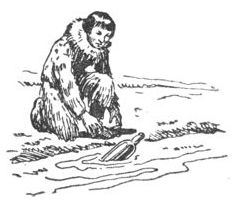
Mrs Patterson when shown the message recognized her husband’s handwriting, and established beyond any doubt the authenticity of the message, which was written on one of the steamship company’s printed memoranda forms. Fifty North and 175 West is roughly 150 miles south of the Aleutians and over the famous Albatross Deep. Portage Bay is about 1800 miles from the spot where the bottle was thrown into the sea by Chief Officer Patterson when the Pelican was in difficulties.
The finding of this message moved Mrs Patterson to arouse public interest, and the United States Government ordered the revenue cutters in the Bering Sea to search the islands. The cutter Grant searched from Dutch Harbour to Attu Island without finding any trace of the lost men. Then nearly a year later—that is, on February 9, 1900—another bottle message from Patterson was picked up on Ukomok Island by Eskimos, who handed it over to the agent of the Alaska Commercial Company at Kadiak, Alaska. The message was in the same handwriting and on the same printed form as before, and read:
The s.s. Pelican is about to sink. We are leaving her in frail boats. We realize our fate. God bless my darling wife.
M. Patterson,
Chief Officer,
Port Townsend, Wash., U.S.A.
After that no more messages were ever found.
The long drift of these two bottle messages from the mate of the Pelican was nothing unusual. The Hydrographic Department of the United States Navy have experimented with bottle messages in the Pacific and obtained most interesting results. Every year hundreds of sealed bottles containing the date and position of the ship and a request that the message be forwarded to the nearest hydrographic office are cast overboard all over the world. The longest drift ever recorded by a floating bottle was one of nearly 12,000 miles from the Southern Indian Ocean across the Pacific to Cape Horn. It took exactly three years—from May 1909 to May 1912.
A more recent instance of a long drift was the voyage of a bottle picked up on the shore of one of the Philippines in February 1929. The message inside stated that the bottle had been set adrift on September 27, 1927, from the steamer K. R. Kingsbury off the coast of Lower California. The distance the bottle had travelled across the Pacific was 8300 miles.
|
Both stories are in the author’s book Ships and Sailors. |
|
Captain Voss tells the story in his book The Venturesome Voyages of Captain Voss (first published in Yokohama in 1913). |
|
I.e., railway-sleepers. |
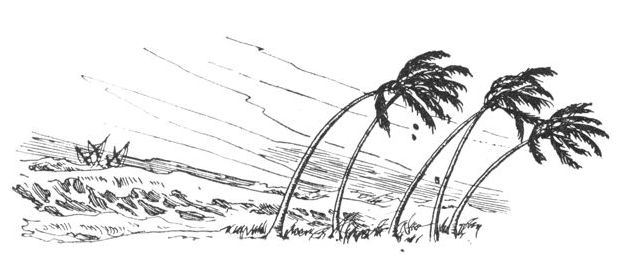
Accounts of shipwrecked sailors cast away on remote islands are frequently darkened by confessions of sordid quarrelling and intrigues, followed by the breaking down of morale. In fact, a happy, jolly, romantic shipwreck is almost unknown outside the realm of fiction. But in the story of the wreck of the packet Antelope on one of the Pelew Islands in the year 1783, and the subsequent experiences of her crew and passengers, we have something which might have been taken out of one of the highly coloured pieces of fiction of the day, so bizarre was its action and so touching its finale. Perhaps this tale is the only exception to prove the rule. However that may be, the wreck of the Antelope stands as a pattern for the romantic school, and, like the fictions of Captain Marryat, it conforms to the best traditions of adventure and noble virtue. For the benefit of those who are not familiar with the story, here it is.
The East Indiaman Antelope, with passengers and cargo, left Macao late in July 1783, homeward bound, and on August 9, during a black squall, was driven ashore on one of the Pelews, which belong to the westerly group of the Carolines. The Pelews had been first seen by the Spanish Admiral Villalobos, but no white men had ever (in 1783) been ashore there, and rumour had it that the natives were a bad lot—that, in fact, they were cannibals.
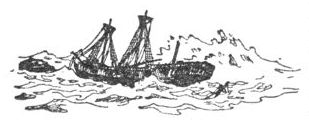
THE WRECK OF THE “ANTELOPE”
When the Antelope struck, her master, Captain Wilson, remained calm, and by his example inspired the entire ship’s company to act likewise. The ship, under the crashing blows from the monstrous breakers among which she lay, began rapidly to break up, and the captain ordered a large raft to be built of spars lashed together and covered with planking. Under the direction of the carpenter many hands set to work, and within a short time a serviceable raft was afloat and loaded with stores and gear. After considerable risk due to the height of the big rollers the raft, with its precious freight, was towed ashore by the crew in two boats. The spot where the ship had struck was the entrance to a sandy cove, and when at length the last boat was landed and the roll was called it was found that not a single person was missing. So far, apart from the misfortune to the ship itself, all was well. The carpenter had even salved the tools.
Tents made of sail-cloth were erected, and by nightfall little groups of castaways sat around camp-fires discussing the remarkable events of the day, until one by one they crawled into their tents to fall asleep. The fires died down, and all slept save the sentries on guard.
Next day two canoes were seen approaching the cove, and Captain Wilson, taking with him a member of his crew who understood Malay, went down the beach to meet the newcomers. He found the natives to be friendly and quite unafraid, as if they came from some Utopia where men had no reason to cultivate fear. The captain took them to the camp and gave them some of the white man’s food, which they tasted for the first time in their lives. A palaver was now held, and after cautious inquiries on the part of Captain Wilson it was decided that his own brother, who was among the castaways, should go with some of the natives to interview their King, who lived on a neighbouring island. As hostages three of the natives and one canoe remained behind. One of these natives was the King’s own brother, and, like his companions, was entirely naked. His brown body was anointed with coconut-oil, and his arms were decorated with exquisitely wrought bracelets of bone.
Captain Wilson well understood the necessity of keeping the respect of the islanders and harangued his crew, exhorting them to be men and abstain from any act that would lower the prestige of the white man. The men cheered the captain’s speech, and even agreed to forgo their grog ration and for the present abstain from all intoxicating liquor. How often accounts of shipwrecked sailors have been marred by discontent, drunkenness, and mutiny, but here can be recorded a rare instance of esprit de corps, and in the last place one would expect to find it. The captain was fortunate in his crew. Thus far everything was turning out well, though, not unnaturally, the shipwrecked company awaited anxiously the return of their ambassador from the home of the native King. After a few days more canoes appeared, one bringing a charming young man, the King’s own son, who gracefully, unconscious of the irony of it, bid the castaways welcome on behalf of his father. He explained that the captain’s brother was staying for a while with the King, but would return soon. Meanwhile would the English chief cause a large boat to be built so that he and his people might go to visit the King? Before anything was done about this, however, the great man himself arrived, with many canoes and armed men blowing a fanfare on conch-shells. It was all very thrilling, perhaps a little too thrilling for the anxious castaways, but there was no need for anxiety. This was not an ordinary adventure of shipwrecked men among cannibals. The King, who was called Abba Thulle, was an uncommon man with great personal charm and an entire absence of the usual cupidity of native rulers. His first friendly gesture was an offer to lend a number of his own men to help build a boat large enough to enable the white people to depart to their own country.
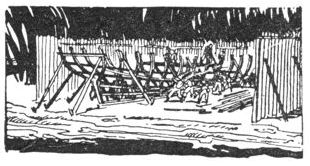
The King tarried awhile with his strange white guests, and marvelled at their mode of life, at what they ate and the way they put covering on their bodies. But most of all he marvelled at the deadly power of the terrible fire tubes they carried, and he indicated to Captain Wilson that it would give him great happiness to have the loan of half a dozen white men with their fire tubes to assist his own men to punish an enemy who had grown troublesome of late. With the magic weapons the spears of his enemy would be as naught. On hearing of this the entire crew of the Antelope volunteered to help the amiable King, but in the end only five men were chosen, one being Mr Cummings, the third officer of the ship, who was to be in charge of the seamen.
The punitive expedition started, and the rest of the castaways began the building of a boat, every one, crew and passengers, sharing in the work. A strong palisade of timbers was erected round the ‘shipyard,’ and two small swivels mounted thereon as a precaution against any possible attack from other natives, who might not feel so friendly disposed as the followers of King Abba Thulle. The wreck, which lay out in the farthest breakers, was accessible in favourable weather, and from it the crew were able to salve a quantity of cordage and oakum, besides stripping the hull of copper and ironwork, which was used in the construction of the new vessel. Meanwhile the five warriors returned from the wars with a wonderful story of victory. The King, full of gratitude, wished to do something for the white men, and announced that he would give them the island. Captain Wilson graciously accepted the royal gift with suitable ceremony, at which three volleys were fired and the flag run up. The King thereupon gave the island a name meaning, in native speech, Englishman’s Land. After this the captain paid a return visit to the King’s island, and another attack on the enemy was arranged, the captain lending ten men this time. The attack was successful, and the gratitude of the King and his people was unbounded. The castaways had been four months on the island; the boat was now finished and successfully launched. The King invested Captain Wilson with the Order of the Bracelet, a distinction awarded only for the most meritorious conduct.
When the white people departed (with the captain’s brother, who had returned to the island) in their boat, which had been christened Ooralong, they had with them the King’s son Lee Bo, whom he was sending to England for experience and education—a remarkable act of faith, considering that four months previous to that the noble savage had neither seen nor heard of white men. With the blessing of the King the boat sailed away,[1] and in the course of time safely came to Macao. After selling the craft for £100 Captain Wilson and the King’s son took passage on a homeward-bound Indiaman. When he had settled down in England the young man was sent to school at Rotherhithe, where he became very popular. Within a year, however, he sickened with smallpox and died. His body was buried in London, in a foreign land, but as a tribute to his memory a stone was erected bearing this inscription:
TO
THE MEMORY OF
PRINCE LEE BO
A NATIVE OF THE PELEW, OR PALOS ISLANDS,
AND SON OF ABBA THULLE, RUPACK OR KING
OF THE ISLAND OF COOROORAA,
WHO DEPARTED THIS LIFE ON
THE 27TH OF DECEMBER, 1784,
AGED 20 YEARS
THIS STONE IS INSCRIBED
BY THE HONOURABLE UNITED EAST INDIA COMPANY
AS A TESTIMONY OF ESTEEM FOR THE HUMANE AND
KIND TREATMENT AFFORDED BY HIS FATHER TO THE CREW
OF THEIR SHIP, THE “ANTELOPE,” CAPTAIN WILSON,
WHICH WAS WRECKED OFF THAT ISLAND
IN THE NIGHT OF THE 9TH OF AUGUST, 1783.
Stop, Reader, stop—let Nature claim a tear:
A Prince of Mine, Lee Bo, lies bury’d here.
In gloomy contrast to the very pleasant tale of the Antelope castaways here follows an account of the experiences of the crew of the schooner Grafton, driven on to the rocks of one of the lonely Auckland Islands in January 1864. The Grafton, Captain Musgrave, had left Sydney on a sealing voyage when she ran into a heavy gale while beating into Carnley Harbour, Auckland Island. Here the anchor was let go, but the wind increased to hurricane force and the hook began to drag. The schooner was driven on to the black rocks, and by some miracle of good fortune the captain, his mate, Mr Raynal, and the crew of three managed to get ashore in the boat with a few provisions and the clothes they stood up in.
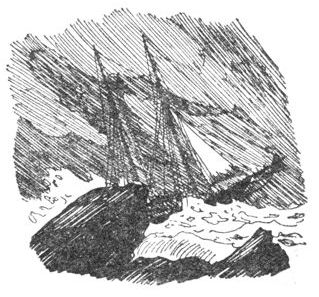
THE WRECK OF THE “GRAFTON”
The Aucklands are bleak, uninhabited islands; the terrain is rocky and sparsely grown with stunted, wind-blown trees. In those latitudes the winter is very severe, and a most inhospitable spot it is upon which to be cast away. But sailors are naturally resourceful, and these men began at once to make the best of the situation. They erected a tent near a stream of fresh water, and gathered sufficient wood to light a fire and dry their clothes. When the weather had moderated they took the boat out to the wreck and brought back new stores. The next thing they did was to build a hut, which they thatched with grass, and this shelter was much more efficacious than the tent for keeping out the icy winds which blew across the islands. From wreckage they constructed rude bunks and furniture for their abode, alternating this labour with the hunting of seals and sea-lion, in which in certain seasons the islands abound. These animals, through lack of experience of the ways of men, were quite fearless and soon became a great nuisance. As the months passed by the men learned by experience how to adapt themselves to every situation, and they discovered that the nearer they lived to the animal state the better they could endure the rigorous conditions of life on the island. To think overmuch of the niceties of civilization weakened one’s philosophy of endurance. Their existence consisted of hunting, eating, and sleeping—the life of animals with little to adorn it.
A look-out station was erected on a hill-top, and a flagstaff was set up to attract the eye of any passing ship. Many heavy gales had visited the coast while the men were there, but none had dislodged the wrecked schooner from her position among the rocks. The men decided to get the ballast out of her, a slow and laborious task, and attempt to build a smaller craft from the timbers. A start was made, but lack of tools brought the shipbuilding to a halt before it had fairly begun, and the project of building a boat had to be abandoned. Then some one suggested lengthening the small twelve-foot boat they had ashore. This was attempted, and after almost hopeless difficulties the old and frail craft was lengthened a few feet, and on June 27, 1865, was launched. It was ballasted with salted skins and provisioned with seal-meat and a few sea-birds of the sort known as shags. Captain Musgrave, Mr Raynal, and one seaman went in the boat, the other two men preferring to stay behind and chance being picked up. A course was laid for Stewart Island, at the southern end of New Zealand, but on account of bad weather it was not until July 19 that the boat could be put to sea. Twenty miles from land a gale blew up, and for five days the three men were in great peril from the boat breaking up and sinking under them. But on the sixth day dry land was sighted, and this proved to be Stewart Island. At Port Adventure the men were received by a Captain Cross, of the schooner Flying Scud, who lost no time in leaving for Auckland Island, where he picked up the two men who had remained there. Thus ended an adventure which had extended over eighteen months.
It is a remarkable and tragic coincidence that while the castaways were leaving the southern end of Auckland Island a large ship, the Invercauld, Captain Dalgarns, Melbourne to Callao, was wrecked on the northern end, and six of her crew were drowned. Nineteen people were washed ashore. Among these were the captain and the chief officer. But these nineteen people did not have the meagre good luck of the schooner’s men, and died from privations, one by one, until only the captain, the mate, and one seaman were left alive. After being marooned for a little over a year these three were rescued by a Portuguese ship, Julian, from Macao to Callao, with Chinese passengers. She had suffered in the heavy weather, and, finding a bad leak, her captain, noticing a fire on shore, had sent a boat to see if he could get assistance, but found instead that he must render assistance. The wretched castaways were saved, the leak was got in hand, and the ship proceeded on her way.
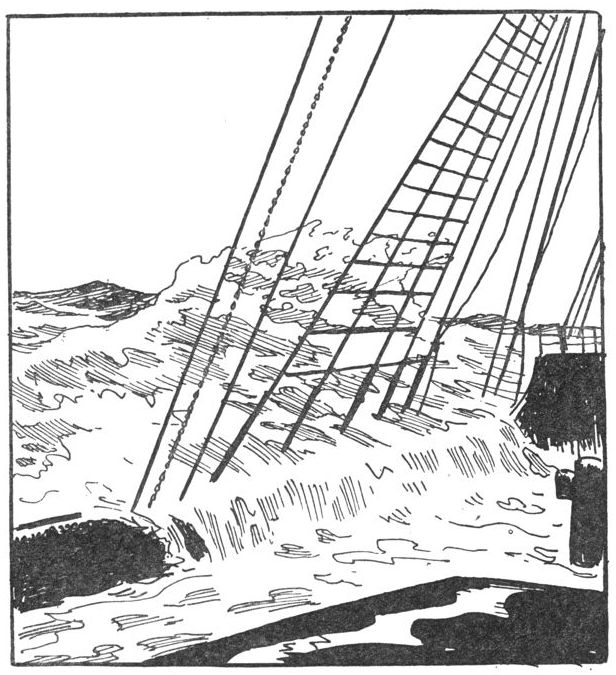
In the days of sail the Auckland Islands bore an evil reputation for wind-driven ships. The list of wrecks on those remote and rocky isles is a long one. Indeed, so notorious are these rocks that the New Zealand Government keeps a relief steamer which calls periodically at the Aucklands to look out for and pick up the castaways who are not infrequently found there. On November 16, 1907, the crew of the relief steamer, Hinemoa, passing Auckland Island, one of the group, saw a dirty white flag at the top of a flagstaff on the shore. A boat was sent off, and they found fifteen men, the survivors of the four-masted barque Dundonald, which had been wrecked on Disappointment Island, another of the group, eight months before, with the loss of twelve lives. The Dundonald left Sydney on February 18 with a cargo of wheat for Falmouth, England. The ship met bad weather from the start and for over two weeks laboured in heavy gales. One night in a thick mist, seventeen days out, she struck at the foot of rocky cliffs 200 feet high, and at once began to break up. Shortly afterward she went down, taking the captain, his sixteen-year-old son, and some of the crew with her. Others were dashed to death on the rocks trying to get ashore. When morning came nothing remained of the Dundonald above the sea but the tops of her masts, to which clung the miserable survivors. By means of the mizen topsail yard, which was touching the cliffs, some of the men were able to get ashore, and with a makeshift rope-ladder they assisted the rest of the survivors to land. When a roll-call was taken there were found to be sixteen men alive—all barefooted and bareheaded, scantily clothed and without tools, weapons, or food of any kind. The first thing they did was to run about to restore warmth to their numb and half-frozen limbs. The island was small, treeless, and covered with tussock grass and peat. With such a poor beginning the future looked hopeless. But sailors were ever resourceful. They soon rigged a shelter with the gaff topsail, which they managed to secure from the jigger mast, and a meal was made out of molly-hawks’ eggs (of which there was an abundance), eaten raw. That night, however, one of the men discovered that he possessed a few matches, and they were able to make a fire of drift-wood. This fire was never allowed to go out during the months they spent on the island.
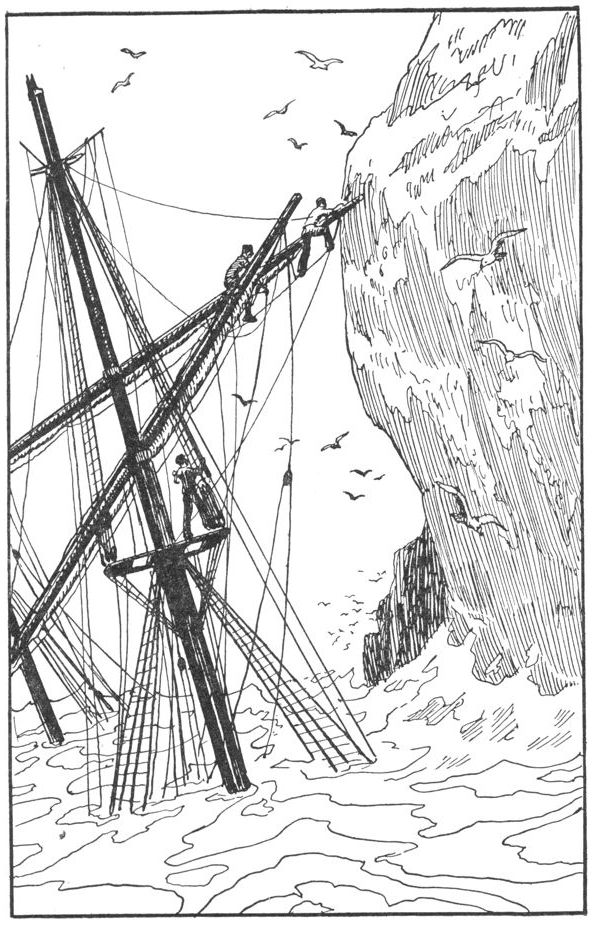
THE LAST OF THE “DUNDONALD”
On March 18, after several days’ illness, the mate died, and the second mate took command. The mate was given a solemn funeral and buried in the peat on a hill-side. The position of the camp was very exposed, and the men began to look for a more suitable camp-site. This they found in a sheltered hollow on the other side of the island. The winter was approaching, and the men were feeling the cold acutely. In addition to this the birds were leaving, and anxiety for the food-supply began to grow. As a protection against cold the resourceful sailors built ‘houses’ six feet square and six feet deep in the ground, with a wall of earth raised two feet above the tussock grass. With a pole laid across to support twigs and grass, a fairly comfortable shelter was assured for the winter. As they had no tools the digging was done with sticks and their own hands. When they became more skilled at hunting they were able to include albatross in their fare, as well as an occasional seal.
All this time another, a larger, island was in sight, and as the winter had now come the castaways decided to try to reach this island. They built a boat of gnarled scrub covered with canvas. The needle for sewing the canvas was made from a sharp bone from a bird’s wing. In this boat two men were able to reach the other island. They returned after twelve days and brought reports of wild pig, but no food depots. On October 17 the third mate and one man went over. They lost their canvas boat in the surf on landing, but shortly after saw a sign which read, “4 miles to depot along the beach.” At the depot they found a shed housing a ship’s boat. With this boat they were able to fetch their companions over. Their sufferings were behind them. In the depot were food, blankets, and clothes, with a gun and cartridges, and it was here the Hinemoa discovered them five weeks later.

FIRE ON THE “HORNET”
The sixties of the last century are notorious for their number of shipwrecks. The papers of the day frequently reported the delayed account of some disaster at sea. A typical instance out of many was the wreck of the clipper Hornet, which met with disaster in 1866 in the Pacific. The Hornet left New York near the end of January 1866 with a crowd of passengers bound for the gold-fields of California. The gold-rush had begun seventeen years before, but the flood of fortune-seekers continued for twenty years, and the American shipping companies, profiting by the occasion, put most of their best ships into the trade—emigrants out, gold back. The Hornet made an easy passage down to the Horn, which was rounded without event. Then northward in long tacks until she had crossed the equator, when disaster, sudden and terrible, came on the ship. On May 3 in 112° 10″ West longitude on a calm sea, when the Hornet was drifting idly in the stifling heat of the tropics, the cry of “Fire!” was heard on board. Hardly had the startling news been passed through the ship before a sheet of flame roared from an open hatch, and like some living thing began to eat up the tarred rigging. In a moment the sails were alight, and then the spars, cordage, and canvas aloft became one blazing torch. The cargo consisted of much inflammable stuff, such as kerosene and tallow; and the commander, Captain Mitchell, realized at once that the ship was doomed. The fire had been started by a man who had been sent below with a naked light for a bucket of varnish. He accidentally upset the light into the cask of varnish, and the whole works below flared up as the clumsy fellow dropped everything and sprang to the ladder for his life.
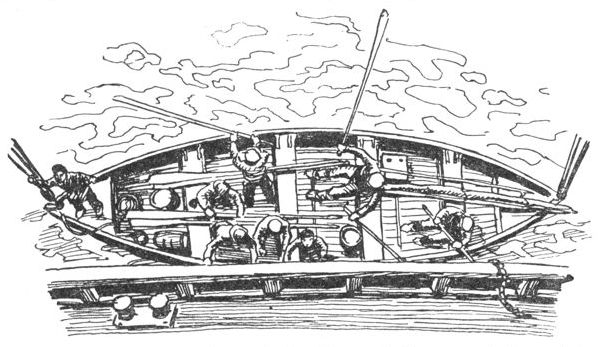
There were thirty-one men on board and three boats, and because of the calm sea all were got away without accident, except that the long boat had a large hole stove in her side. This, however, was patched up with a piece of blanket by the carpenter, though all through the days and nights which followed constant baling was necessary to keep the boat afloat. Sixteen men were divided between the two quarter boats, and the rest, fifteen all told, including the captain and the third mate, got into the long boat. The men stood by the burning ship until she sank, twenty hours after the fire had begun, and every one marvelled that she had kept afloat so long.
Consider the position of these men. They were over a thousand miles from land and in the Doldrums of the Pacific, exposed to the sun in three open boats into which they had tumbled without having had time to make adequate preparations for such a journey. A thousand miles or so to the east lay the Galapagos, an undesirable barren spot on which to land, apart from the difficulty of getting there in the absence of favouring winds. Still farther away to the north-east lay Panama, equally difficult. Away to the westward stretched the lonely wastes of the Pacific, unbroken by land for thousands of miles except for scattered islets of Polynesia. The winds were favourable, but the targets were small and easily missed at such a range.
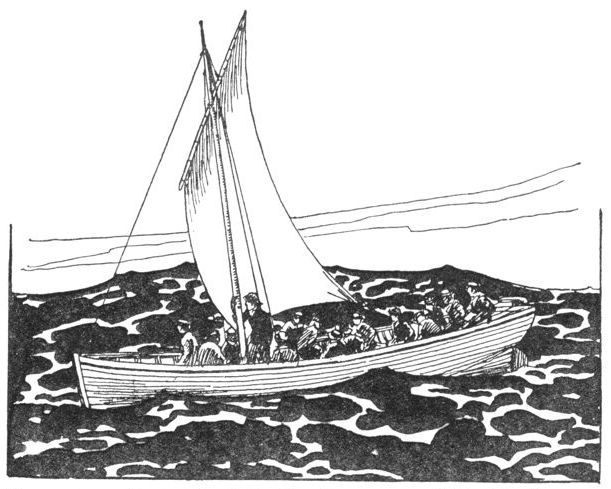
At first the three boats kept together, but after some days they separated by agreement, each crew to look out for itself, and, if picked up, to report the others. The two quarter boats were never heard of again, but the long boat eventually made a landfall, and it is from her crew that we have the story of the shipwreck and the subsequent boat journey. An insufficient quantity of provisions had been thrown into the boats, and these, which included salt pork, ham, hardtack, butter, a few tins of oysters, some raisins, and three bottles of brandy, besides forty gallons of water, had been divided between the boats’ crews. Captain Mitchell reported that after they had left the spot where the ship went down it began to rain, and rained for nineteen days with a few brief intervals of hot sunshine, when the very sea appeared to steam with the heat. Had it not been for the heat the constant rain would have been unendurable, for without the warm days every man would have perished from exposure. But the rain spoiled the food, and as it became impossible to keep the matches dry the solace of smoking (they had a plenitude of tobacco) was denied the men. The boat leaked like a basket, and by the fifteenth day the men were worn out in the effort to keep their craft afloat. The food was finished, and some of the men had begun to eat the leather of their belts and boots. Then a turtle was captured and hauled on board. Among fifteen ravenous men this did not last long, and when the turtle had been eaten the starving men conned the seas eagerly for more of these creatures, but none appeared; and as the scorching days dragged by hope was fading from even the most sanguine hearts. But at last, when it seemed not worth while fighting to live any longer, land was sighted low on the horizon. These were the peaks of the Hawaiian group, but it was another day before the boat was beached. The men had been afloat forty-three days, and when they approached the shore near Honolulu natives swam out through the surf to direct the boat through the breakers. The natives treated the sick men with the greatest kindness, and in a very short time they were completely restored to health, some being in better health than ever they had been in their lives before. And afterward many people instanced this episode as an argument in favour of fasting as a rational cure for most of the body’s ills.
One hundred and sixty leagues from New Caledonia lies the Mellish Reef. Here, on the night of August 12, 1856, the French ship Duroc ran ashore. On a small sand spit, a few feet above the surface of the sea, the passengers and crew took refuge. Provisions and fresh water were secured from the wreck, tents were erected, and the castaways resigned themselves to wait for a chance ship to find them. After thirteen days of demoralizing inactivity it was decided to attempt a boat journey for help. Three boats sailed, two containing nine men each and the largest fifteen men, a total remarkably close to the number of men in the three boats of the clipper Hornet. The captain chose to remain behind on the reef with the remainder of the castaways, but he ordered the men of the three boats to make for the coast of Australia, this being the most likely place to find assistance. On August 25 they sailed away and quickly left the reef out of sight, so low did it stand in the sea. The boats’ crews were soon almost overwhelmed by trouble. The heavily laden boats were constantly shipping water, and a little more freeboard was got by jettisoning every possible thing that could be spared—and much that could not. The boats now rode a little higher in the water, but not high enough, and it was only by constant baling that they were kept afloat. On the fifth day after leaving the reef Cape Tribulation was seen, and here the boats were put in for fresh water; but the natives were threatening, and the seamen lost no time in getting away after filling their water-casks. On September 9 the three boats arrived at Port Albany, only to find it abandoned. They then decided to make for Timor, where they were certain to obtain assistance. Timor, it will be remembered, was the place where Lieutenant Bligh and his fellow-victims of the Bounty mutiny landed after the longest open-boat journey on record. On September 20 the boats were landed at Possession Island, where the casks were again filled. Here the remainder of the food was pooled and scrupulously divided. There were ninety pounds of biscuits, which, rationed to three and a half ounces a day, allowed for twelve days’ food.

CASTAWAYS
After leaving Possession Island there fell a dead calm, and the boats lay on the oily swell, while for two precious days they remained perfectly stationary. To endure this idleness meant death to all, and by a supreme effort the men roused themselves to row. Fear gave them strength. Timor was estimated to be now thirty leagues away. The starved and weakened men somehow managed to row all night, and by daybreak were rewarded by the sight of land. Two days later, four weeks after quitting the reef, they entered the port of Coupang.
And what of the people left on the reef? They had waited until there seemed no hope of hearing from their comrades and then resolutely set themselves to build a boat from the wreckage of the ship. Night and day they worked, and by September 29 they had a 50-foot pinnace on the water, which they appropriately christened La Délivrance. Thirty people, including the captain’s wife and daughter, crowded into her and set sail. They stood across the Coral Sea to the Great Barrier Reef, then, curiously enough, took the same course as the three boats had taken, and landed, all safe, a month later at Coupang, where they heard that an expedition had been sent out to search for them.
When the Tropic Bird,[2] a two-masted labour-recruiting schooner, stood out from Sydney Heads on March 31, 1893, bound for the Solomons, no one on board had a premonition that they were bound for the adventure of their lives, some never to return. The Tropic Bird had a tonnage of 115 and accommodation for ninety-four recruits. Besides Captain Roberts, O’Connor, the mate, Mooso, the cook, an ex-convict, and four white seamen, one being the captain’s son, there was on board Roderick McKenzie, a Government agent. The agents were appointed, as has been said, to see that the natives were fairly treated, and that there was no kidnapping, an abuse of privilege practised by many of the white adventurers in the South Seas before the days of the agents. Besides those already mentioned there was another member of the crew, a Fijian, who was to act as interpreter.
The Tropic Bird cruised among the islands picking up recruits until June 3, when her full complement (ninety-four) had been collected. On the following day, while the loaded schooner was off Guadalcanar, one of the Solomon group, the wind began to blow with increasing force, and the barometer indicated bad weather ahead. The sea had a heavy cross-swell, and from over the islands swept inky-black clouds, rent by frequent flashes of lightning. Every one recognized the signs of an approaching typhoon, and the recruits were driven below, where they were battened down, while aloft all canvas was taken in except the fore staysail, which was close-reefed. Though still daytime, the blackness of night came over the sea, and in the tumult of crashing water, thunder, and utter darkness, the schooner was blown on to her beam-ends while the waves repeatedly washed clean over her. It appeared as if she and her company were doomed, but during a momentary slackening of the wind she swung on to an even keel, and the crew were able to get her hove to. After two hours a definite lull in the wind indicated that the schooner was now in the centre of the cyclone. The barometer was still going down, however, and Captain Roberts prepared for worse to come. The schooner was hove to on the other tack—a difficult manœuvre in the dead calm in the centre of a typhoon—the wheel was lashed down, and as nothing further could be done all hands took refuge in the cabin and resigned themselves to the mercy of the elements. The hurricane now became worse than ever, the force of the wind being strong enough to flatten the seas and prevent them from rising. Night came, hours passed, and then with daylight came the slackening of the hurricane. Through the flying spume Malaita, inhabited by the most savage of the Solomon Islanders, was sighted, and Captain Roberts decided to run in there for shelter. This would give the recruits an opportunity to recuperate, and the crew a chance to fill the water-tanks, which were nearly empty. On June 20 the recruits were landed at Ariel Harbour with a white guard to protect them from attack by the cannibal tribes in the jungle at the back of the beach. Captain Roberts and Mr McKenzie, with three recruits and the Fijian interpreter, went ashore in a boat to get water, leaving the mate and the four men of the crew in charge of the schooner. A number of natives had come on board, but most of them had been sent back into their canvas canoes, though there were still seven of them hanging about the deck when the captain and McKenzie went ashore. On the beach these two were met by a horde of naked blacks, who appeared excited and in a dangerous mood. The boat was left with its bows pointing seaward ready for instant pushing off, while the two white men walked slowly toward the village a few hundred yards from the beach.
The signal for a general attack was made by a native hurling a spear at McKenzie. The latter sidestepped the missile, though his hat was impaled. Captain Roberts instantly turned and shot the native, and disabled another as he and McKenzie retreated to the boat. Without further demonstration they were able to push off and get away, but as they approached the schooner they were horrified to find the decks in possession of a mob of howling savages, who, as the boat approached, met it with a shower of arrows. Miraculously no one was hit, but it was too dangerous to approach nearer to the schooner, and while the captain and McKenzie were discussing what they should do next the question was settled for them by the approach of a fleet of war-canoes from the shore. There was but one thing to do—abandon the schooner and escape out to sea: to stay would mean certain death. Captain Roberts hoped to pick up one or another of the recruiting schooners known to be in those waters. A jury-sail and -mast were made by bending a piece of tarpaulin to a rifle barrel. During the night it came on to blow heavily, and at daybreak the men in the boat were glad to see two schooners, which turned out to be the Dancing Wave and the Flirt. When their two skippers heard what had happened they determined to return with the refugees to Ariel Harbour and recapture the Tropic Bird.
They reached the harbour late the following day, and the Tropic Bird was seen to be still there, but the natives had gone, fled at the sight of the other vessels. The deck of the schooner was a shambles. Dead and mutilated bodies lay about in hideously contorted positions, and there was ghastly evidence to show that the mate had been eaten by the savages. At first it seemed as if every one on the schooner had been slain, but the cook, who had been badly wounded, had escaped below, and presently crawled out of his hiding-place.
After the decks were cleaned up and the remains of the dead solemnly dropped over the side, the recruits on shore under an armed guard were picked up. A conference was held in the cabin of the Dancing Wave to decide how the murderers could be punished, and the property which they had carried off be regained. While the Tropic Bird was being put shipshape by men borrowed from the other schooners the three skippers, accompanied by McKenzie, rowed ashore with a well-armed crew. They found the cannibal village deserted, but were able to recover some of the stolen trade goods, after which they set fire to the village and returned to the schooner. The next day another village was visited by the white men, and a bloody, but unequal, battle took place with the natives. Several were killed and six taken prisoners, one of whom was recognized as the leader of the attack on the schooner. This fellow was summarily executed. On the frontiers of civilization men take justice into their own hands.
On June 28 the Tropic Bird, in company with the other two recruiters, sailed, but during a heavy gale she lost her escorts and shortly afterward ran on to a reef and ground her keel into the coral, where she lay firmly wedged with a heavy list to starboard. The recruits fell into a panic, some leaping overboard, where they were drowned, and Captain Roberts, who seemed to have lost his wits, became so incapable of sane action that McKenzie, the agent, assumed command. The natives managed to launch the only sound boat on board and crowd into her, but McKenzie forced them to return to the schooner, though not until he had shot one of their number to convince them that his gun was loaded and that he must be obeyed. The schooner soon began to pound badly, and to ease the strain the masts were cut away. She was half submerged on a reef that at low tide stood three feet out of the water. When at last the weather moderated the men were set to work building a raft. Captain Roberts had shown himself such a poor leader that McKenzie had again to interfere, and there were frequent disputes between the pair.
On July 4, when the raft was finished, it was found that there was little more than two small tanks of water left, and McKenzie put the party on rations. The captain was determined to take the boat and some provisions and go for assistance, and on July 7, with a few men, he hoisted sail and was soon below the horizon. He had got away just in time, for the Tropic Bird was so battered that she was deemed unsafe, and the men were transferred to the raft. The change brought a good deal of suffering, and McKenzie, who was showing himself to be a resolute and wise leader, set the natives to work to build a breakwater of coral blocks, but not before resorting to threats and even thrashings to make these improvident adult children work. There is no doubt that had it not been for McKenzie the wreck of the Tropic Bird would have been a greater disaster than it was. Though weak himself through the many hardships he had endured, he kept an eye on every one, preventing fights, settling grievances, and now directing the work of building a platform fixed on posts driven into the coral. This was carried out with difficulty and frequent interruptions, for the work could only be done at low tide.
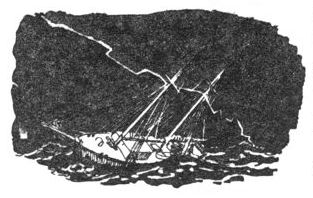
THE “TROPIC BIRD”
On July 29, after they had been nearly a month on the reef, a cutter was seen. McKenzie ordered the badly damaged boat to be launched, and by baling continuously the boat was kept afloat and paddled six miles out, frequently losing sight of the cutter. Finally, after playing hide-and-seek with her and never being able to get close, the discouraged men had to return with their craft nearly sinking and a macabre procession of sharks following them all the way back. They had approached near enough to the cutter to perceive that she was towing the captain’s boat, but evidently the skipper dared not approach near enough in toward the reef to pick up the men. Next day the cutter had disappeared. This bitter disappointment put a great strain on the men’s patience, and McKenzie’s task became more difficult than before. Discipline could only be maintained by constant watchfulness.
An effort to repair the boat met with some success, and when the work was finished the cutter reappeared, and again mysteriously sailed away. On August 4, after a succession of gales, the Tropic Bird broke up, and the castaways were forced to depend for their lives entirely on the frail platform, barely out of reach of the seas. After the schooner sank the natives showed signs of restlessness and of getting out of control. Sickness and madness spread alarmingly, and to make matters worse the food and water were nearly gone. The latter had been supplemented by a little rain caught from time to time, but it was impossible to catch rain-water during a gale without its being spoiled by salt water from the heavy seas which washed over the platform.
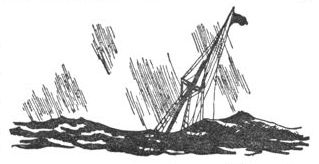
On August 24, nearly two months after the wreck, another sail was seen, and a beacon was lighted. The vessel, which rapidly approached, turned out to be the Brisbane trader Venture, with Captain Roberts, of the Tropic Bird, on board. A boat was seen putting off to the reef, and soon the sick and worn men were transferred to the trader, McKenzie being the last man to leave the reef. Of the natives, eighty out of the original ninety-four recruits were saved, the other fourteen having been drowned or died of sickness.
There is something particularly sad about the wreck of a sailing-ship. Perhaps it is because there is something more human about a sailing-ship than a steamer. And if the ship is lost on her maiden voyage the pathos is even greater.
The four-masted barque Saragossa was such a ship. Brand-new, on her first voyage out from Liverpool, and bound for the Pacific, she was lost on a coral reef of one of the Cook Islands. The ship arrived safely enough at Sydney, and from there went to Newcastle, N.S.W., to take on a cargo of coal for San Francisco. It was during the passage to San Francisco, when she had made about a third of the distance, that the disaster occurred. She struck the coral reef in the dark, and the shock immediately brought down the topgallant mast and the top-mast, leaving only the lower masts and jigger standing. The pounding of the stricken ship was terrific, and the crew, who had gathered for safety on the sacred poop, were nearly washed overboard by the heavy seas. Daylight showed the beach to be about sixty yards away, but those intervening yards might have been a mile, so rough were breakers. Meanwhile a crowd of natives and a few whites had gathered on the shore, where they watched the efforts of the sailors to get a line across. It was hours before they succeeded with a lifebuoy and a light line. By means of the line a hawser was hauled from the ship to the beach, and a breeches-buoy was rigged up with what material they could find. By means of this rather crazy contraption, which dragged the men in the sea as the barque rolled, every one safely got ashore during the day. The poor Saragossa was a total wreck, and the crew were really lucky to escape as they did. The natives treated them with the greatest kindness, and entertained them royally until a trading steamer called at the island and took them back to Australia. This happened in the summer of 1904.
The foregoing accounts concern the misfortune of lone ships and their crews; but here is the story of wholesale disaster in which, out of a harbourful of ships, only one escaped. I refer to the hurricane that visited Apia, in Upolu, Samoa, in March 1889, when H.M.S. Calliope, steam corvette under Captain Kane, as narrowly avoided disaster as it was possible to do.
In the harbour of Apia lay a miscellaneous collection of British, American, and German men-of-war; the American and German ships being there to land armed parties to prevent fighting among the natives, and the Calliope being present to watch British interests. The shallow harbour of Apia, hemmed in by coral reefs, is but 800 yards long, and at the time of the hurricane was crowded with shipping. Besides half a dozen merchantmen and a number of smaller craft, there were at anchor the U.S.S. Trenton, steam corvette of 3900 tons, the largest of her fleet and under the command of Rear-Admiral Kimberley, and the Nipsic and Vandalia, of the same Navy. The Germans had the Olga, 2130 tons, and the two gunboats Adler and Eber.
On Friday, March 15, the barometer was falling so rapidly that normally the ships would have put to sea away from such a dangerous anchorage, but mutual distrust made the respective commanders loath to leave, and when at last the hurricane came it was too late to escape—too late for all but one commander, and that was Captain Kane, of the Calliope. His navigating officer, Lieutenant Pearson, suggested putting to sea, but Kane wished to hang on. He ordered the top-masts struck, the yards sent down, and steam raised, in order to ride out the fast-approaching hurricane. Night came on, pitch-black, and by midnight it was blowing a full gale, with the barometer still falling and the wind increasing. In the darkness of early morning the crash of a collision between two merchantmen was heard above the roar of the storm, and by the lights of two of the German ships it could be seen that both vessels were dragging their anchors. The Calliope herself was slowly steaming ahead to ease the cable, but despite this was being steadily forced to leeward. By five in the morning a full hurricane was blowing, and the Calliope was now dangerously close to the reef. Steam had been raised in all six boilers and the sheet anchor let go, but seemingly without any appreciable effect. About this time the Eber was thrown broadside on to a reef, where she slipped off into deep water immediately and sank with the loss of seventy-six out of her crew of eighty. At daylight the Trenton was seen to be near the harbour entrance, but all the other surviving vessels had drifted toward the reef at the upper end of the harbour. The Nipsic was badly damaged, and, to save loss of life, the captain cleverly ran her ashore on the sandy beach, though unfortunately eight men were lost when a boat was lowered to carry a line ashore. At eight o’clock the Adler’s steering-gear broke, and what followed is realistically told by Robert Louis Stevenson in his Footnote to History.
As she rose on the fatal wave, her moorings were simultaneously slipped; she broached to in rising, and the sea heaved her bodily upwards and cast her down with a concussion on the summit of the reef, where she lay on her beam-ends, her back broken, buried in breaking seas, but safe.
He wrote of her after the storm:
In still weather, under a cloudless sky, in these seasons when that ill-named ocean, the Pacific, suffers its vexed shores to rest, she lies high and dry, the spray scarce touching her—the hugest structure of man’s hands within a circuit of a thousand miles—tossed up there like a schoolboy’s cap upon a shelf, broken like an egg; a thing to dream of.
Most of the Adler’s crew were rescued from the reef the next day. Just before she was wrecked the Calliope began to drift toward the reef, but swung clear, only to be faced with another peril. The Olga and Vandalia were dangerously close; the Olga, in fact, drifted down on to the Calliope, but the latter’s foreyard lashed to the deck athwartships acted as a fender and took most of the impact. Heavy seas swept continually over the British ship, and she lost six boats from this cause. Clearing the Olga, the Calliope now came into collision with the Vandalia, which was drifting out of control, and the former had her bowsprit carried away, while the American vessel had one of her quarter galleries smashed in. As the Calliope was now wallowing between the Vandalia and the reef, which formed a giant pair of nutcrackers, Captain Kane decided to attempt an escape from the harbour. It was a great hazard, but he took it. The firemen were ordered to stoke for their lives, the steam-pressure was raised beyond the safety limit, the last cable was slipped, and the Calliope faced the hurricane alone, unaided by mud-hooks. Half buried in the steep seas, she began to gain a little, and at the end of an hour she had advanced half a mile in the face of the hurricane. At the harbour’s mouth she just scraped by the Trenton, whose fires had been extinguished by the seas. Once beyond the harbour the Calliope slowly gained an offing, and, though crippled, rode out the storm without further mishap.

THE “ADLER” ASHORE
Three days later she steamed back to Apia to find the harbour, the reef, and the beaches strewn with wreckage and the smashed and stranded hulks of the six fine warships that had so proudly ridden to their anchors and displayed their countries’ ensigns three days before. The Vandalia had lost forty-four men. She and the Nipsic had sunk in deep water. The Olga lay high and dry on the beach; the Trenton showed her upper deck above the sea, and the Eber and Adler were also wrecked.
As soon as the hurricane permitted of rescue work being carried out the natives rushed to help their enemies, the very Germans who had so recently been fighting against them.
All this happened in 1889, and many of the Calliope’s company are still living. The Calliope herself is doing duty in her old age as a drill-ship at Newcastle-on-Tyne for the R.N.V.R. Her battles with the sea are over, but others have taken her place; and as long as ships sail the seas there will be tales of peril and disaster to tell to future generations.
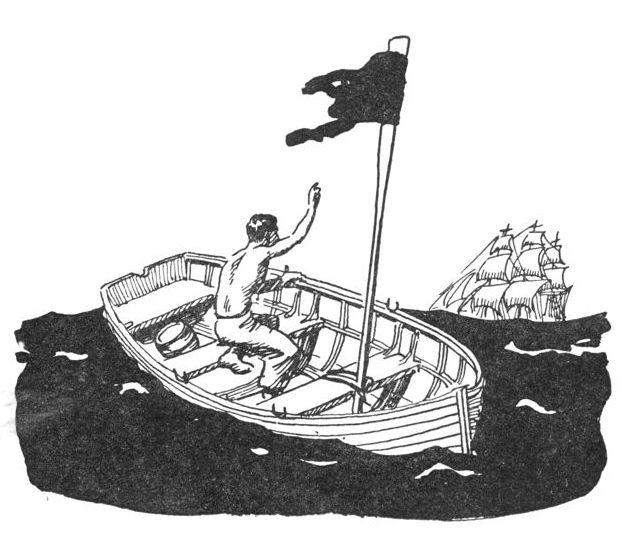
|
November 12, 1783. |
|
The Wreck of the “Tropic Bird,” by Frank Burnett (Sifton, Praed, and Co.). |
Abba Thulle, King, 220-221
Abyssinia, liner, 152
Acapulco, 14
Acushnet, whaler, 157, 158, 160
Adventure, Cook’s ship, 51
Ahab, Captain, 162
Albatross Deep, 215
Aleutians, the, 90
Andrew Jackson, clipper, 148
Antarctic Circle, 51
Antelope, East Indiaman, 217
Antofagasta, 200
Apia, hurricane at, 244
Archibald Russell, barque, 151
Ariel Harbour, Malaita, 239
Arva-root, 189
Asama Maru, liner, 156
Astrolabe, frigate, 125
Auckland Island, 222
Austral Islands, 120
Balboa, Vasco Nuñez de, 13, 32
Bald Eagle, clipper, 149
Baltimore, 172
Bamfield, 14
Banks, Sir Joseph, 48
Batavia, 39
Batavia, liner, 152
Beachcomber, 191
Beatrice, barque, 151
Beaver, coasting steamer, 140
Bêche-de-mer, language, 177-180
Bêche-de-mer, sea-slug, 180
Bering Sea, 52
Best, Captain George, 200
Bismarck Archipelago, 42, 83, 85-86
Blackbeard, 55
Bligh, Lieutenant William, 88, 112, 234
Blossom, ship, 92
Bougainville, Louis Antoine de, 42, 45, 125
Bougainville, 86
Brisbane, 212
Briton, ship, 92
Brooks, Lieutenant, 78
Buena Esperanza, 70
Burns-Johnson fight, 172
Byron, Captain John, 42
C. B. Pedersen, barque, 151
Cacafuego, galleon, 59, 63, 69
Cadogan, East Indiaman, 81
California, 136
California clippers, 133
Callao, 36
Canadian Pacific Steamship Company, 152
Canal Zone, Panama, 30
Cañete, Marquis de, 72
Cano, Juan Sebastian del, 34
Canton, 131
Cape of Good Hope, 51
Cape Howe, 140
Cape Tribulation, 234
Carnley Harbour, Auckland Island, 222
Carteret, Captain Philip, 42, 45, 90
Casco, schooner-yacht, 162, 165, 167
Caswell, barque, 200-203
Cavendish, Thomas, 67-70
Celebes, 45
Challenge, 132
Chatham Island, 98
Chili, paddle-steamer, 139
Choiseul, 86
Christian, Fletcher, 91
Christmas Island, 119
Cipangu, 40
City of New York, liner, 153
Clark, Captain Arthur H., 136
Clipperton, Captain George, 74, 77, 79, 81
Cocos Island, 82, 100-105, 205
Cocos-Keeling Island, 101, 153
Colorado, steamer, 140
Columbia, paddle-wheeler, 143
Conception, 77
Conception, 80
Cook, Captain James, 38, 47-53, 90
Cook Islands, 243
Cook Strait, 48
Copra, 182-183
Coral Sea, 237
Cortez, Hernandez, 34
Coupang, 237
Creesy, Captain, 135
Cross, Captain, 224
Cruise of the “Snark,” The, 172
Cumberland Bay, 99
Cygnet, trader, 40
Dalgarns, Captain, 224
Damien, Father, 117-118
Dana, R. H., 144-146
Dancing Wave, schooner, 240
Dangerous Archipelago, 119
Darwin, Charles, 97
Davis, John, 42
Declaration of Paris, the, 55
Dirigo, barque, 172
Disappointment Island, 226
Duchess, 74
Dugong, 21
Dundonald, barque, 226
Dutch East Indies, 38
Easter Island, 92-96
Easter Island hieroglyphics, 193
Ebb Tide, The, 169
Eber, gunboat, 245
Ecuador, 174
El Dorado, 32
Elizabeth, Queen, 59
Empress of Asia, liner, 153
Empress of Australia, liner, 154
Empress of Canada, liner, 153
Empress of China, liner, 153
Empress of India, liner, 152
Empress of Japan, liner, 152
Empress of Russia, liner, 153
Empress of the Sea, clipper, 149
Endeavour, Cook’s ship, 47, 48
Entrecasteaux, J. A. B. d’, 88
Essex, U.S.S., 98
Falkland Islands, 42
Falmouth, sloop, 147
Farallone Islands, 145
Fayaway, 159
Flirt, schooner, 240
Flying Cloud, clipper, 135, 148, 149
Flying Fish, clipper, 149
Flying Scud, schooner, 224
French Pass, 191
Friendly Islands, 123
Galapagos Islands, 82, 96-98, 232
Gambier Islands, 119
Garthpool, barque, 150
Garthwaite, Sir William, 151
Gauguin, Paul, 126-127
George Thompson, ship, 149
Gerbault, Alain, 107 n.
Gilbert Islands, 47, 82, 85, 167
Goethals, Colonel G. W., 30
Gonneville, Benot Poulmyer, Sieur de, 42
Goodenough, Commodore J. G., 87
Goshawk, H.M.S., 202
Grace Hawar, ship, 151
Grafton, schooner, 222
Grant, cutter, 215
Great Barrier Reef, 20-21, 237
Great Republic, clipper, 148
Grenville, Sir Richard, 70, 71
Habu Harbour, 211
Hakodate, 27
Harlech Castle, liner, 104
Harris, Townsend, 28
Hartog, Dirck, 38
Haughty, H.M.S., 104
Hawaiian group, 112-118
Hawkins, Sir John, 70
Hawkins, Sir Richard, 70-72
Heemskerck, 39
Herzogin Cecilie, barque, 151
Hinemoa, steamer, 226
Holy Sacrament, 80
Hong-Kong, 131
Hornidge, second mate, 194
Hula-hula, 184
Hydrographic Office, U.S.A., 148
Invercauld, ship, 224
Iles des Navigateurs, 125
Island Nights’ Entertainments, 170
Islas de Salomon, 86
Isle of Pines, 51
Isles of Spice, 33
Janet, whaler, 203-204
Janet Nicoll, schooner, 167
Janet Stewart, schooner, 198-199
Japan, 26-29
Jesu Maria, galleon, 80
Johnson, Martin, 173
Juan Fernandez, 77, 81, 98-100
Julian, ship, 224
Kahoolawe, 115
Kalakaua, King, 167
Kanakas, 184
Kauai, 115
Keiki, Shogun, 28
Kidnapped, 169
Killoran, barque, 151
Kimberley, Rear-Admiral, 245
Kingsford-Smith, Captain, 211
Kingsmill Islands, 85
Kioto, 28
Köbenhavn, barque, 151
La Boudeuse, frigate, 46
La Capitane, galleon, 59
La Délivrance, pinnace, 237
Labrador, 48
Land of the Assassins, the, 87
Lawhill, barque, 151
L’Étoile, transport, 46
Lee Bo, 221-222
Leeward Isles, 125
Leis, 184
Leonidas, whaler, 206
Lesseps, Ferdinand de, 29
Loch Torridon, barque, 149
London, Charmian, 172, 173, 174
Los Angeles, 146
Loti, Pierre, 95, 109, 127, 157, 170-171
Louisiade Islands, 83
Low Archipelago, 119-120
Loyalty Islands, 83
Lyon, Lieutenant, 211
McKenzie, Roderick, 238, 239-240, 241-242, 243
Macassar, 45
Magellan, Ferdinand, 13, 33-34
Malekula, 87
Mangareva, 119
Manihiki, 84
Maoris, 40
Mar Pacifico, 13
Marblehead, 135
Margarita, merchantman, 79
Mariage de Loti, Le, 171
Marquesas Islands, 84, 127-130
Martha’s Vineyard, 160
Martin Eden, 172
Mary Dear (Mary Dyer, Mary Read), 102
Mas-a-Fuera, 99
Mas-a-Tierra, 99
Master of Ballantrae, The, 169
Maui, 115
Mauna Kea, 116
Mauna Loa, 116
Mauritius, 39
Maury, Lieutenant, 147-148
Melville, Herman, 109, 157-162
Mendaña, Alvaro de, 32, 36-37, 46, 86
Mendoza, Marquis of, 36
Merrit, Dr, 162
Mindanao, 45
Mitchell, Captain, 231-237
Mitsu Bishi Company, 155
Monumental City, steamer, 139-140
Morgan, Sir Henry, 73
Natchez, clipper, 131
Nelson, New Zealand, 191
New Bedford, 133
New Cythera (La Nouvelle Cythère), 46, 125
New Georgia, 86
New Hanover, 86
New Ireland, 45
New Mecklenburg, 86
New Pomerania, 86
Newcastle, N.S.W., 243
Niihau, 115
Nippon Yusen Kaisha, 154
North-west Passage, 52
Northern Pacific Steamship Company, 212
Nouvelle Cythère, La (New Cythera), 46, 125
Oakland, California, 211
Olivebank, barque, 151
Omoo, 160
Ooralong, 221
Opal, H.M.S., 195
Oparu, 120
Otaheite, 46
Otis, Captain, 165
Pacific Mail Company, 140
Pacific Steam Navigation Company, 139
Paepae-hae, 130
Panama, Isthmus of, 29
Panama Republic, 31
Parthia, liner, 152
Patterson, Milton, 212-216
Patteson, Bishop Coleridge, 87
Paumotu Archipelago, 47, 84, 119-120, 166
Paw-paw, 188-189
Payta, 79
Pearl Harbour, Oahu, 116
Pearson, Lieutenant, 245
Pelorus Jack, 191-193
Penrhyn Island, 119
Pequod (Moby Dick), 162
Perry, Commodore, 27
Peru, paddle-steamer, 139
Phœnix group, 84
Physical Geography of the Sea, Maury’, 147
Pieces-of-eight, 59 n.
Pierre, 161
Pilgrim, brig, 144
Poi-poi, 188
Polo, Marco, 33
Port Adams, 195
Port Townsend, Washington, 212
Portage Bay, 215
Porter, Commodore, 98
Powell, Commodore, 99
Privateering, 55-56
Puget Sound, 214
Punta Arenas, 19
Quang-Kai, cruiser, 153
Queenstown, 202
Queequeg, 25
Rarahu, 171
Rarotonga, 120-121
Recovery, 80
‘Recruiting,’ 181-182
Repentance, Hawkins’ ship, 70
Resolution, Cook’s ship, 47, 51, 52
Revenge, Grenville’s ship, 71
Roaring Forties, 17
Roberts, Captain, 237-241, 243
Rogers, Captain, 194, 195, 197
Roggeveen, Admiral Jacob, 51, 95, 125
Romance of the Sea, clipper, 149
Roosevelt, Theodore, 30
Royal Society, 48
Saavedra, Alvaro de, 34
Sacramento, 132
St George, privateer, 41
St John, New Brunswick, 135
St Paul, 91
St Peter, 91
Salem, 25
San Francisco, 132, 133, 135, 145
Sandwich, Lord, 52
Santa Anna, galleon, 68
Santa Barbara, 133
Santa Ysabel, 36
Saragossa, barque, 243-244
Sea Queen, yawl, 207-211
Sea Wolf, The, 174
Seattle, 172
Sharks, 21-22
Shelvocke, Capt. George, 56, 74, 77-81
Shimoda, 27
Sinerago Bay, 195
Slocum, Captain Joshua, 99, 169
Snark, ketch, 172-174
Society Islands, 47, 84, 125-126
Solander, Dr D. C., 48
Solomon Islands, 36, 83, 86-87
Southern Cross, 88, 115, 211-212
Sovereign of the Seas, clipper, 18
Speedwell, privateer, 74, 77-78
Spray, yawl, 99
Staten Landt, 40
Stevenson, Robert Louis, 117, 124, 157, 162-170
Stilwell, William, 98
Success, privateer, 74, 80, 81
Surf-riding, 116-117
Surville, J. F. M. de, 46-47, 87
Sutter, Colonel, 132
‘Taboo,’ 189-191
Tagus, 92
Tahiti, 46
Tasman, Abel Janszen, 38-39, 88
Ternate, 33
Thompson, Captain, 102-104
Thunell, Captain, 215
Tierra Australis del Espiritu Santa, 37, 45, 87
Timor, 234
Tin Can Island, 123
Tokyo, 27
Tokyo Kisen Kaisha, 153
Topaz, H.M.S., 99
Topaze, 91
Torres, Luis, 37
Torres Straits, 37
Trepang, 180
Tropic Bird, schooner, 182, 237-243
Tubuai Islands, 120
Turtle Island, 96
Tymeric, collier, 174
Typhoon, 206
Uigi Island, 199
Ukomok Island, 215
Ukulele, 183
Ulm, Captain, 211
Uraga Bay, 27
Van Diemen, Anthony, 38
Vandalia, U.S.S., 245, 246-247
Vanikoro, 87
Vanua Levu, 88
Venture, trader, 243
Viaud, Louis Marie Julien, 170-171
Villa Roche, Marquis of, 81
Villalobos, Admiral, 218
Viti Levu, 88
Vittoria, Magellan’s ship, 34
Vladivostok, 155
Voss, Captain, 105
Wallace, Captain, 42
Warner, James, 211
Waterman, Captain Robert, 131
Weir of Hermiston, 169
Westport, 203
Westward Ho, clipper, 149
Whampoa, 81
Whitejacket, 160
William Mitchell, square-rigger, 151
Wilson, Captain, 218-221
Windward Isles, 125
Witch-doctor, South Seas, 190
Wrong Box, The, 169
Xora, cutter, 105
Yedo, 27
Yosemite, 143
Young Dick, schooner, 194-197
Ysabel, 86
Zeehan, Tasman’s ship, 39
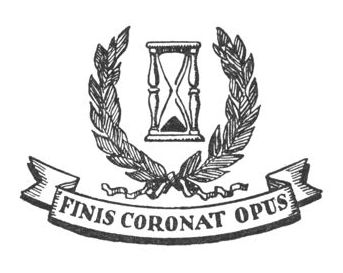
The spelling of Tahitans was changed to Tahitians.
Other minor changes to spelling and hyphenation were made to achieve consistency. Obvious typographic erros were corrected.
Images were repositioned to retain the integrity of paragraphs.
[The end of The Pacific by Stanley Reginald Harry Rogers]